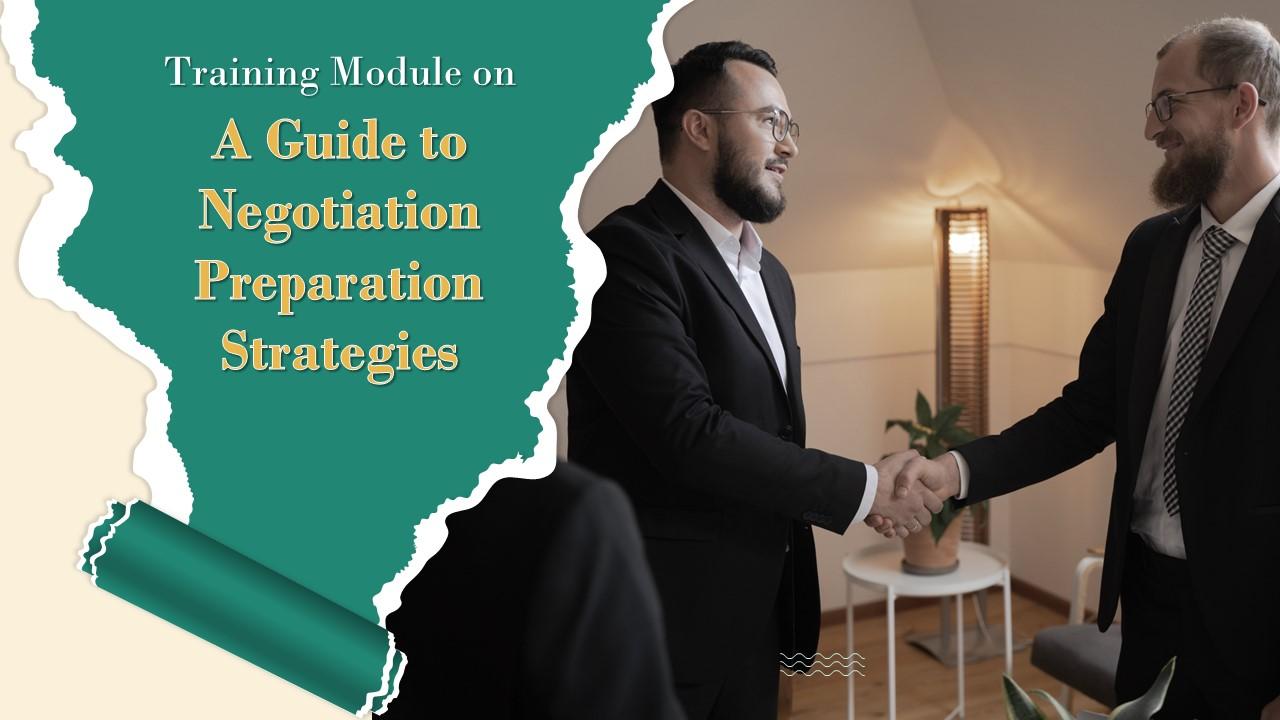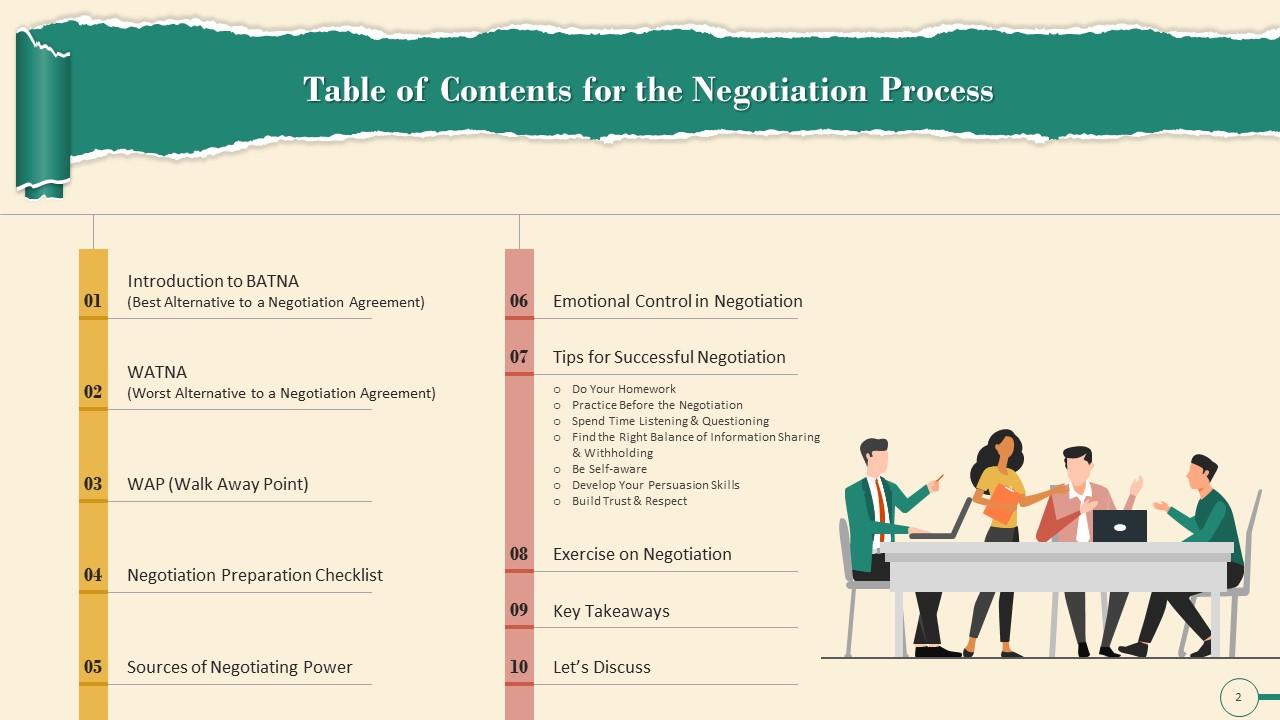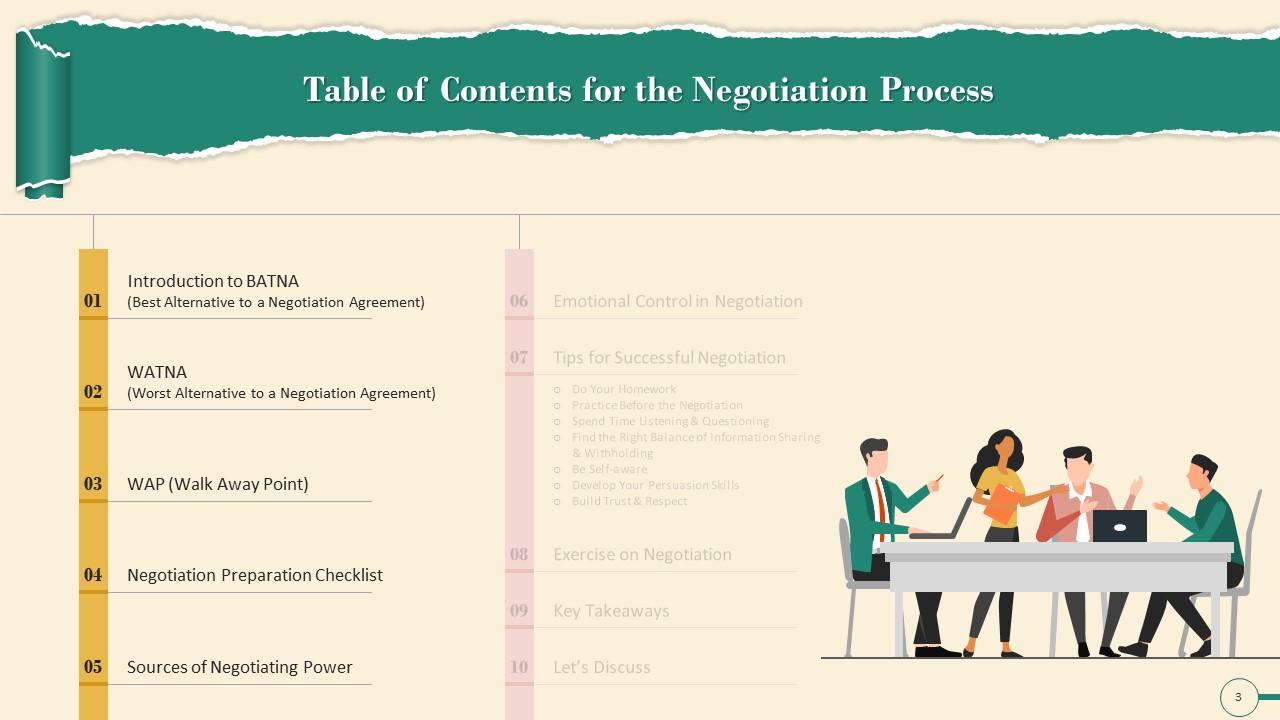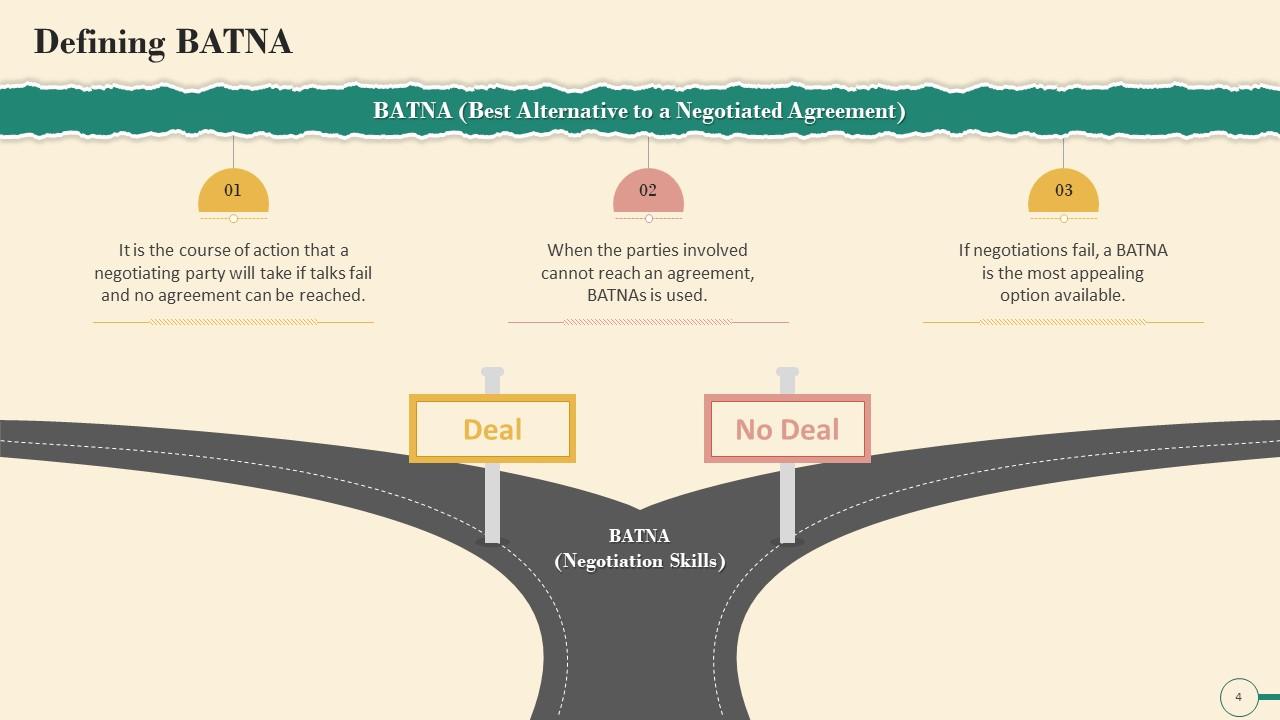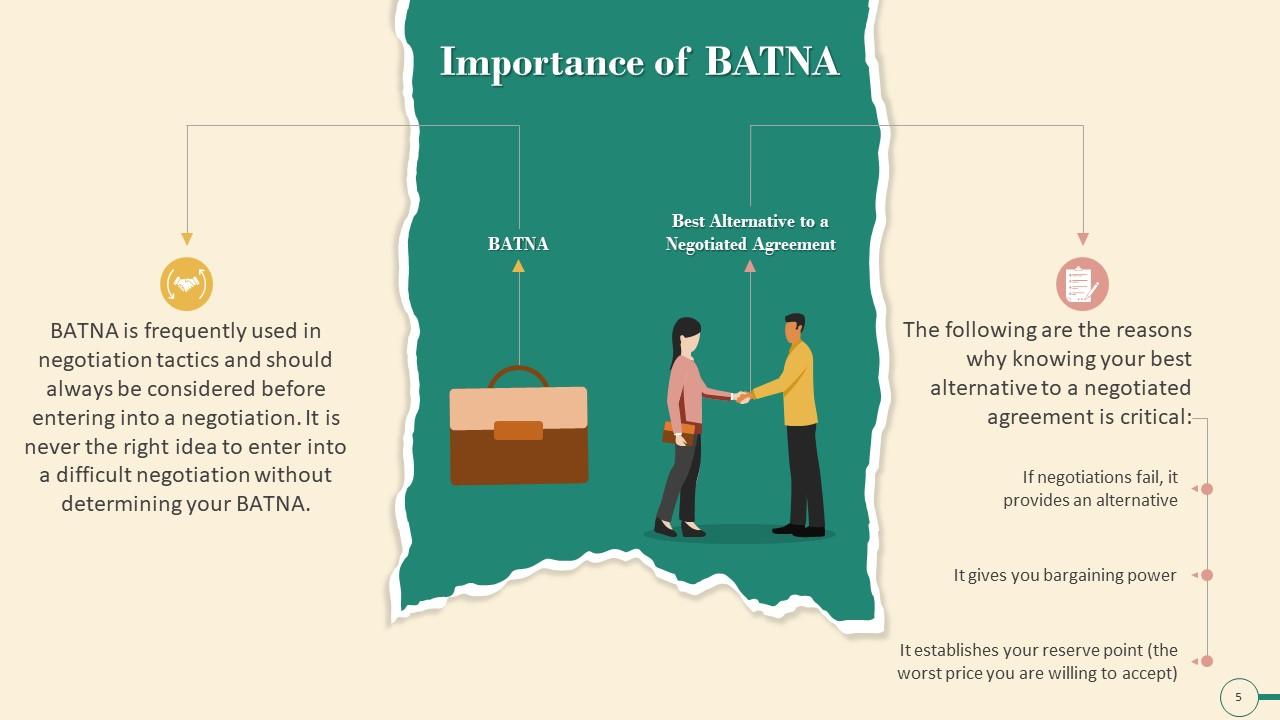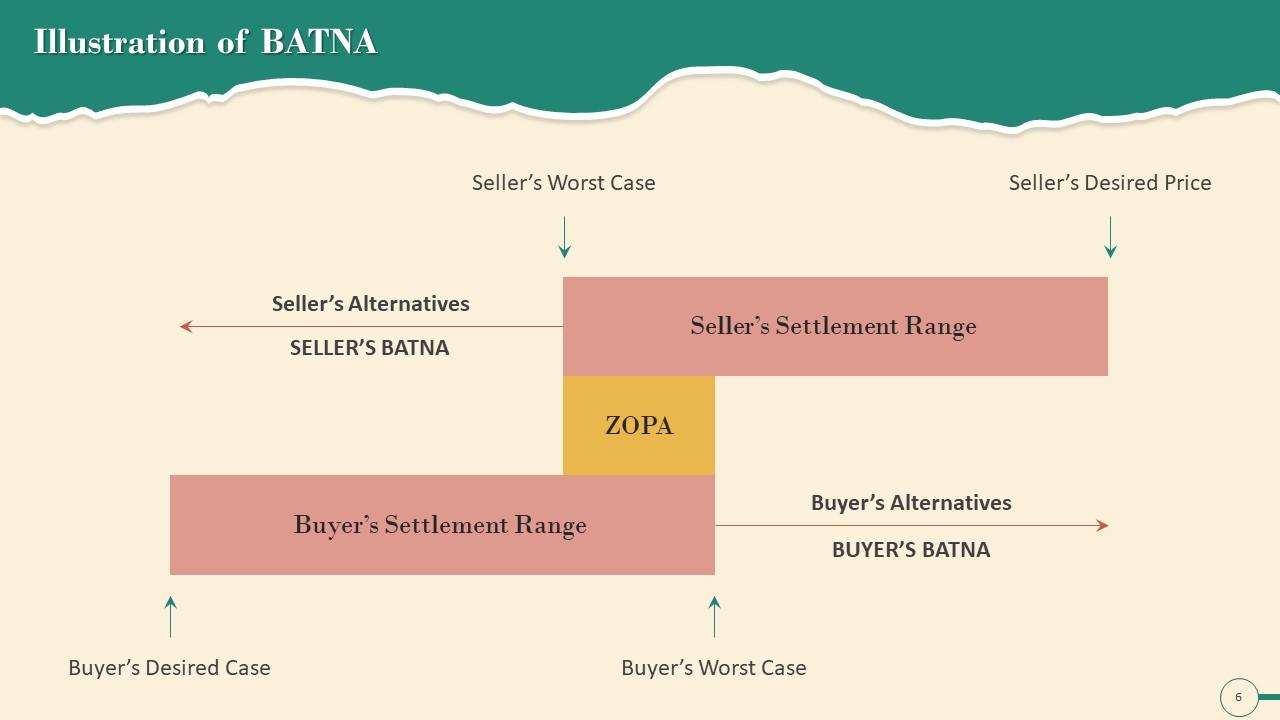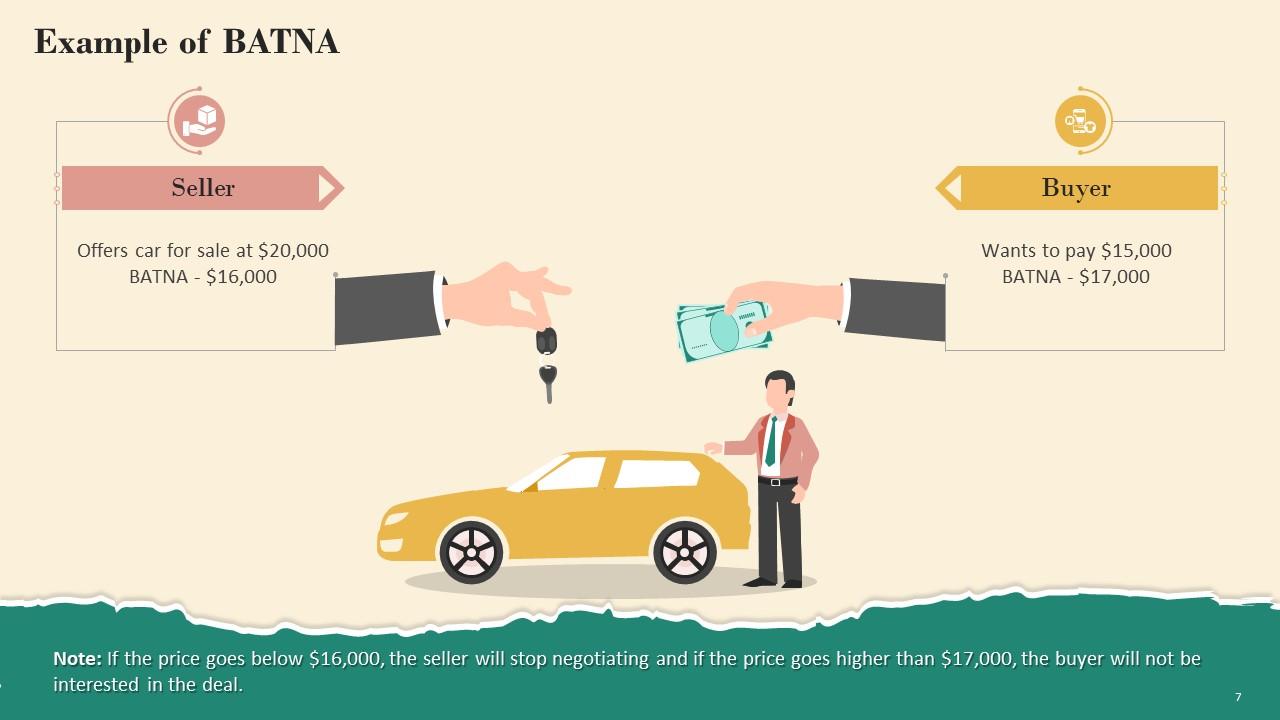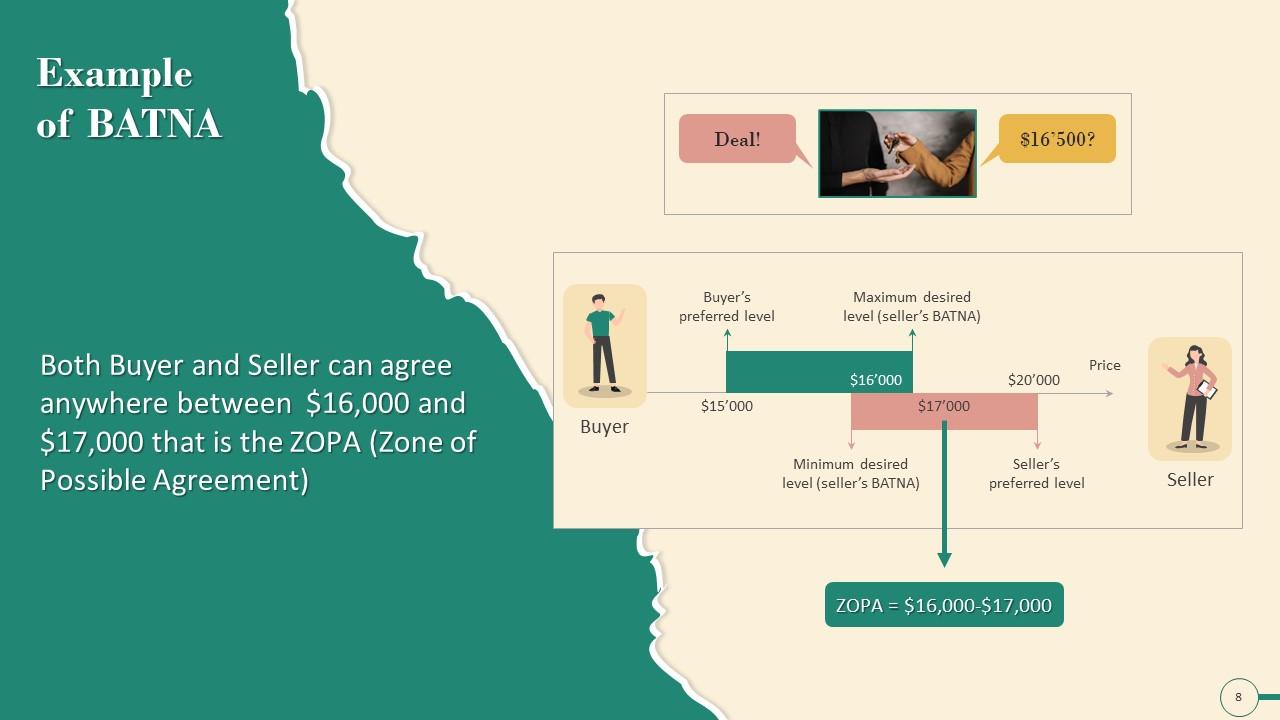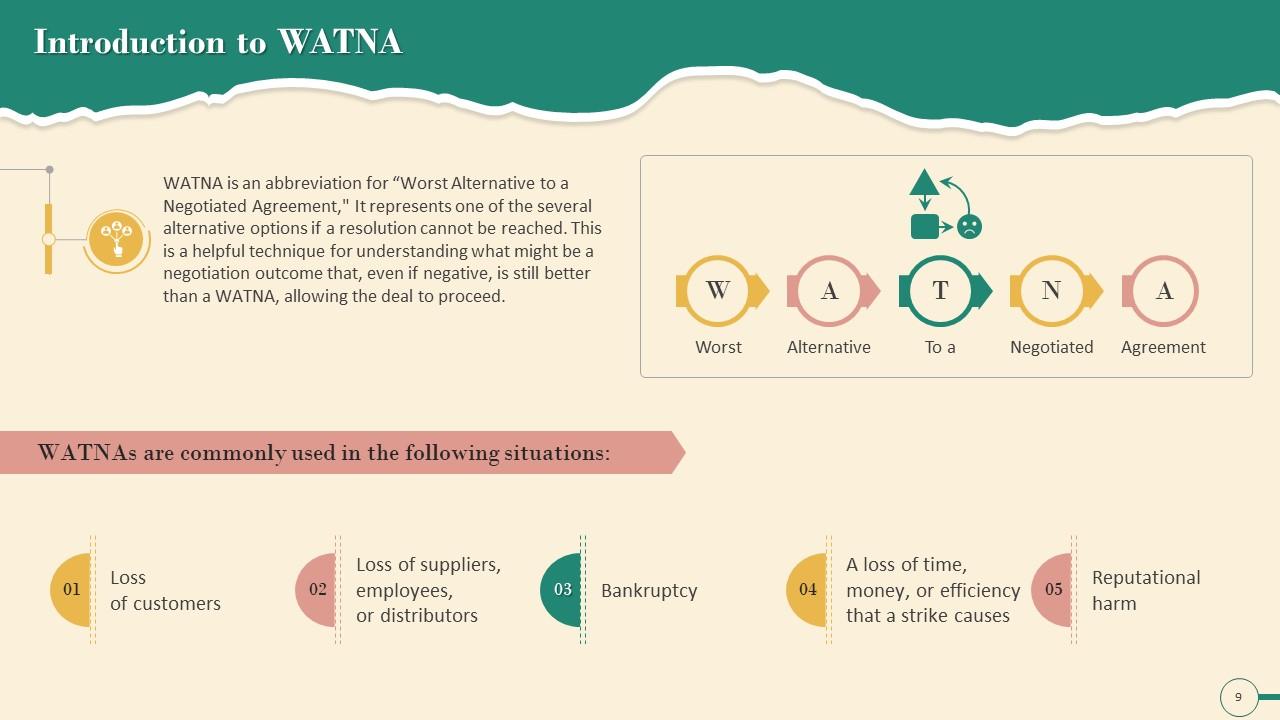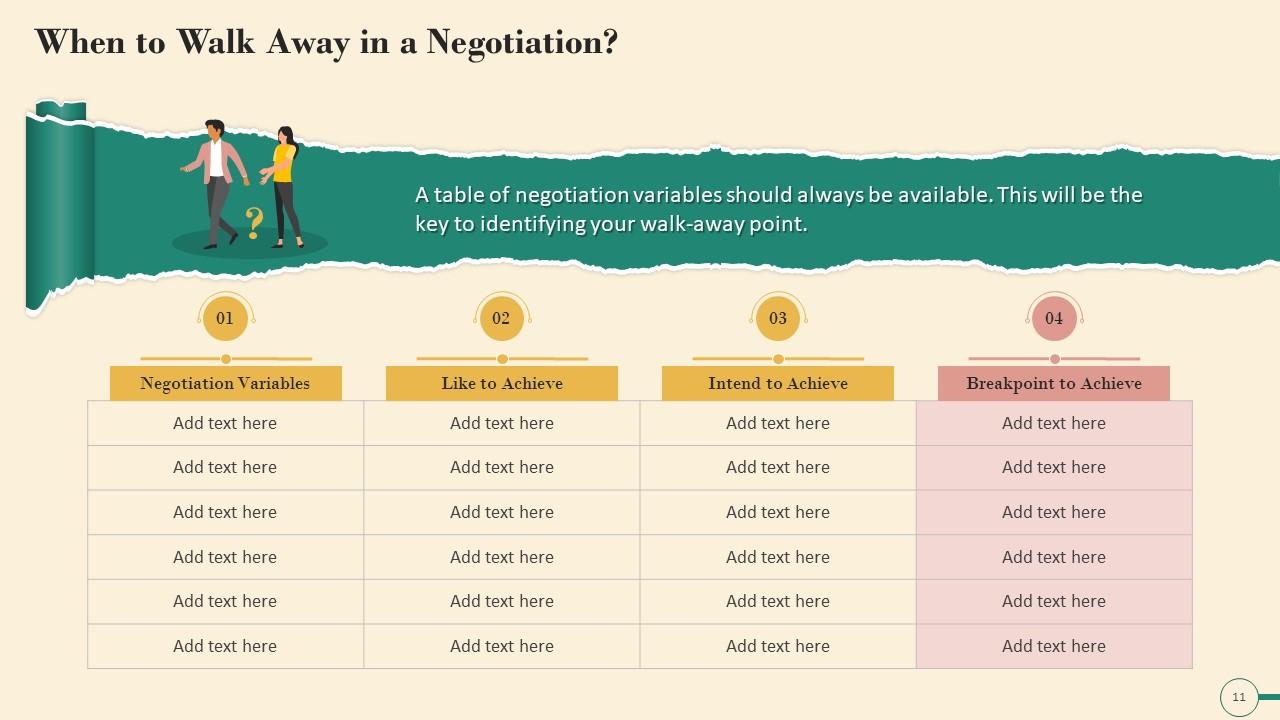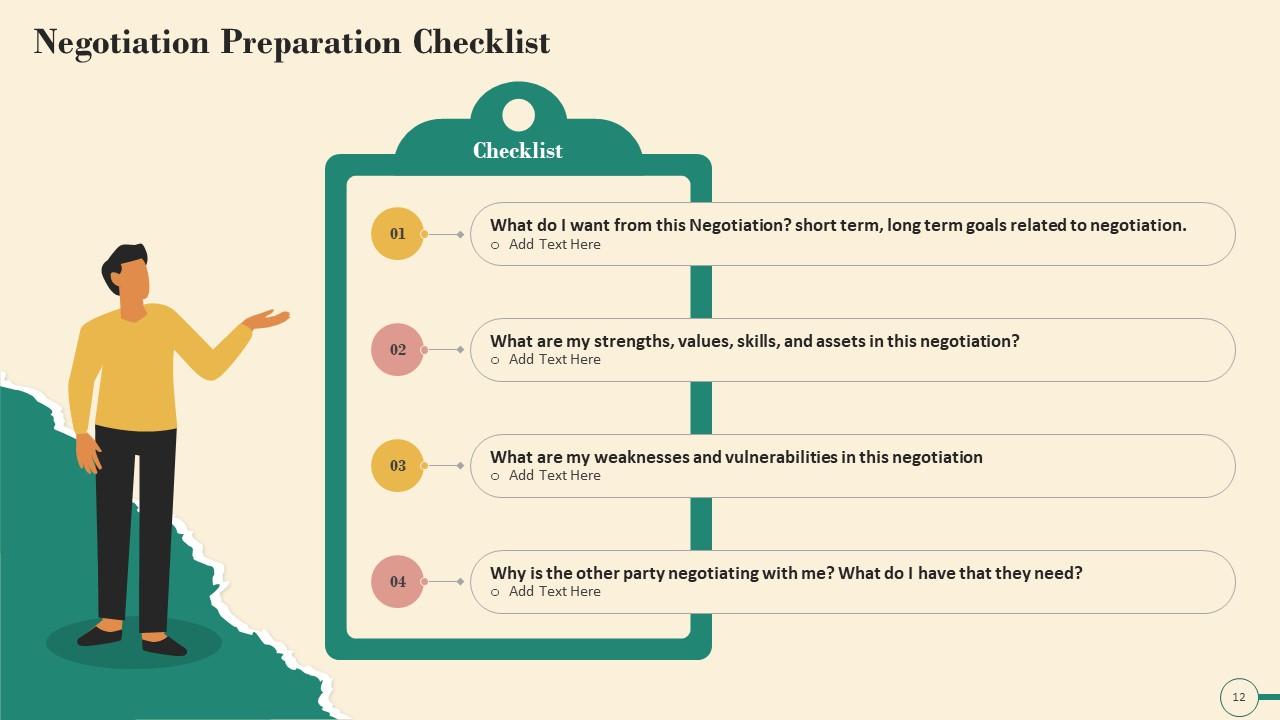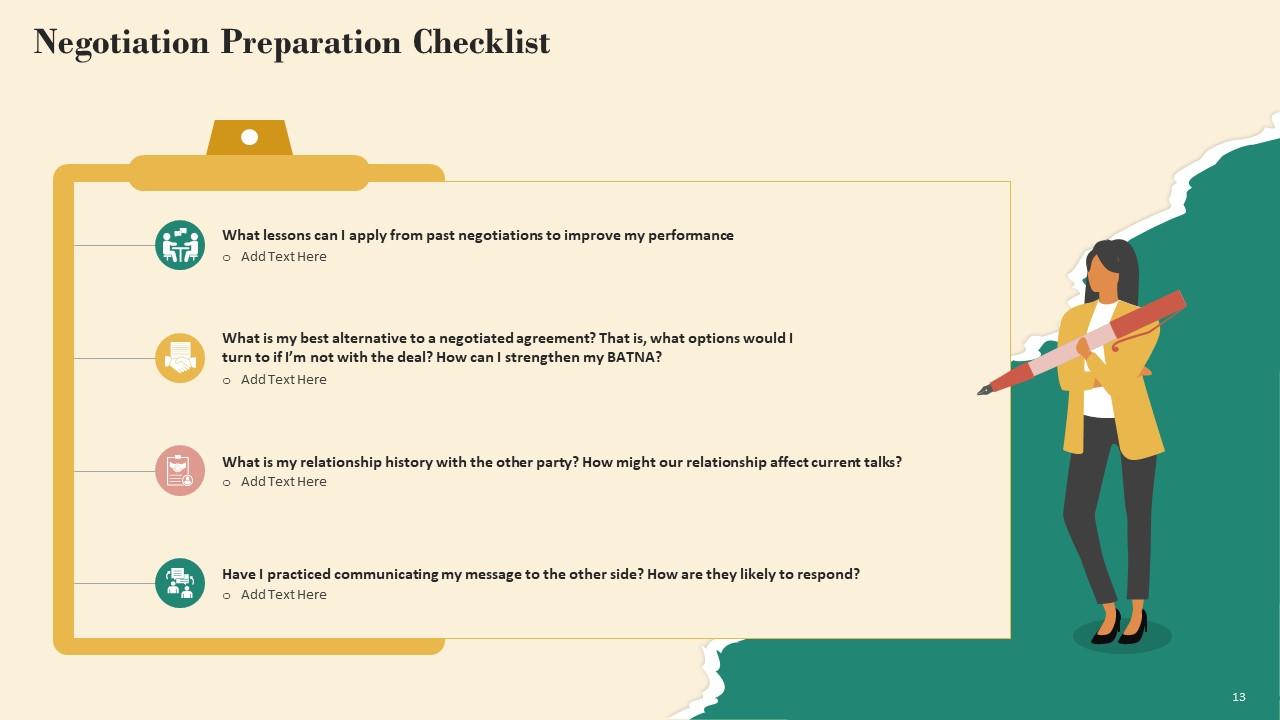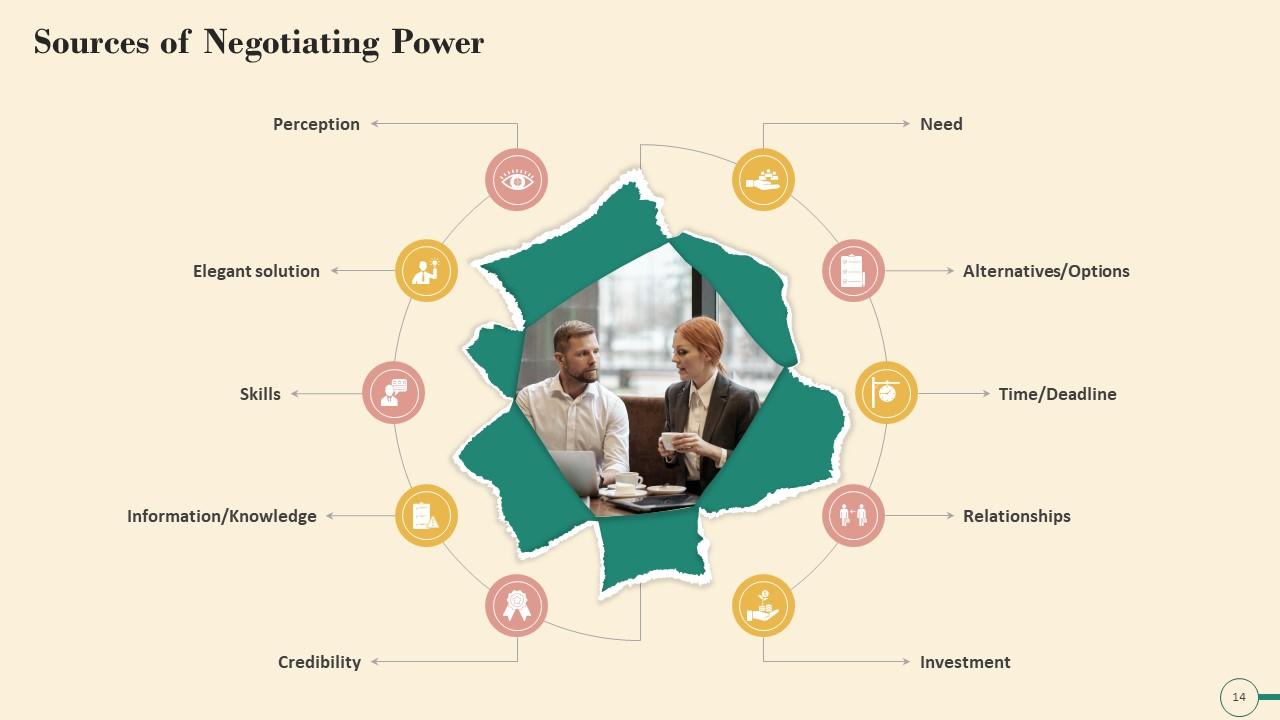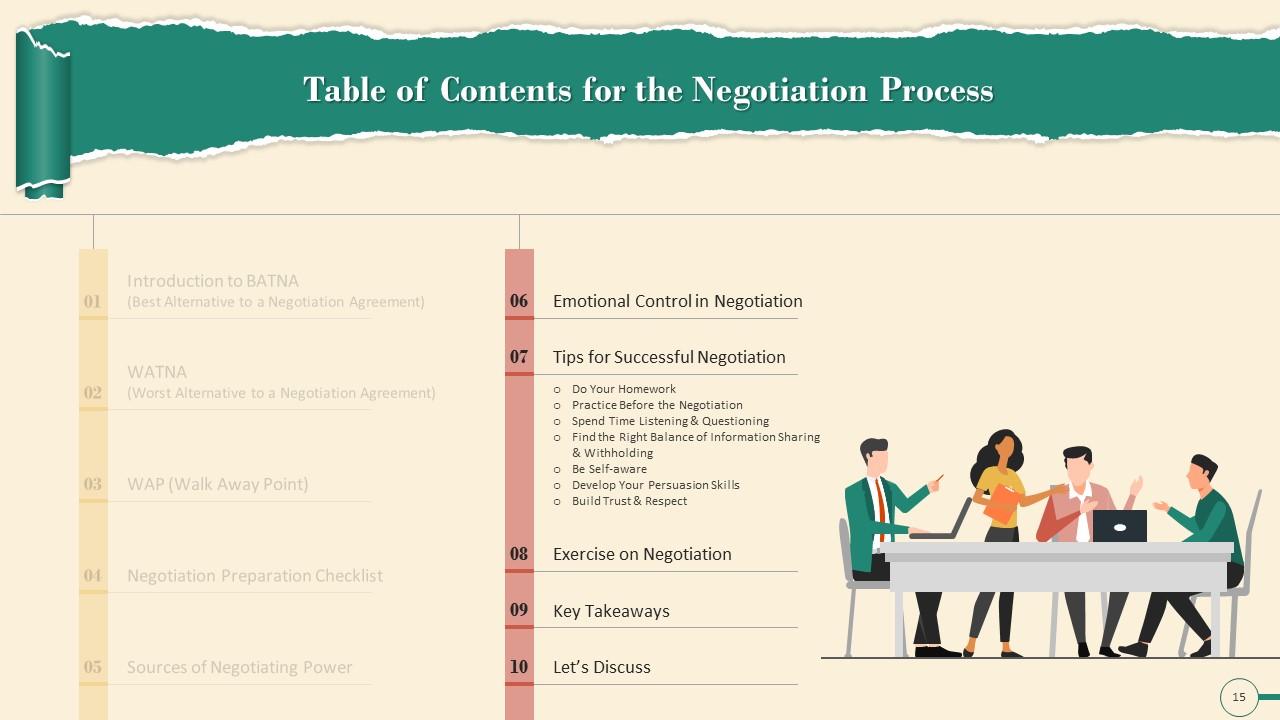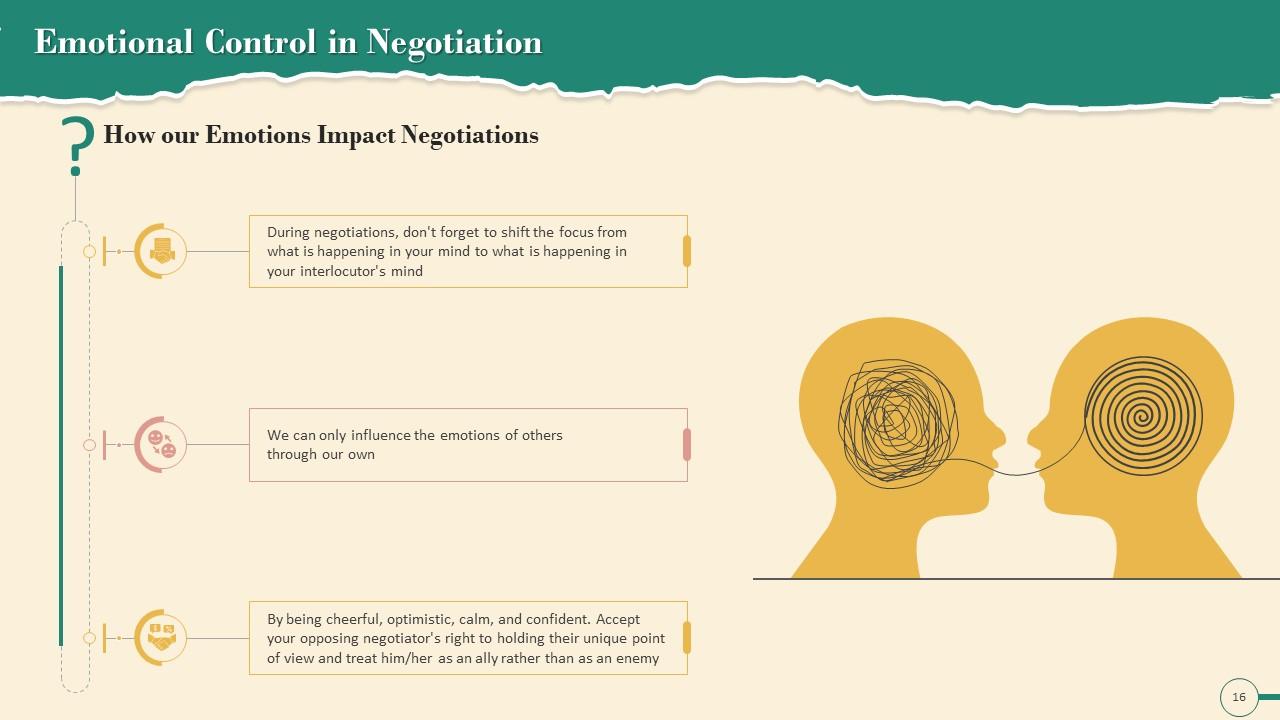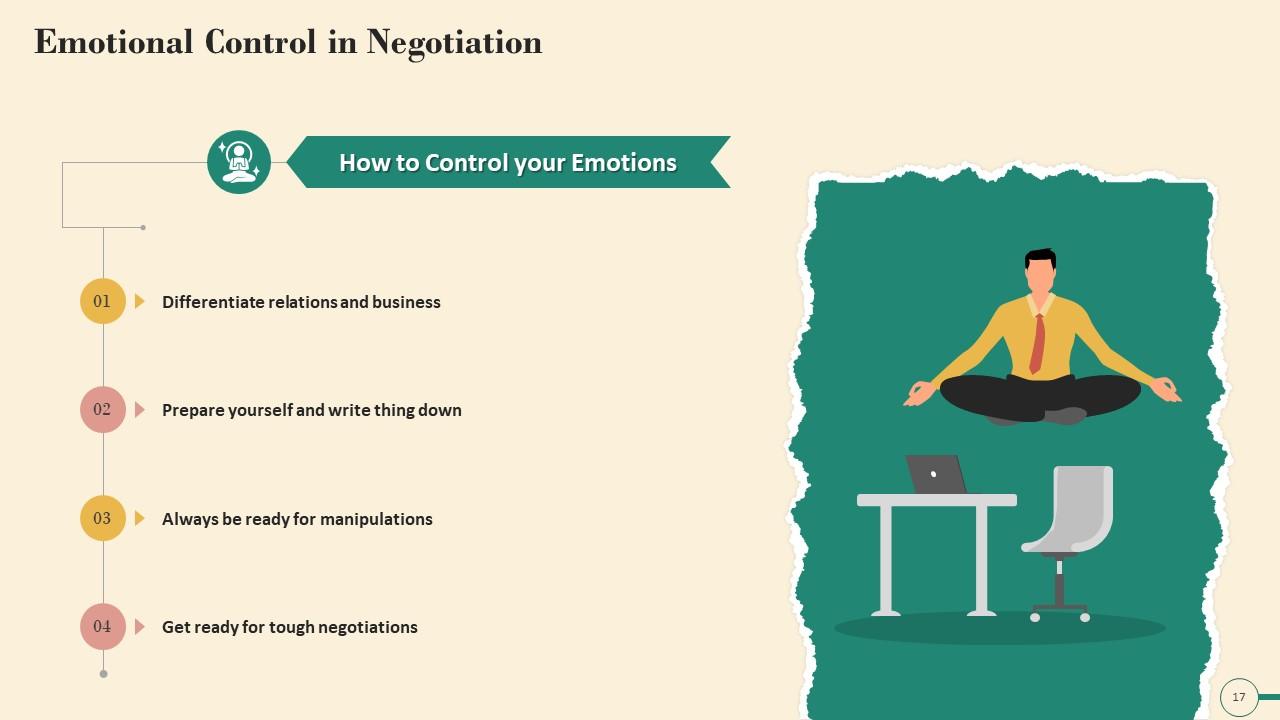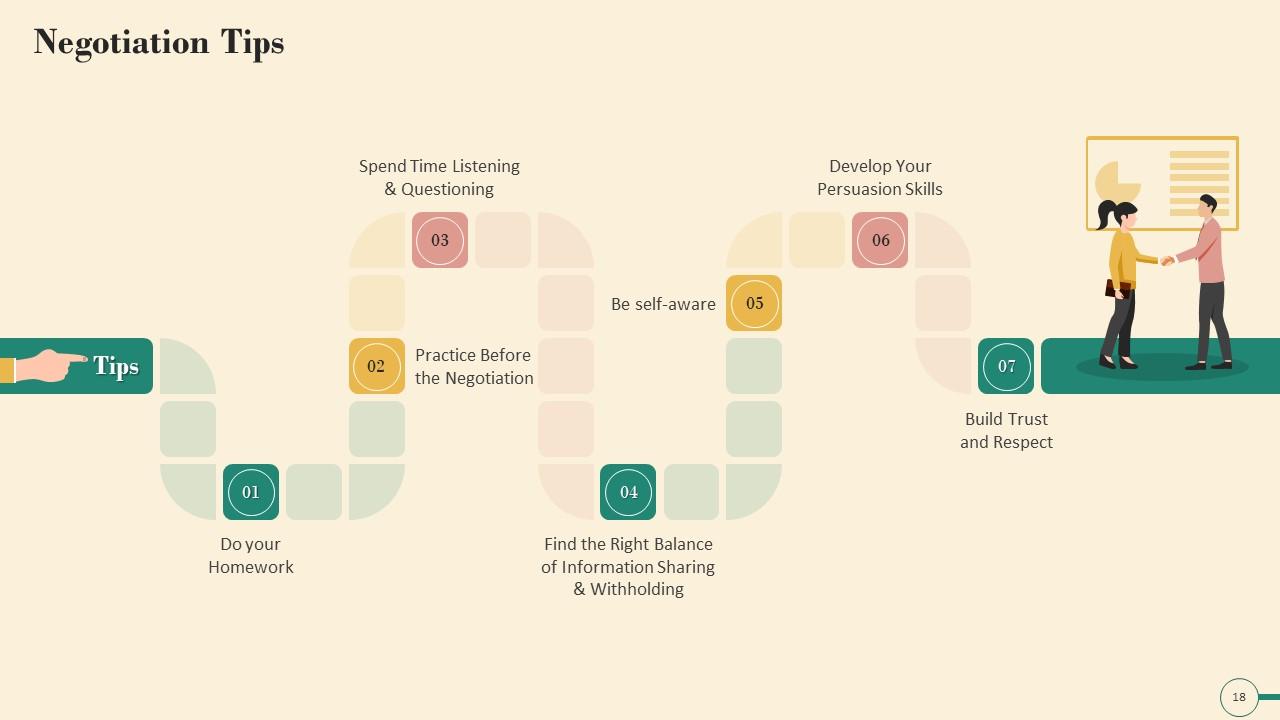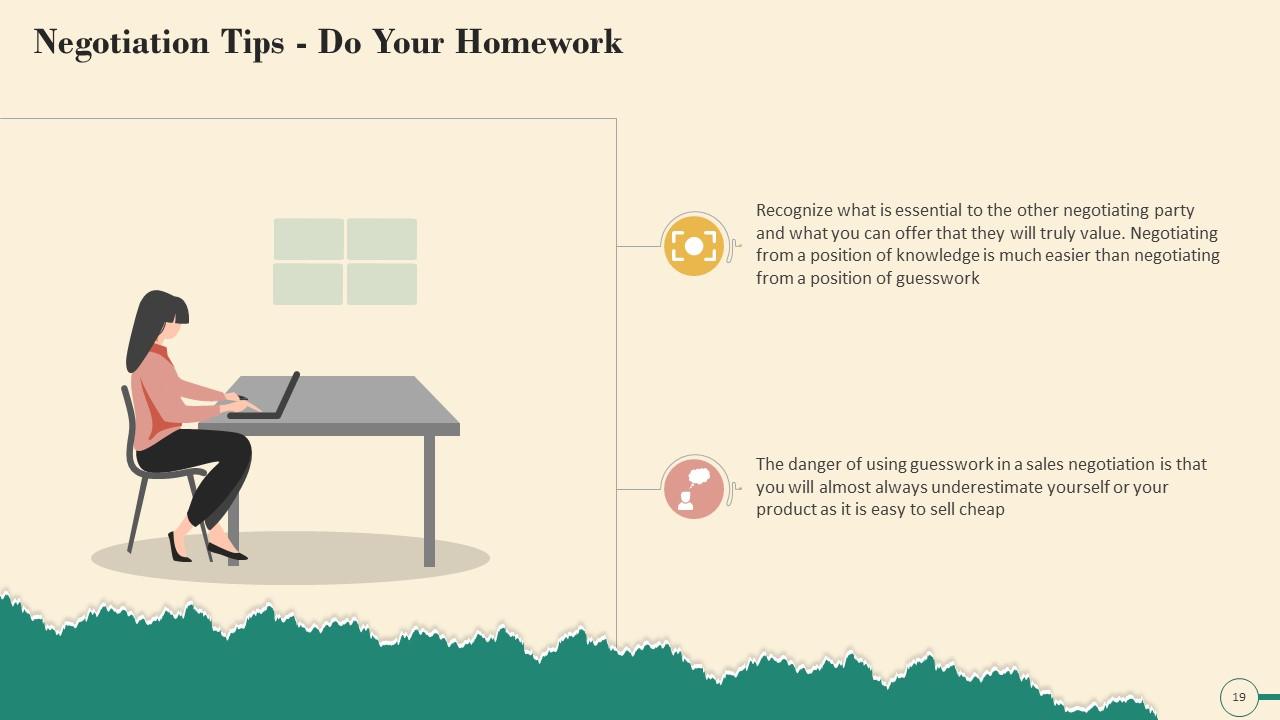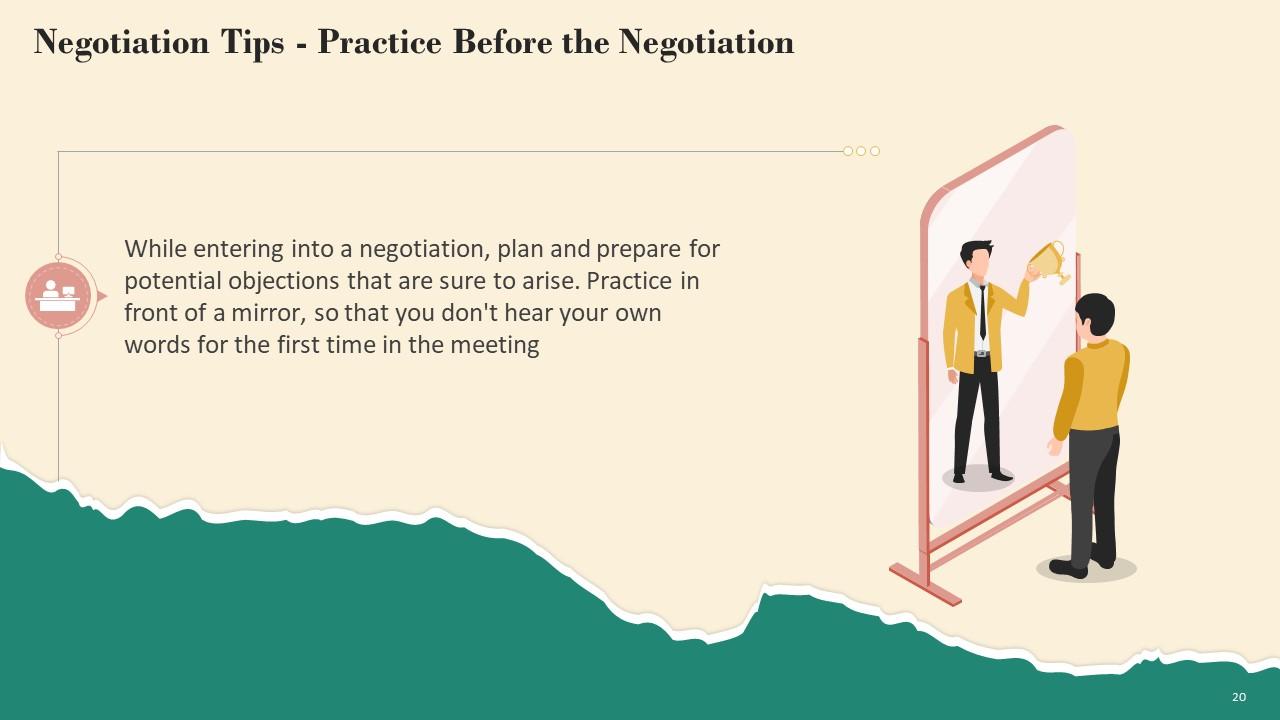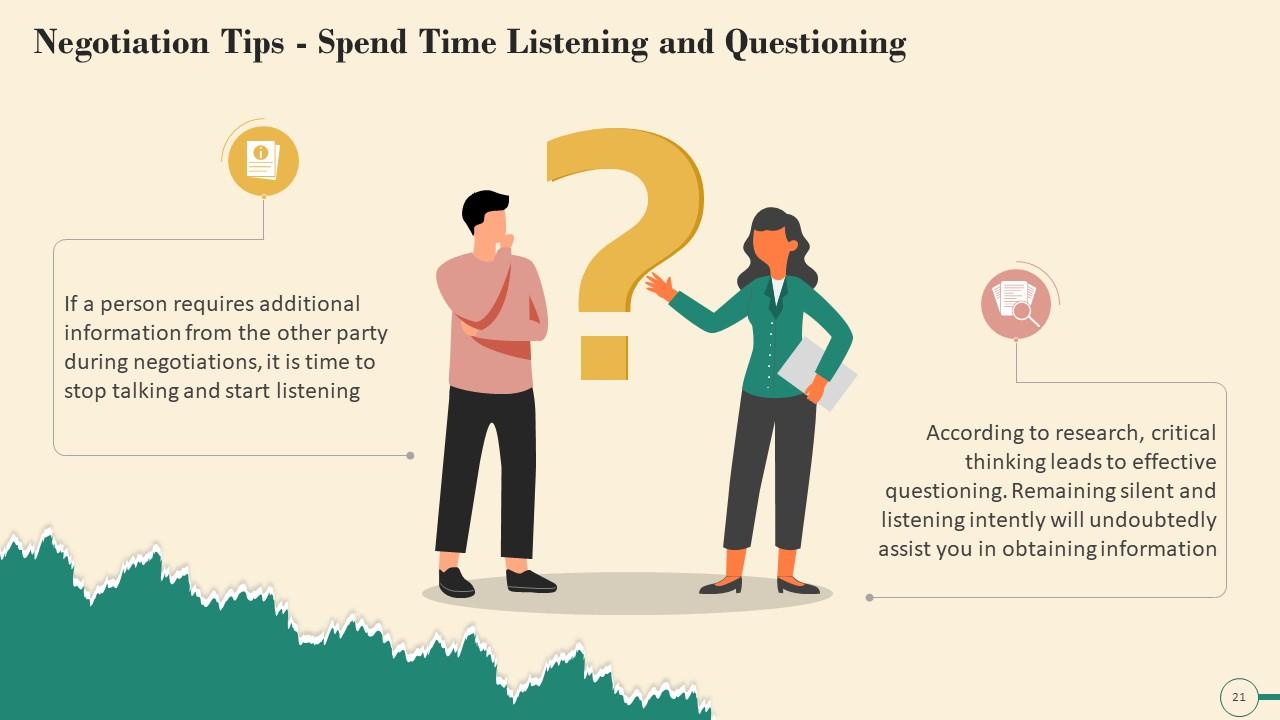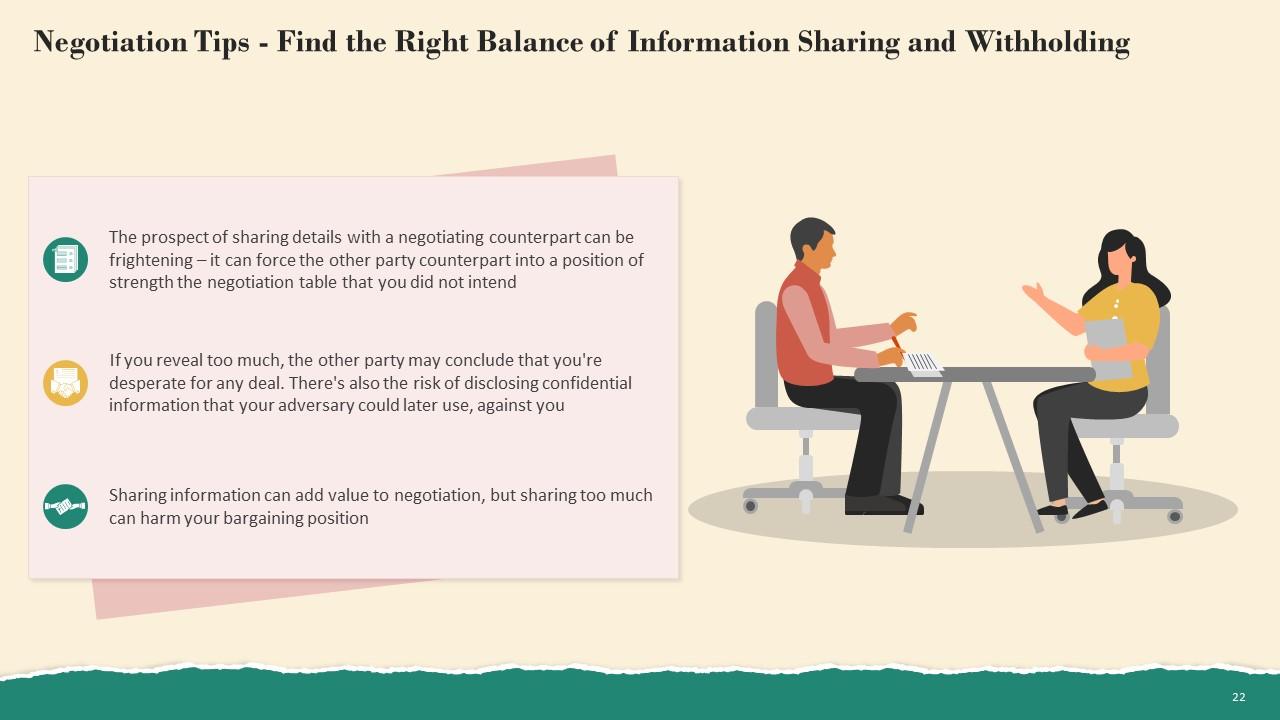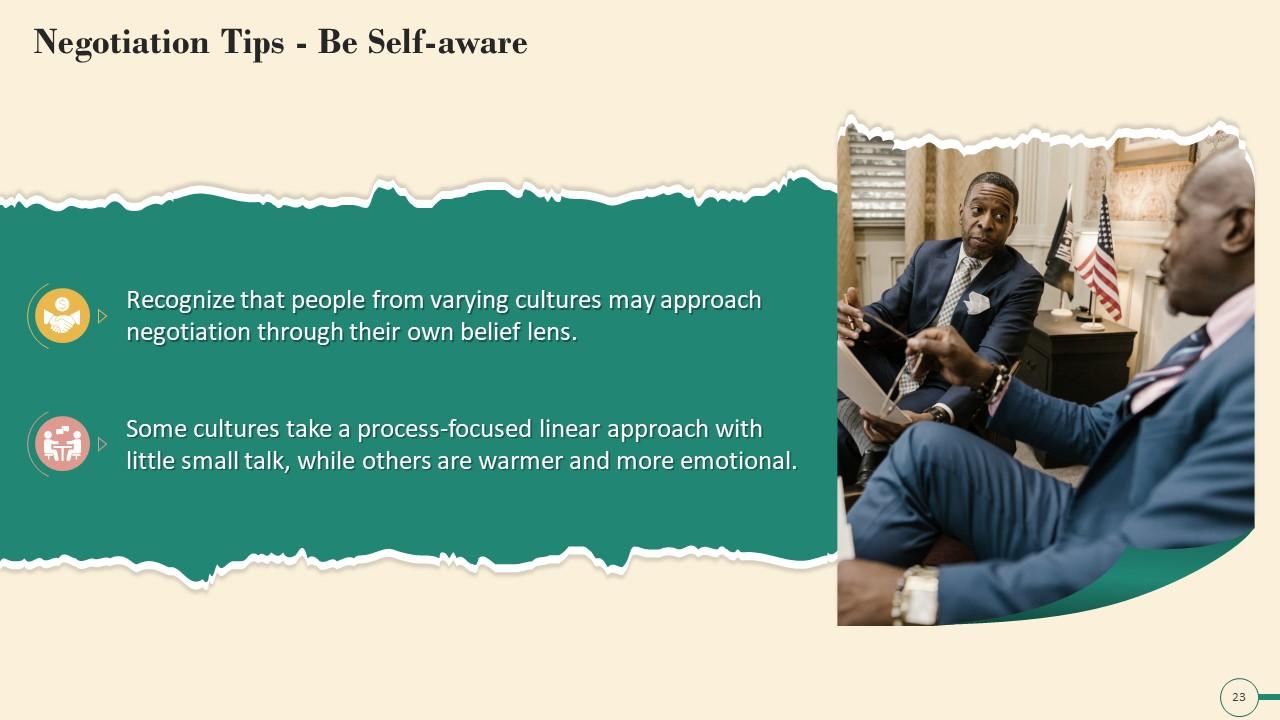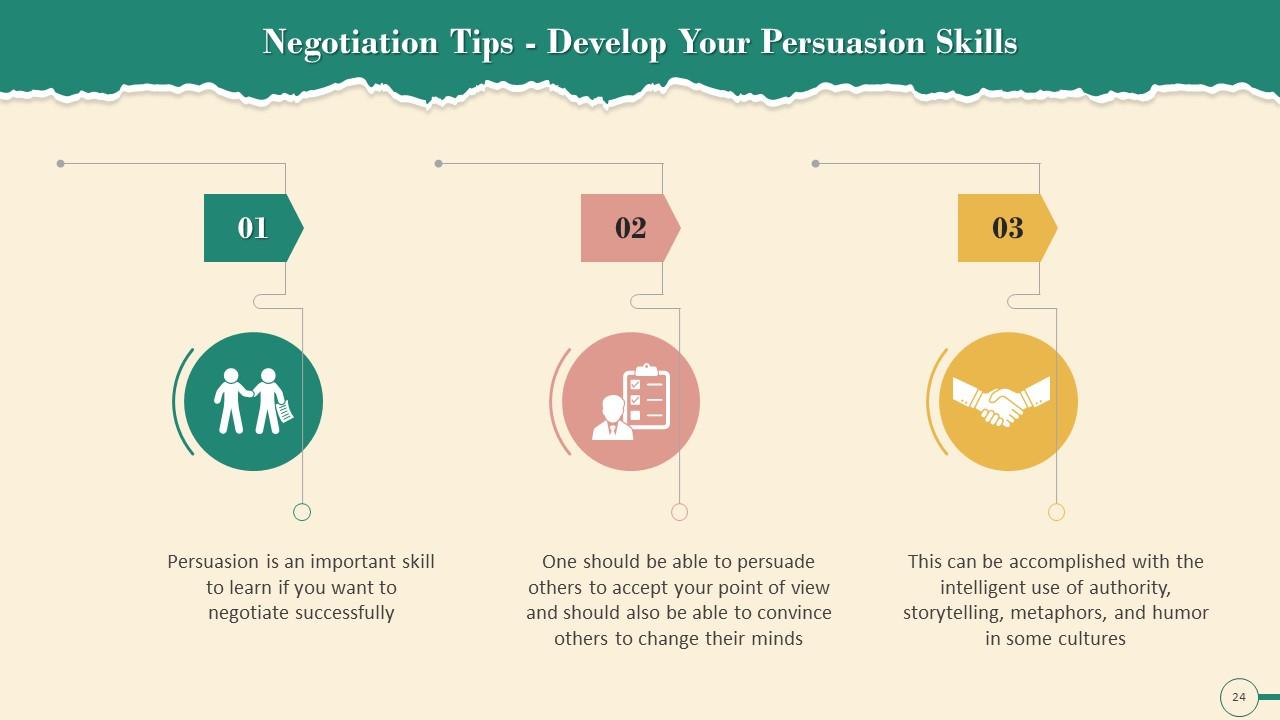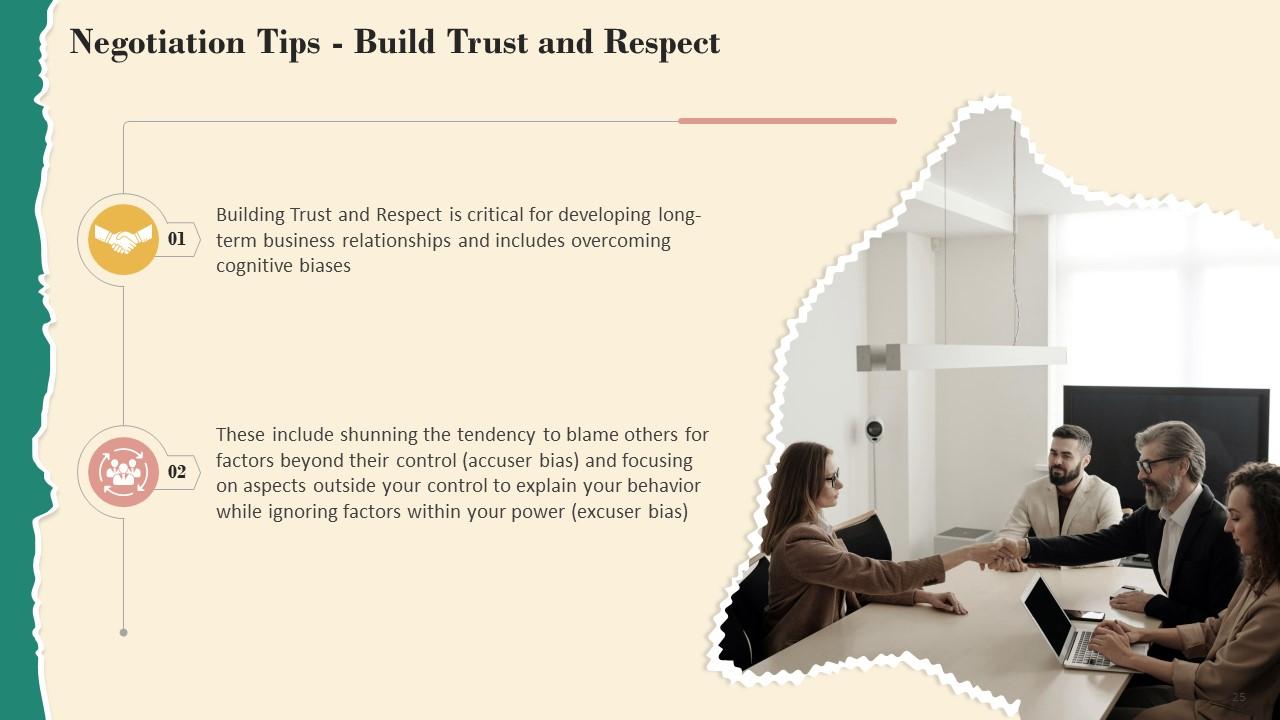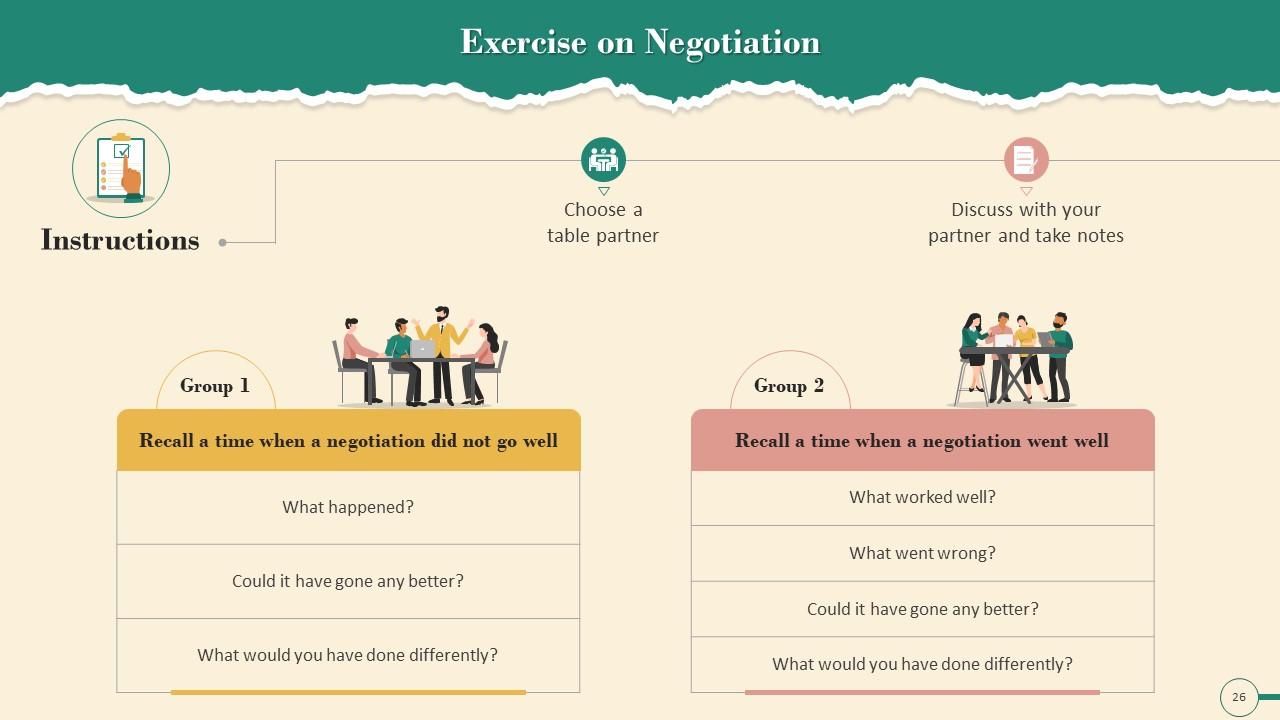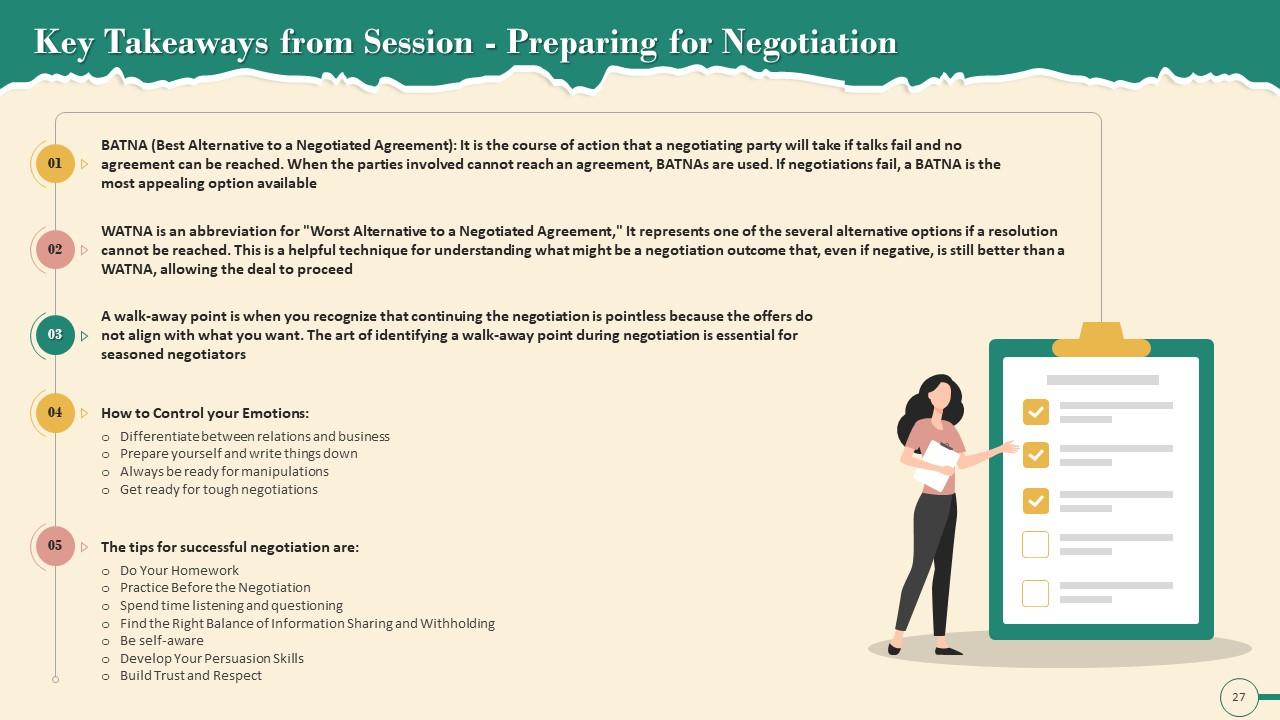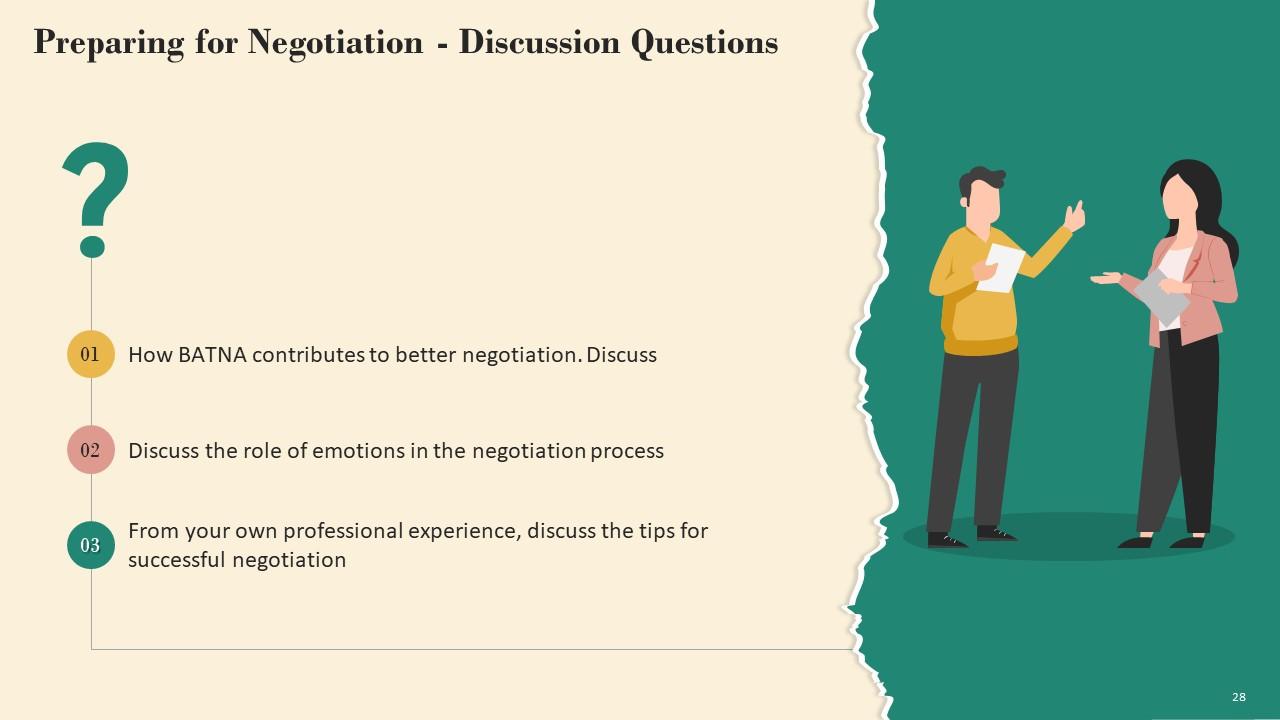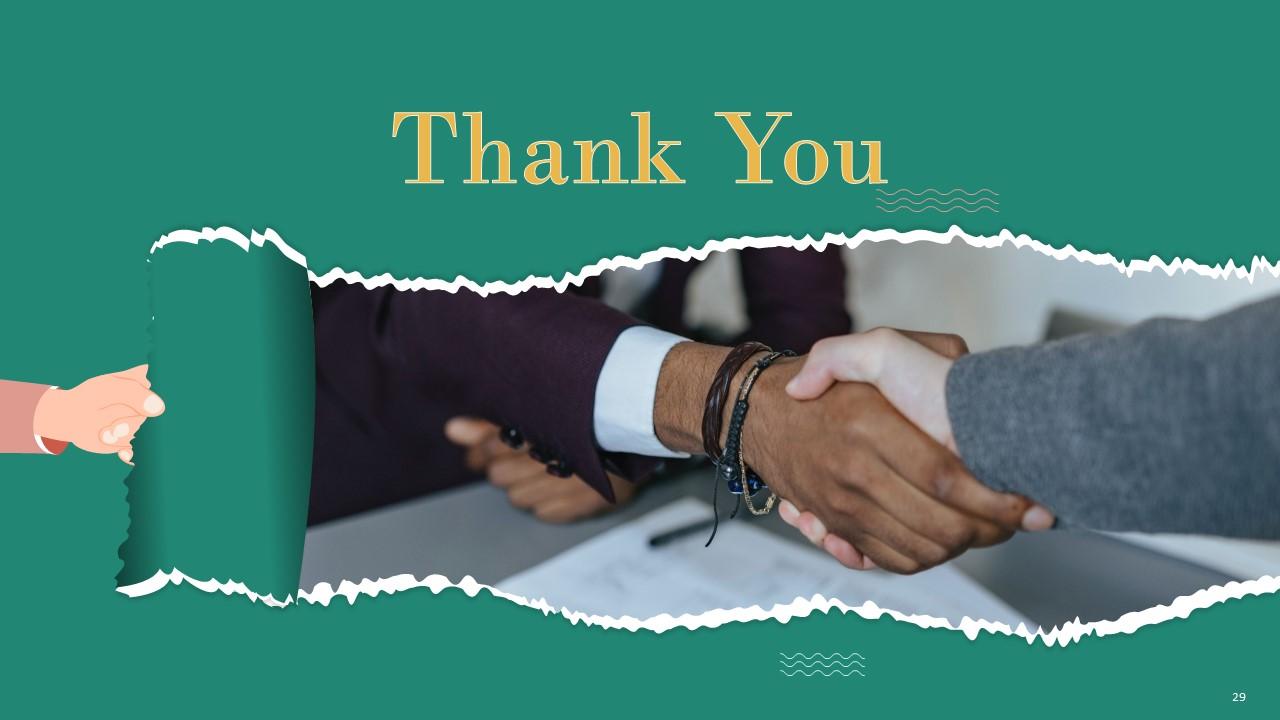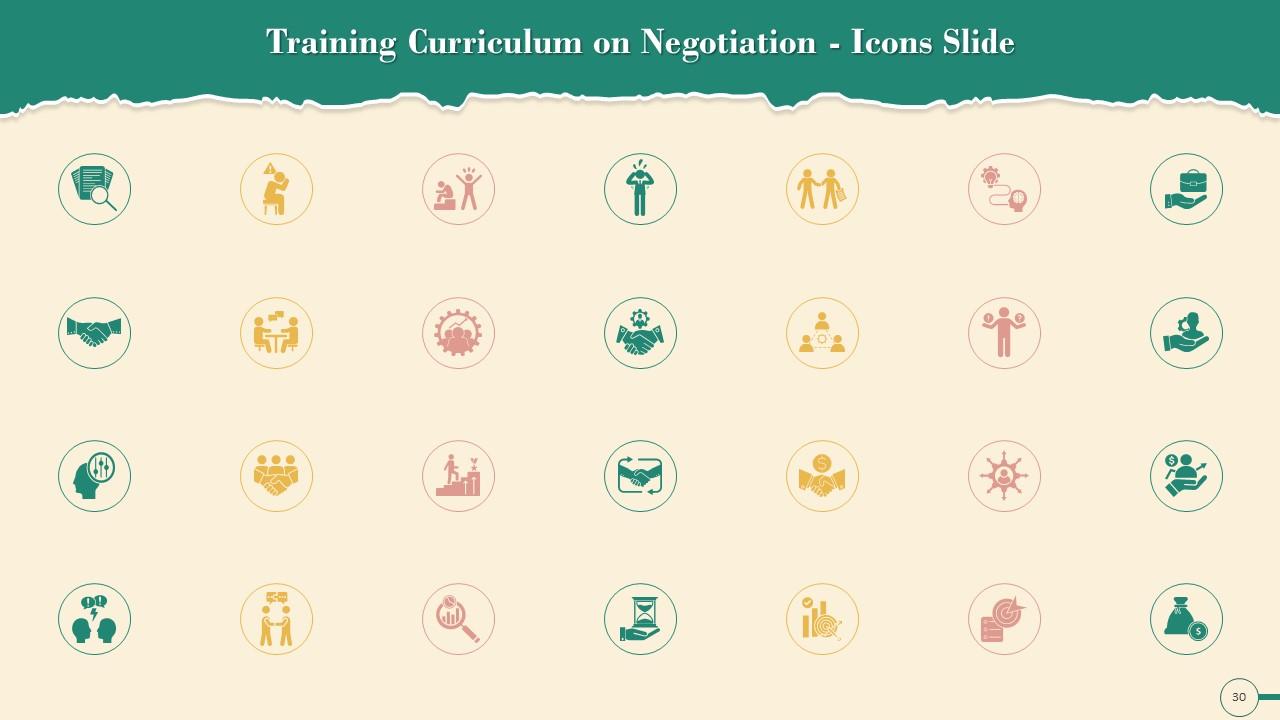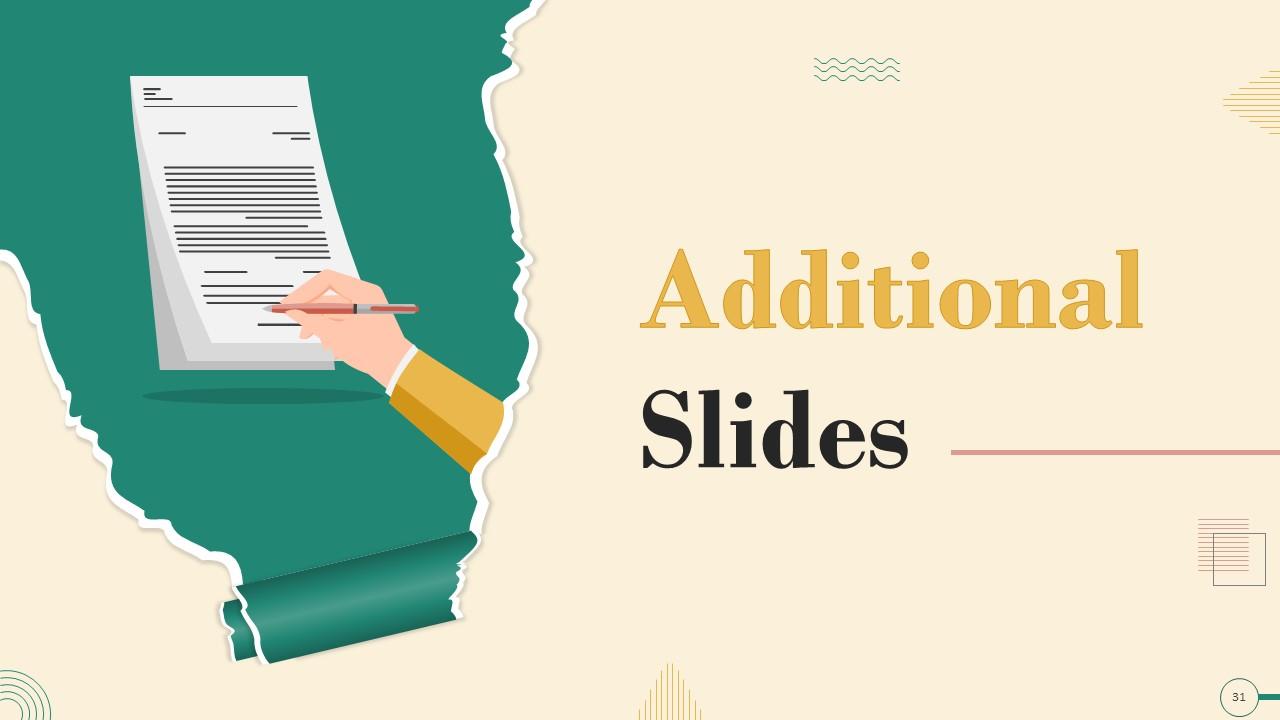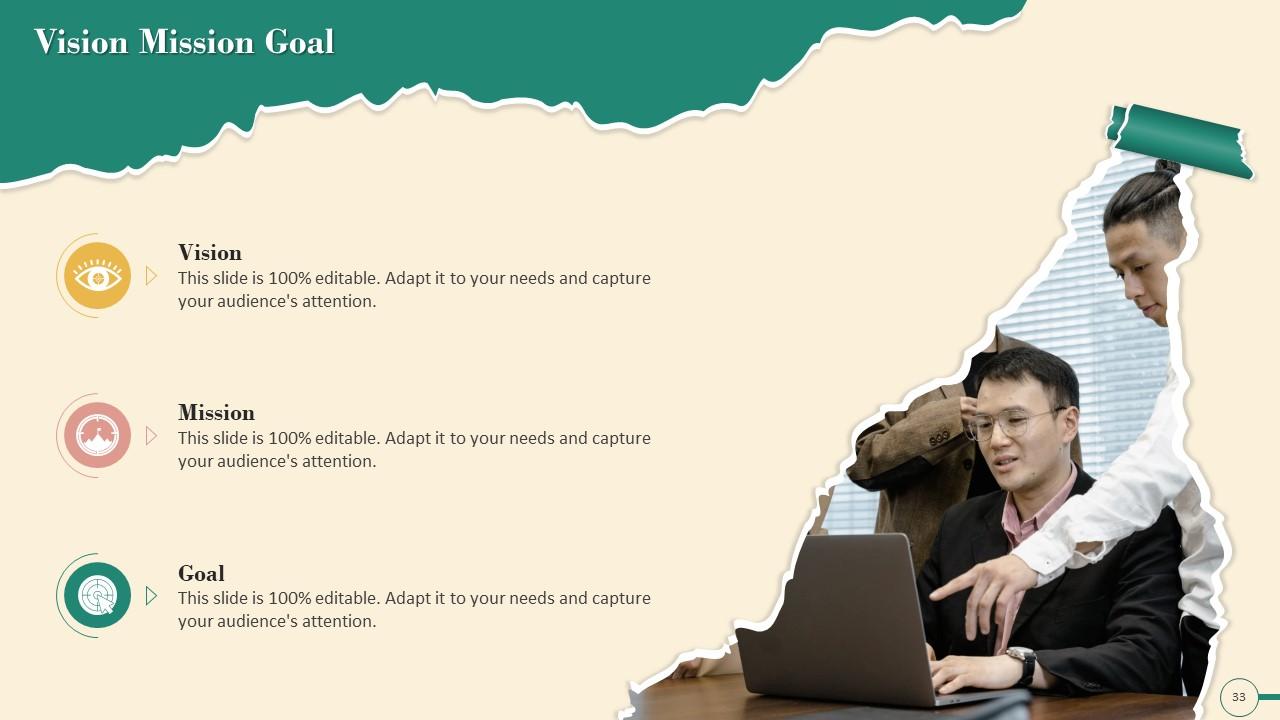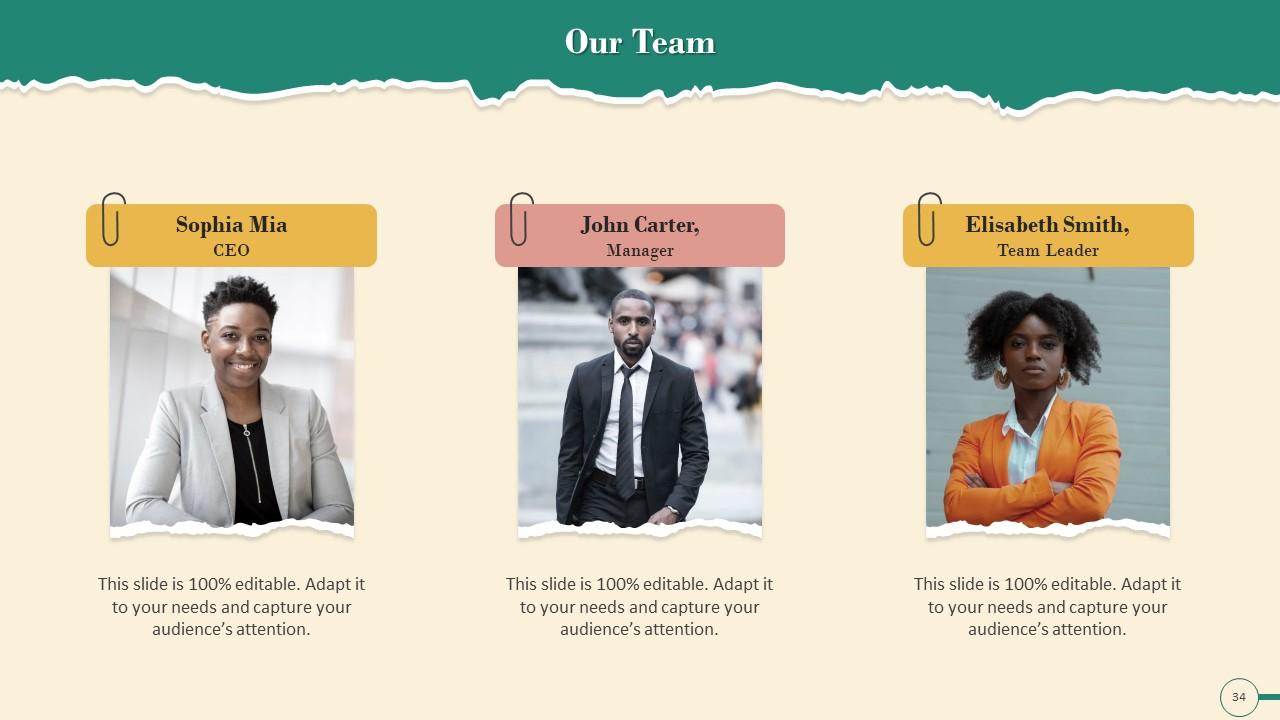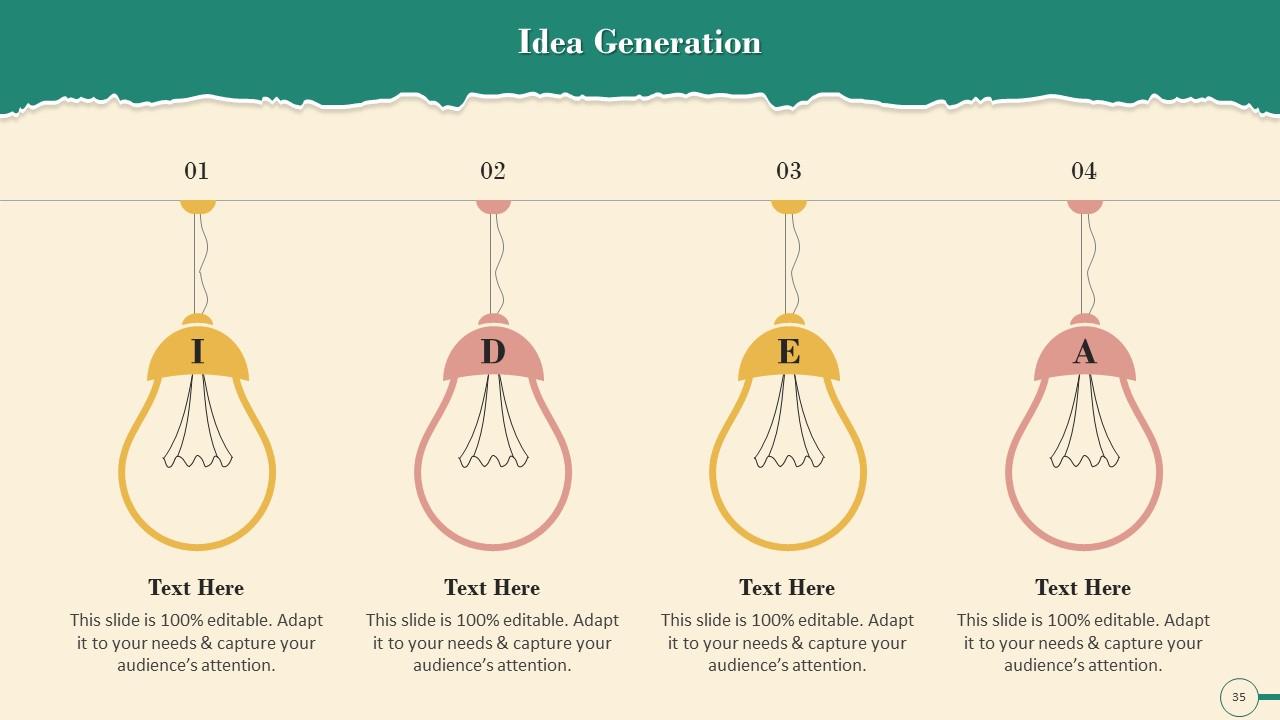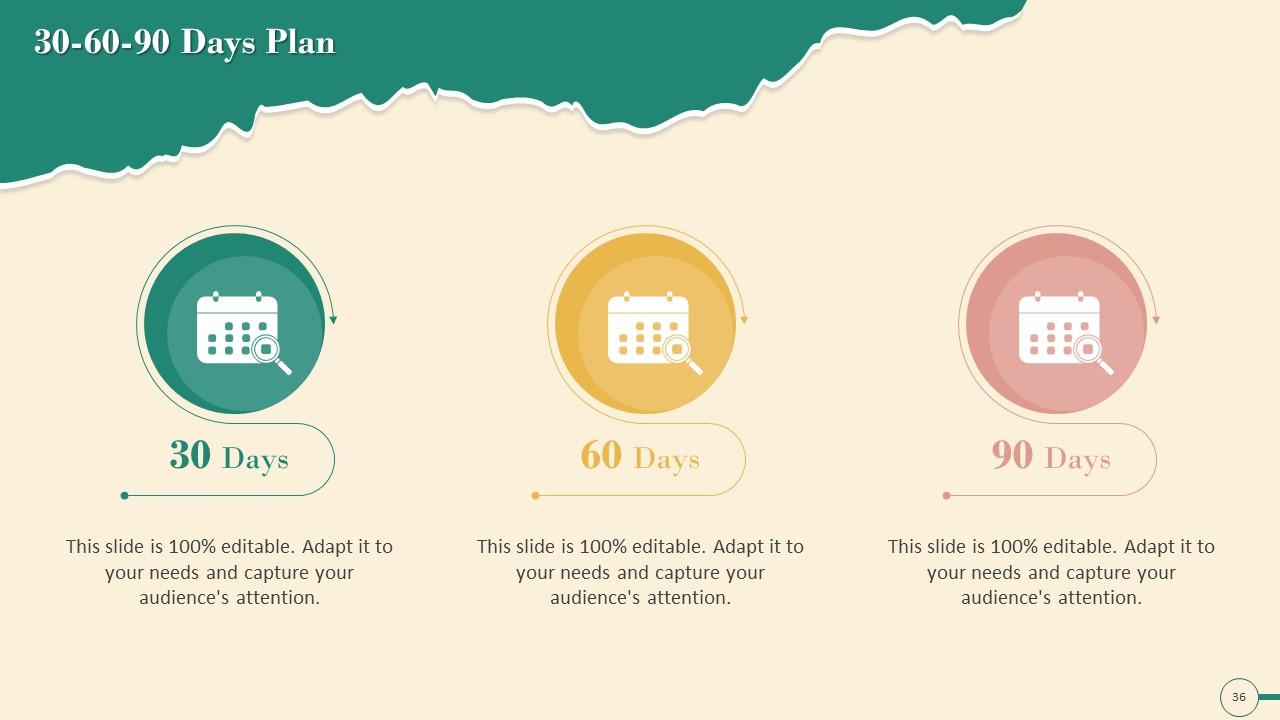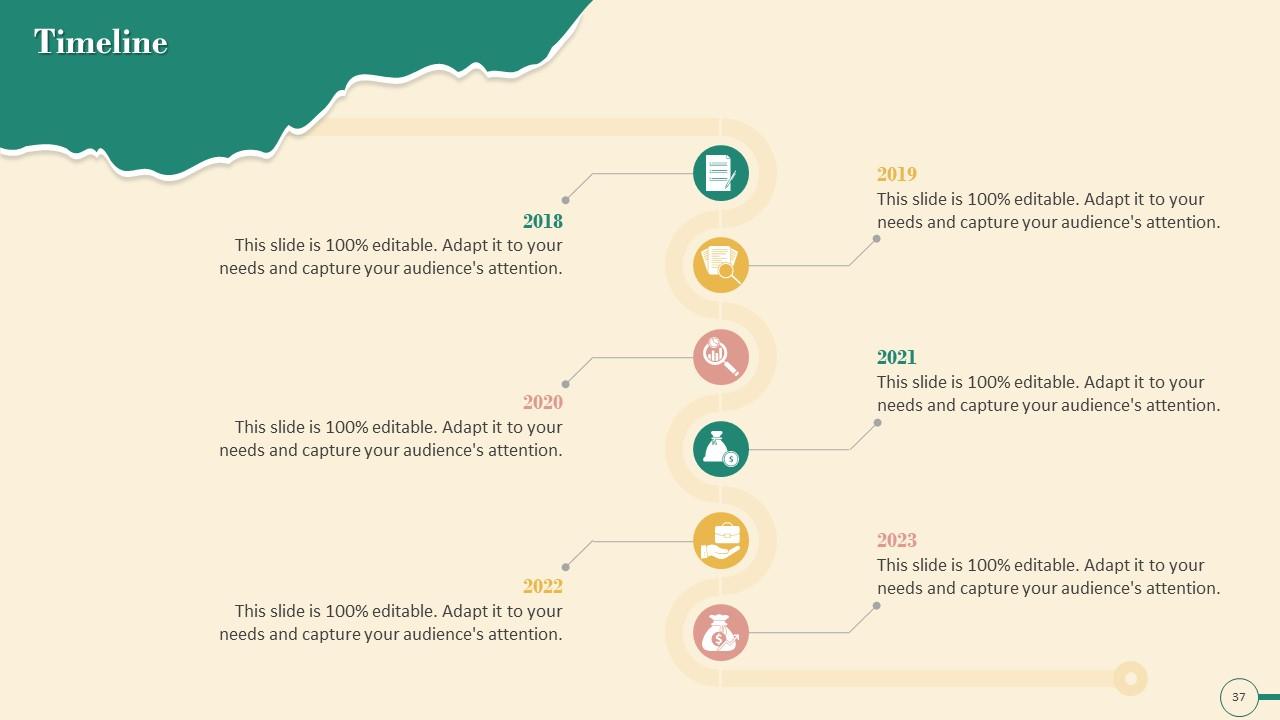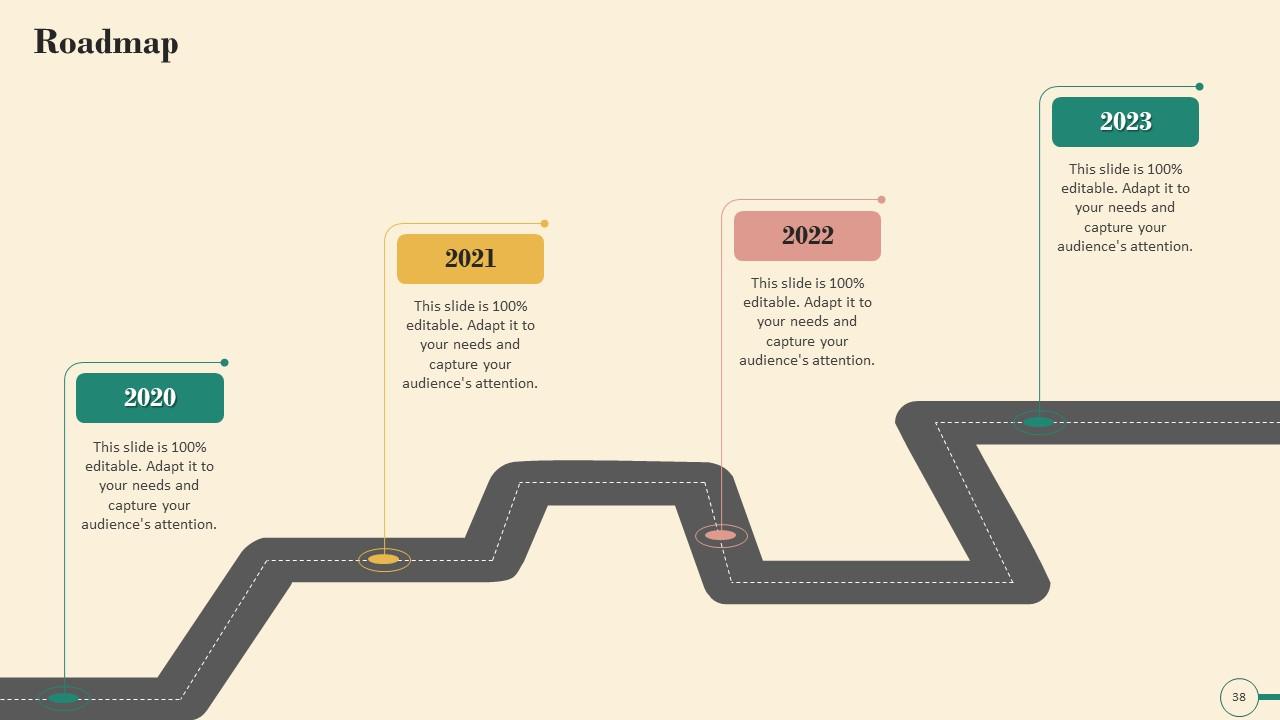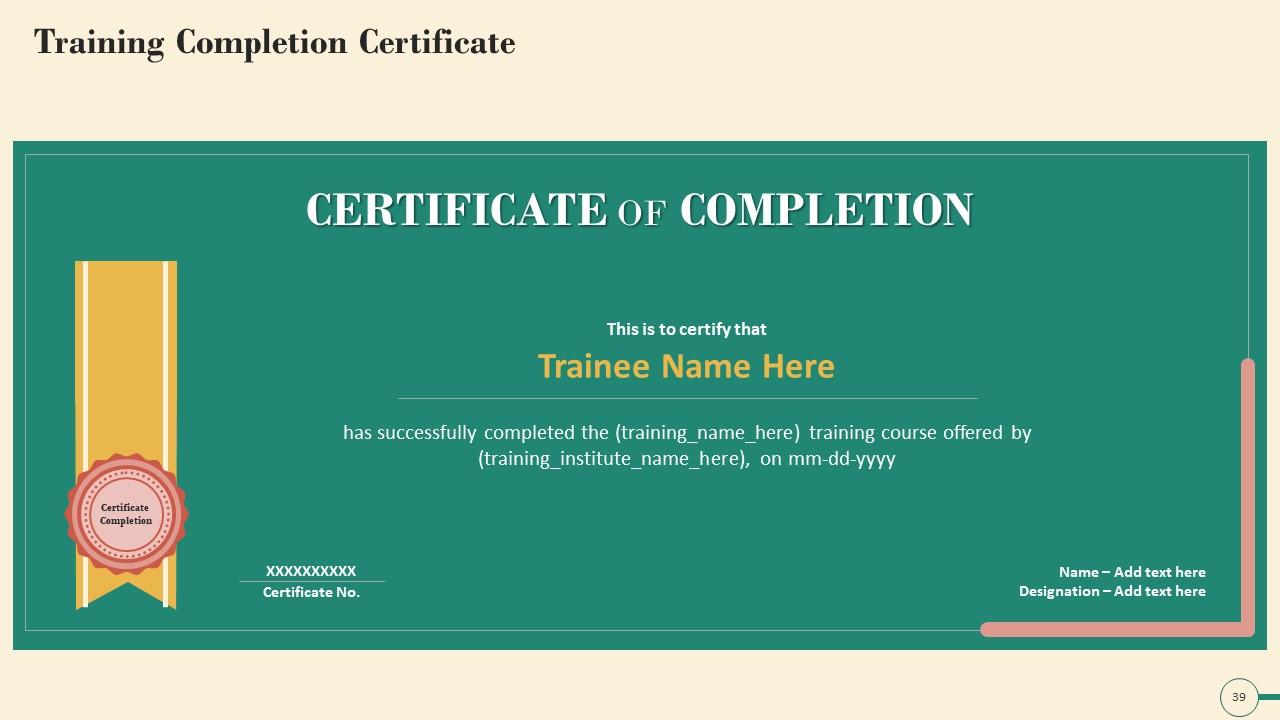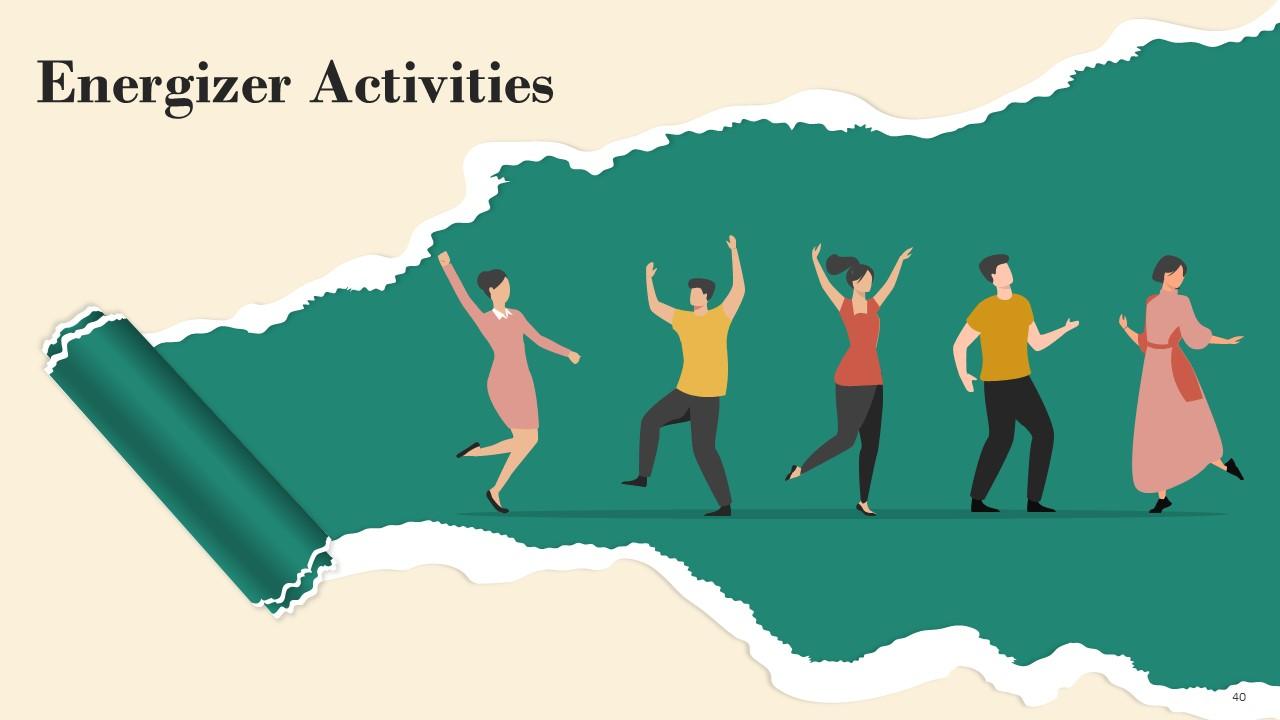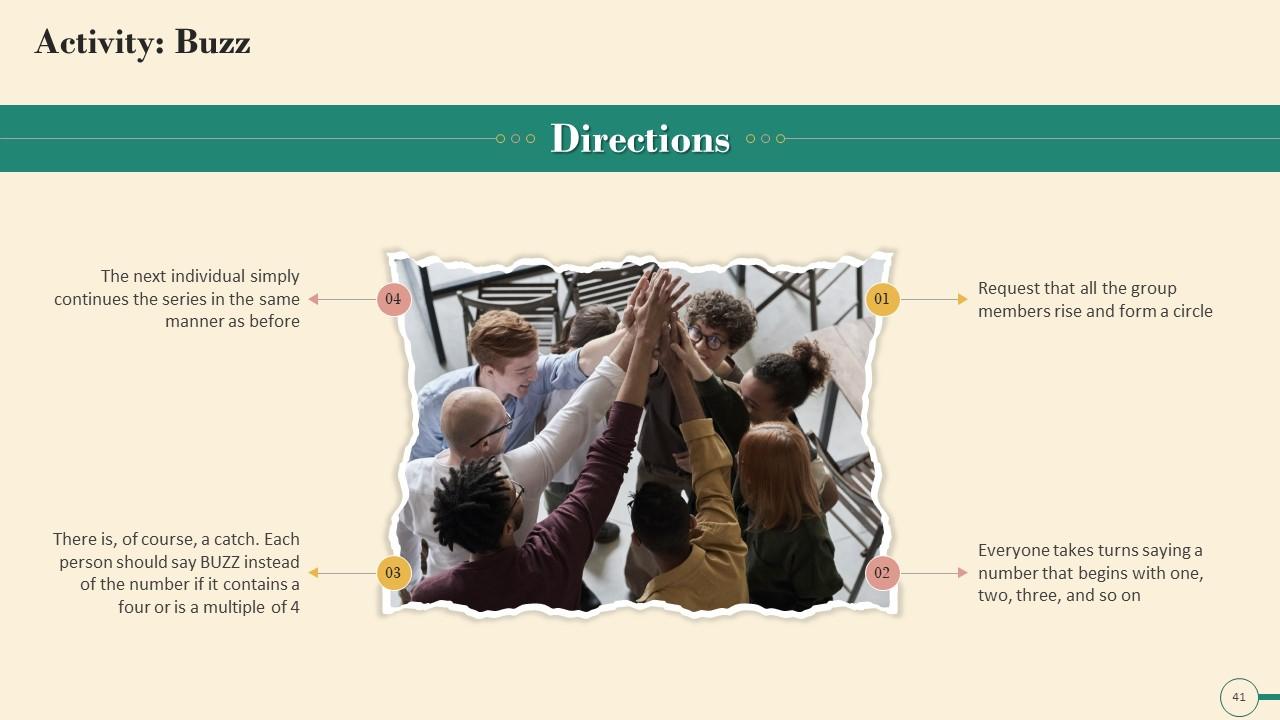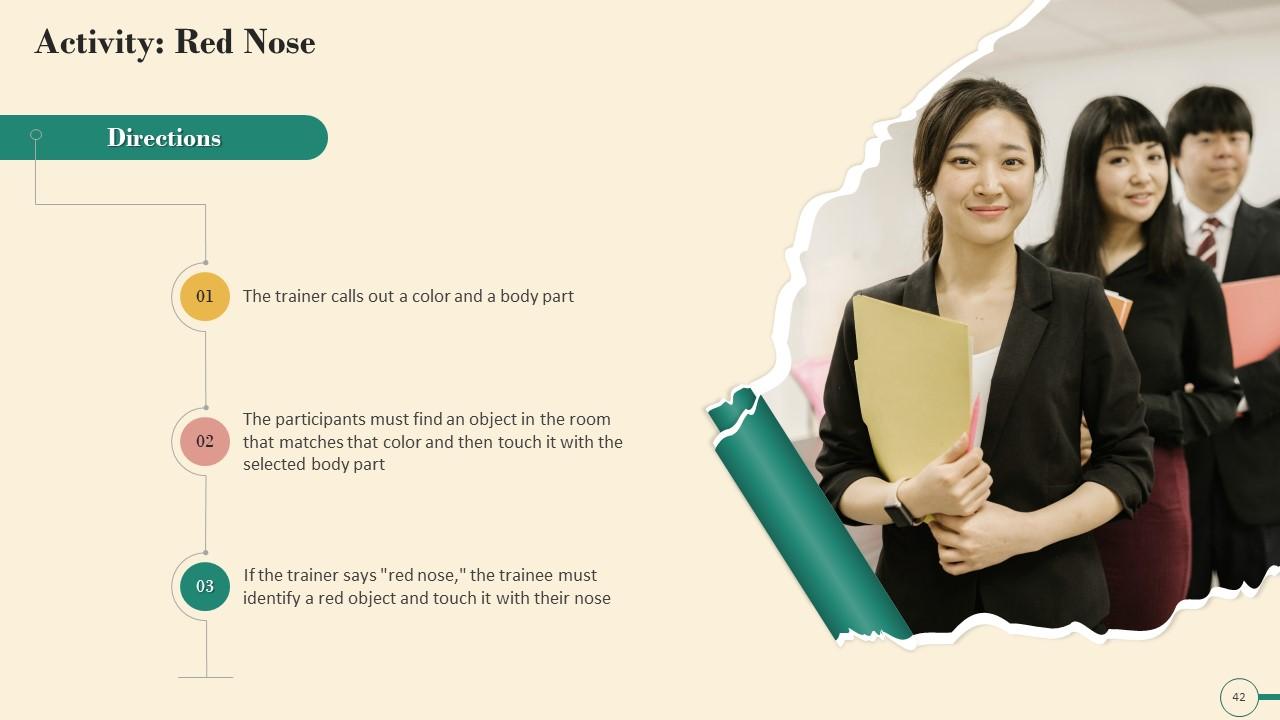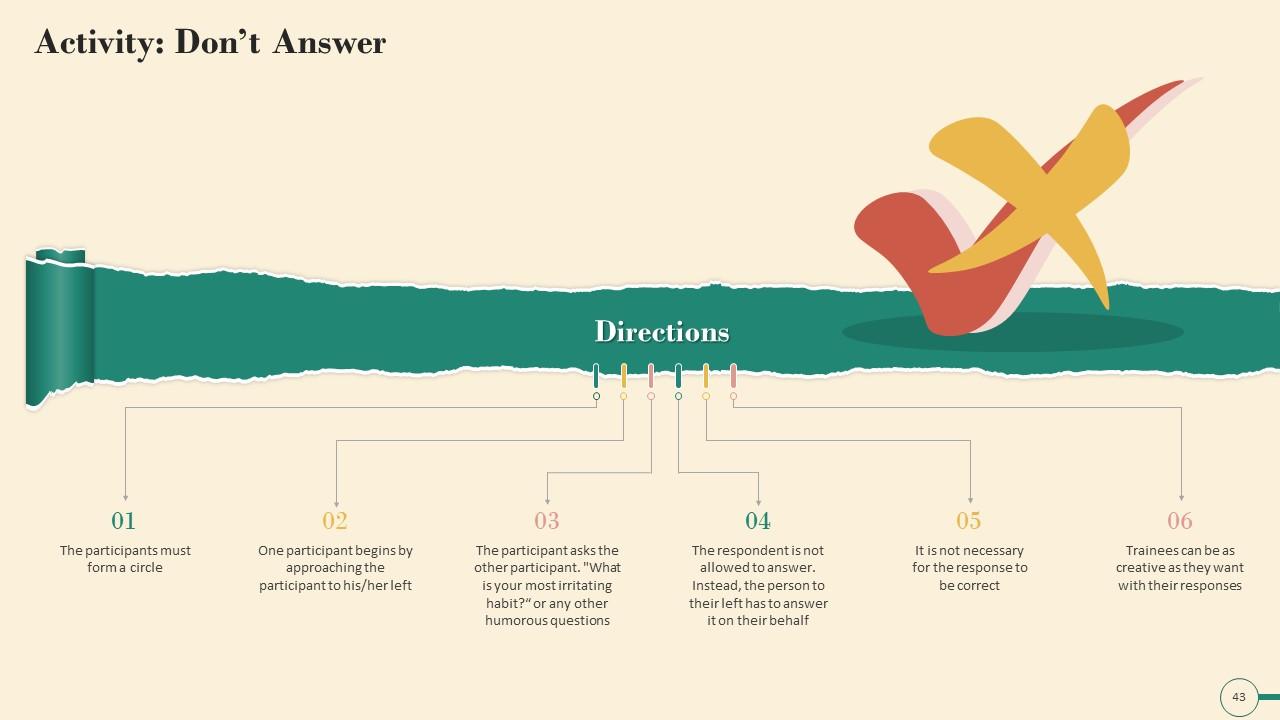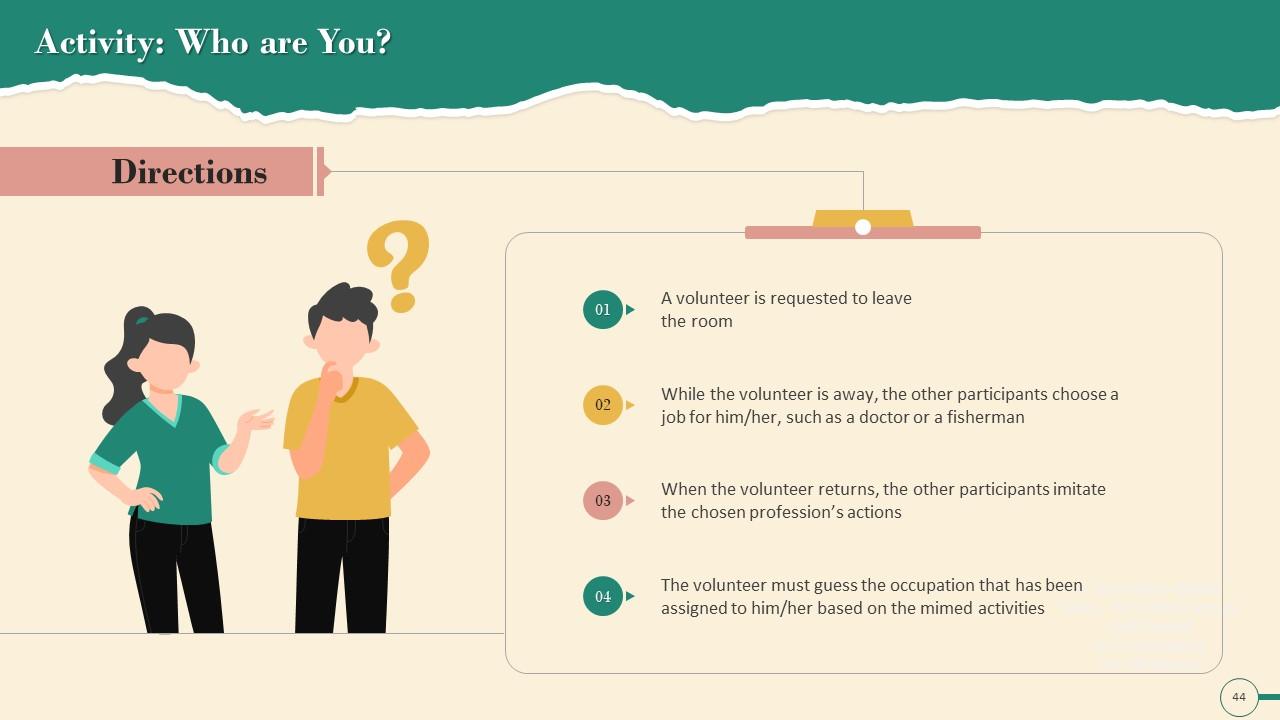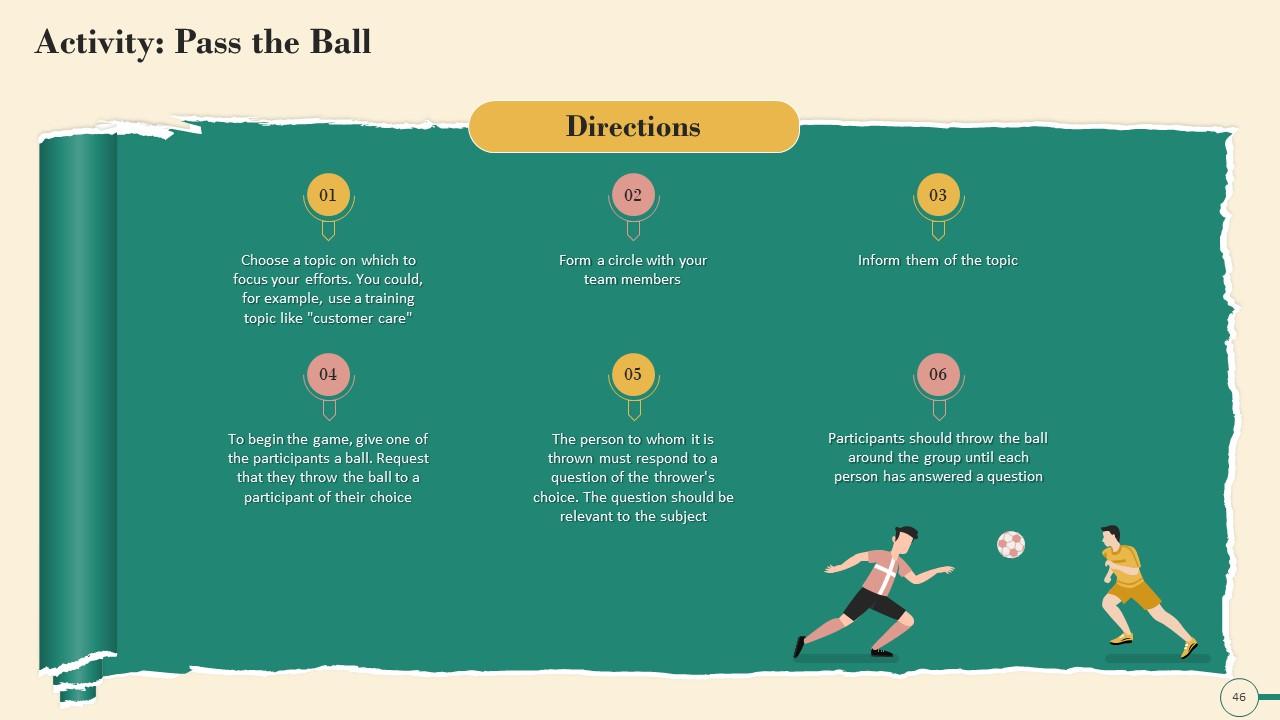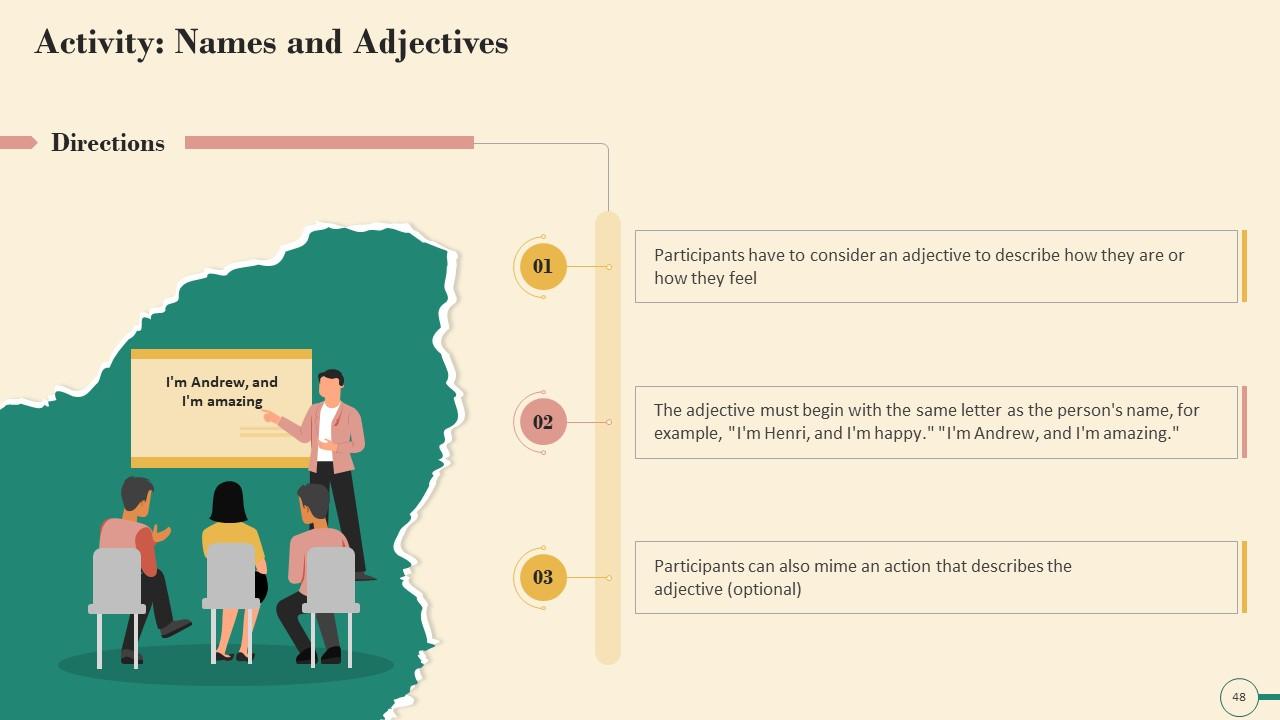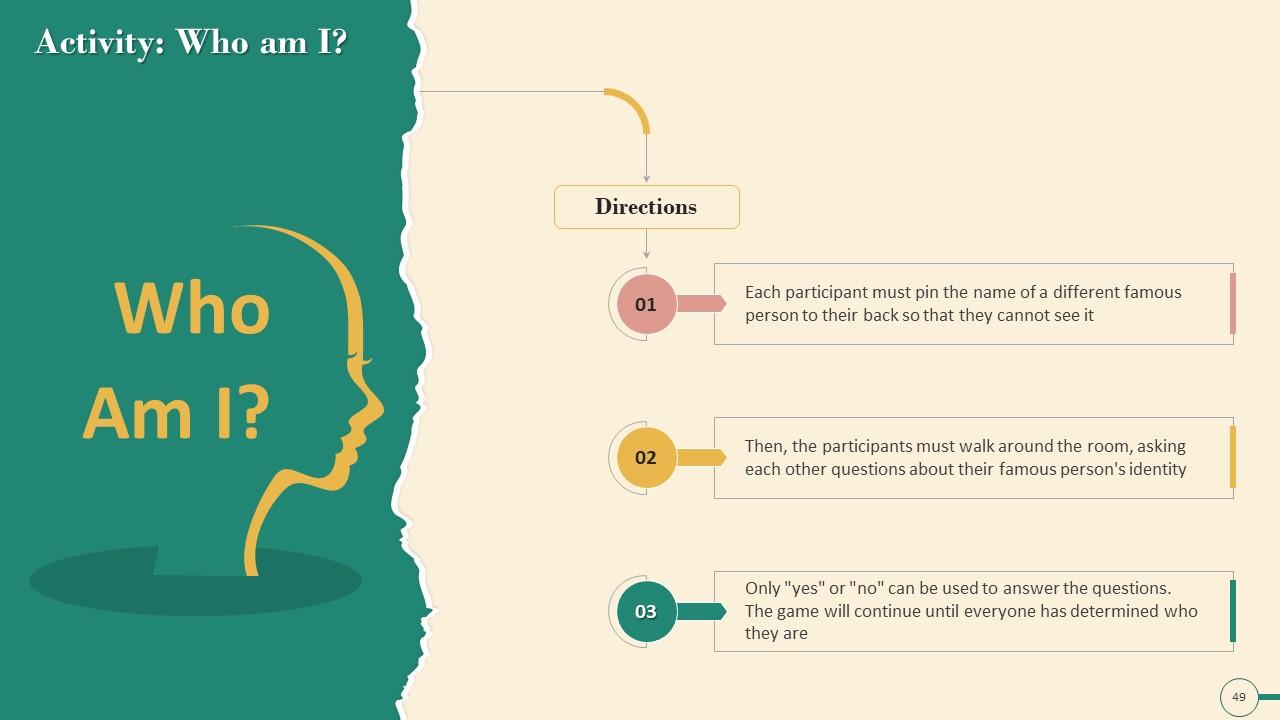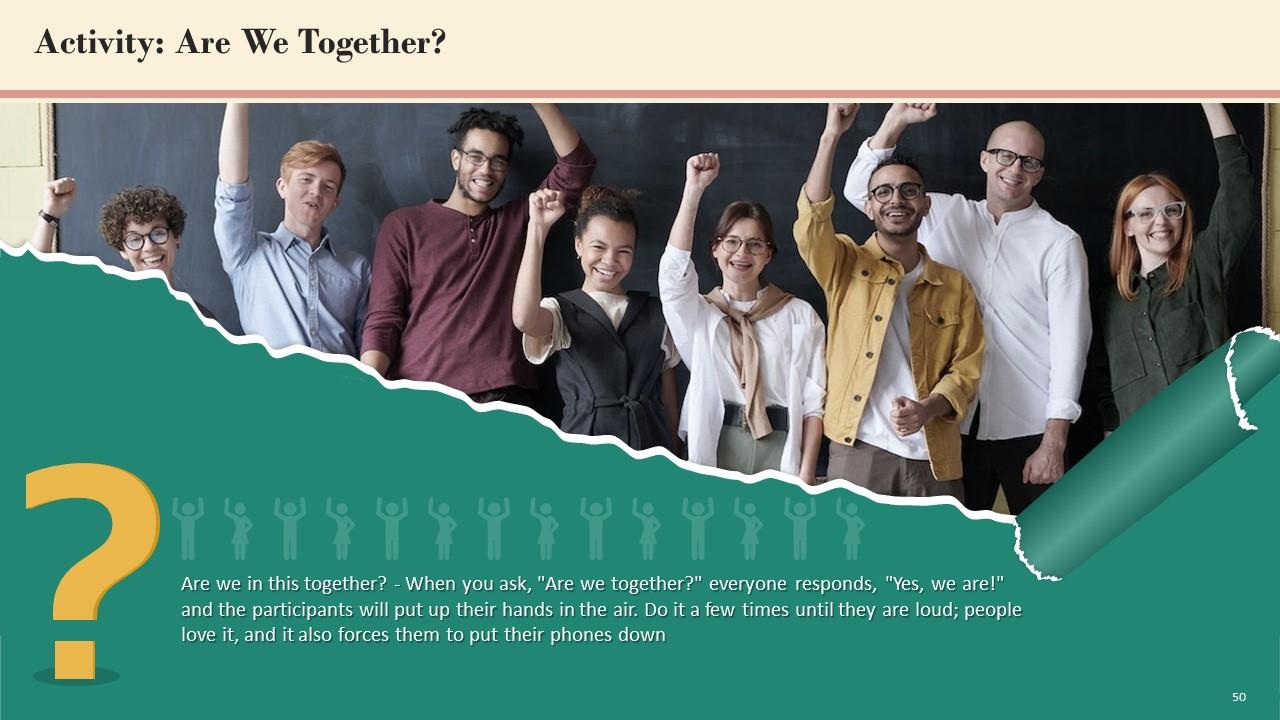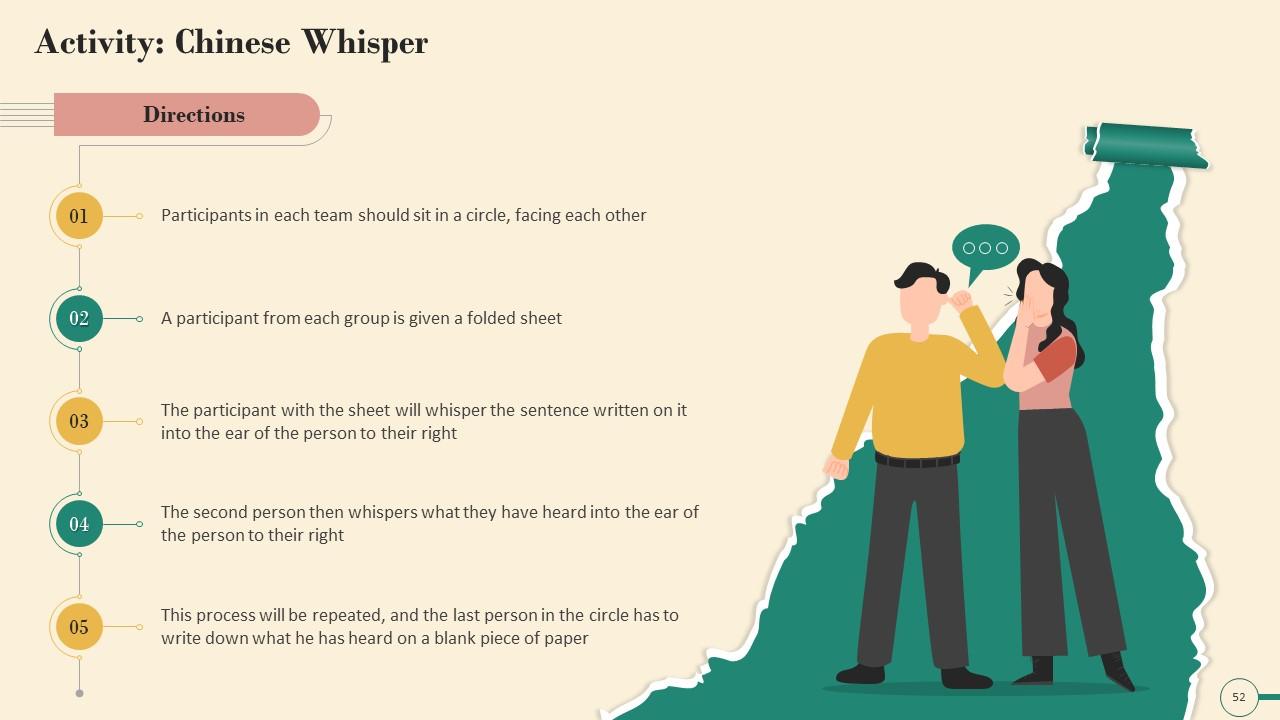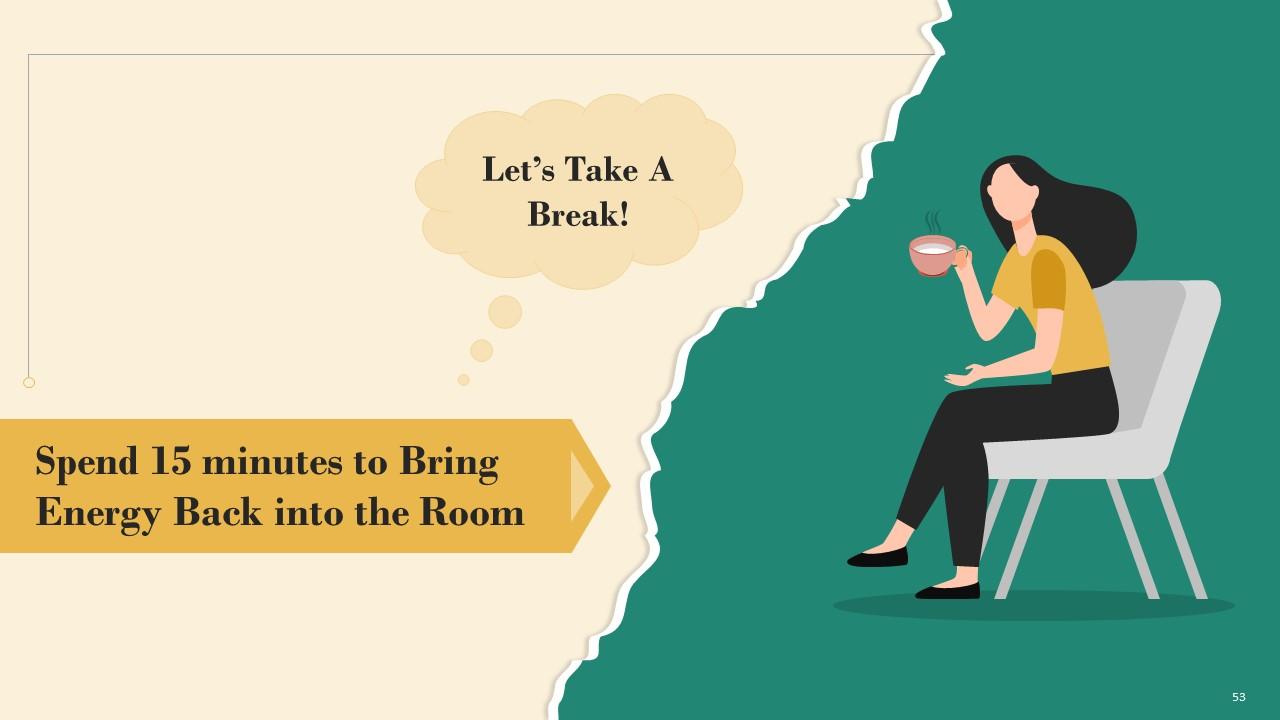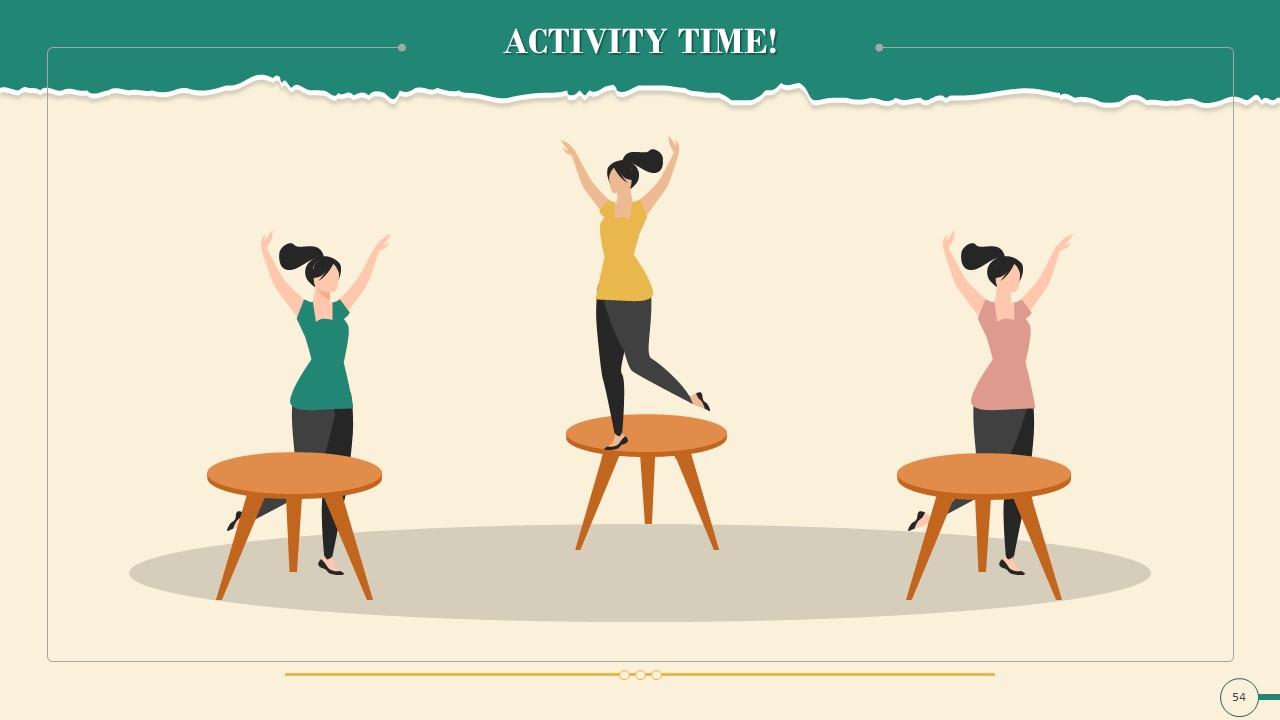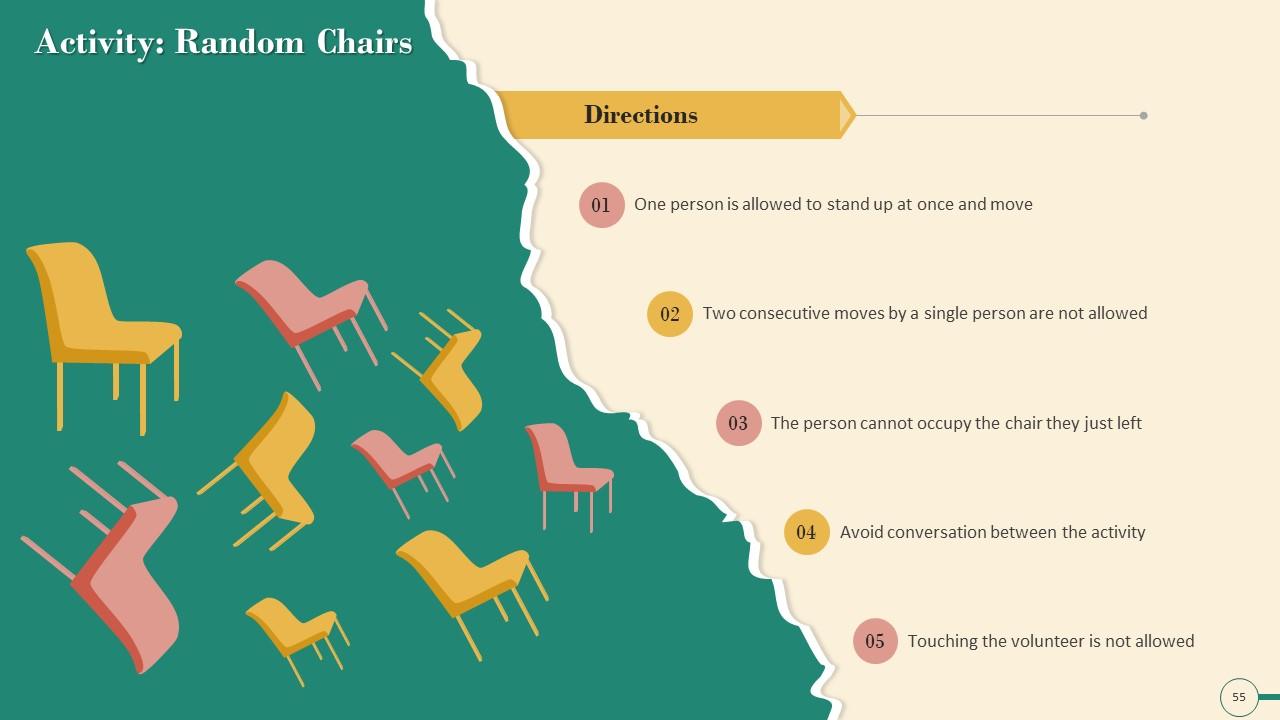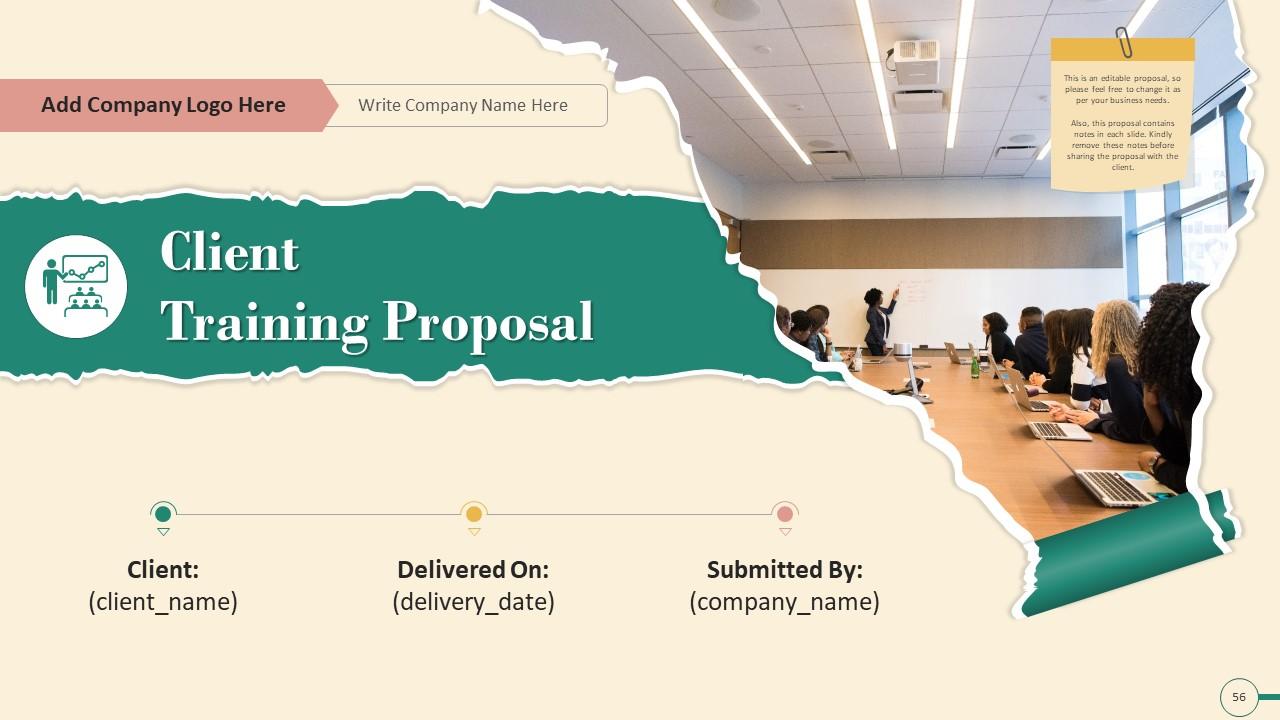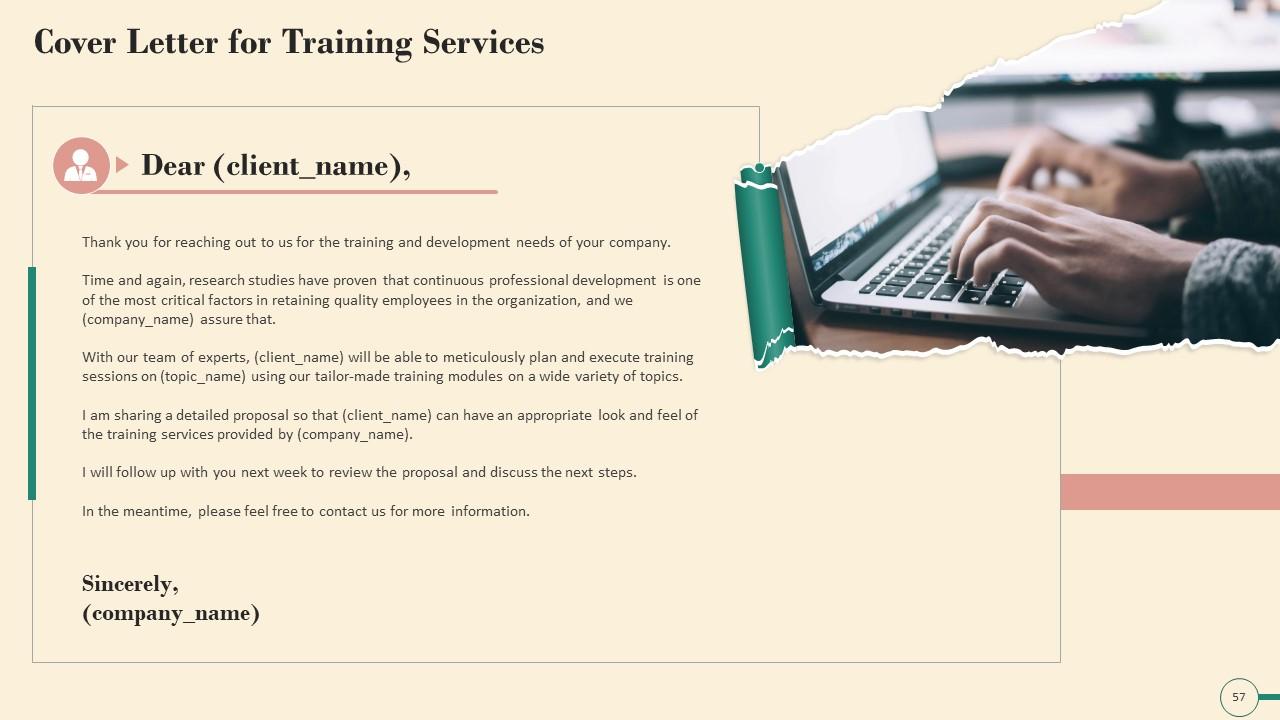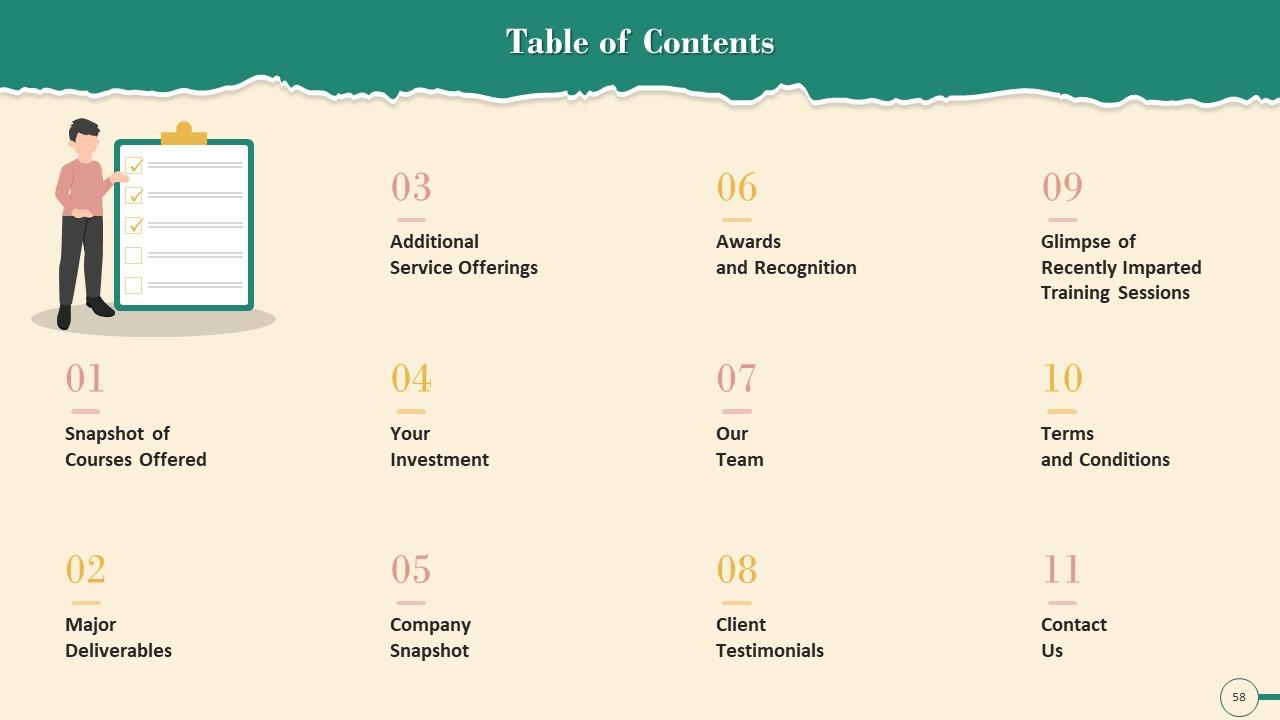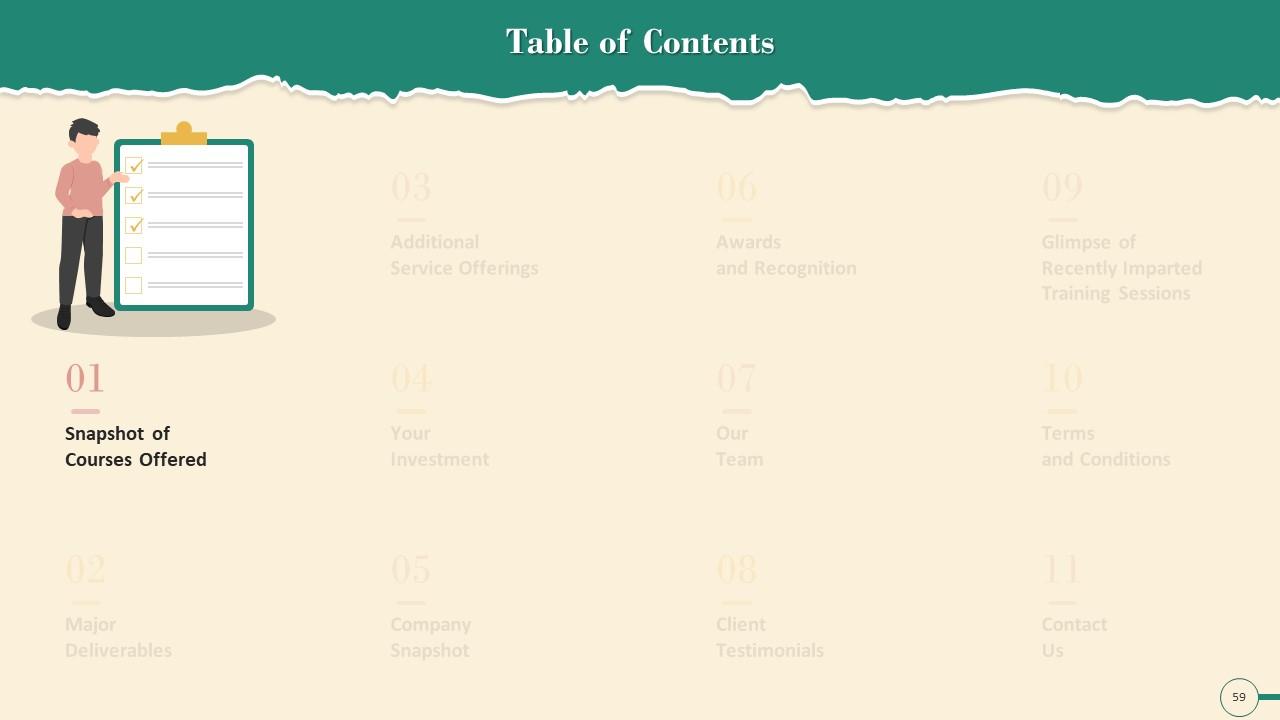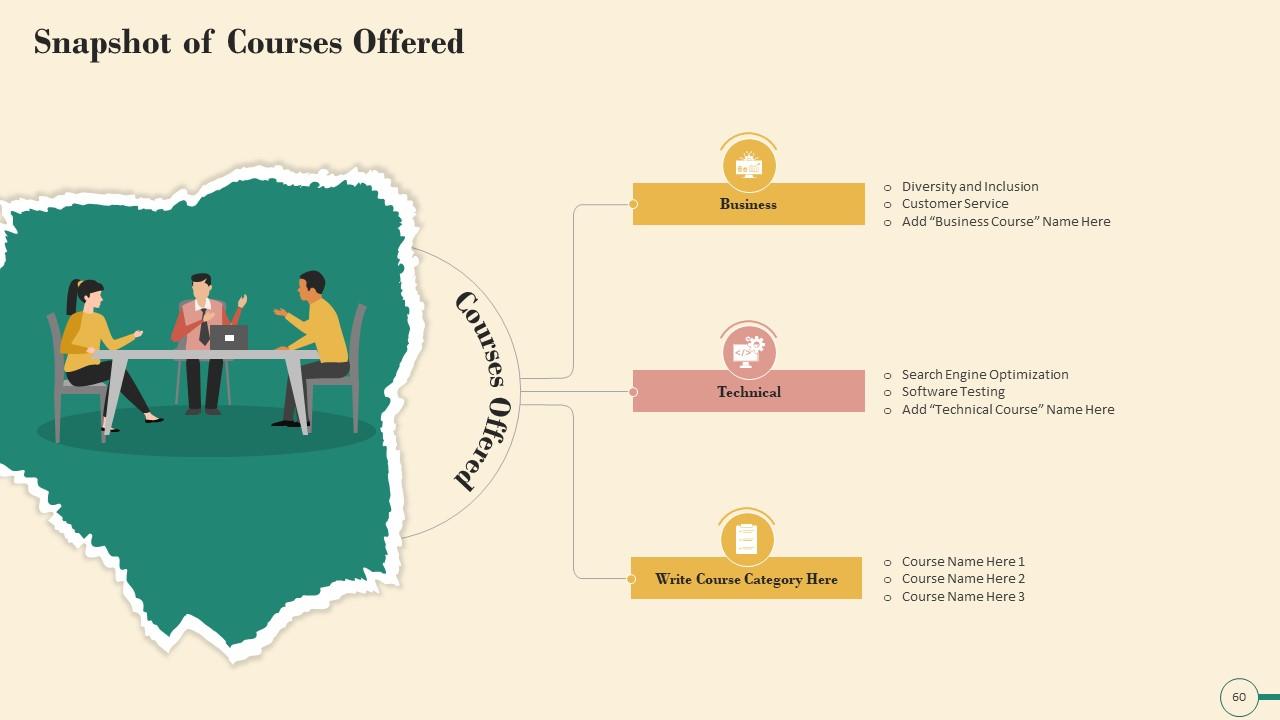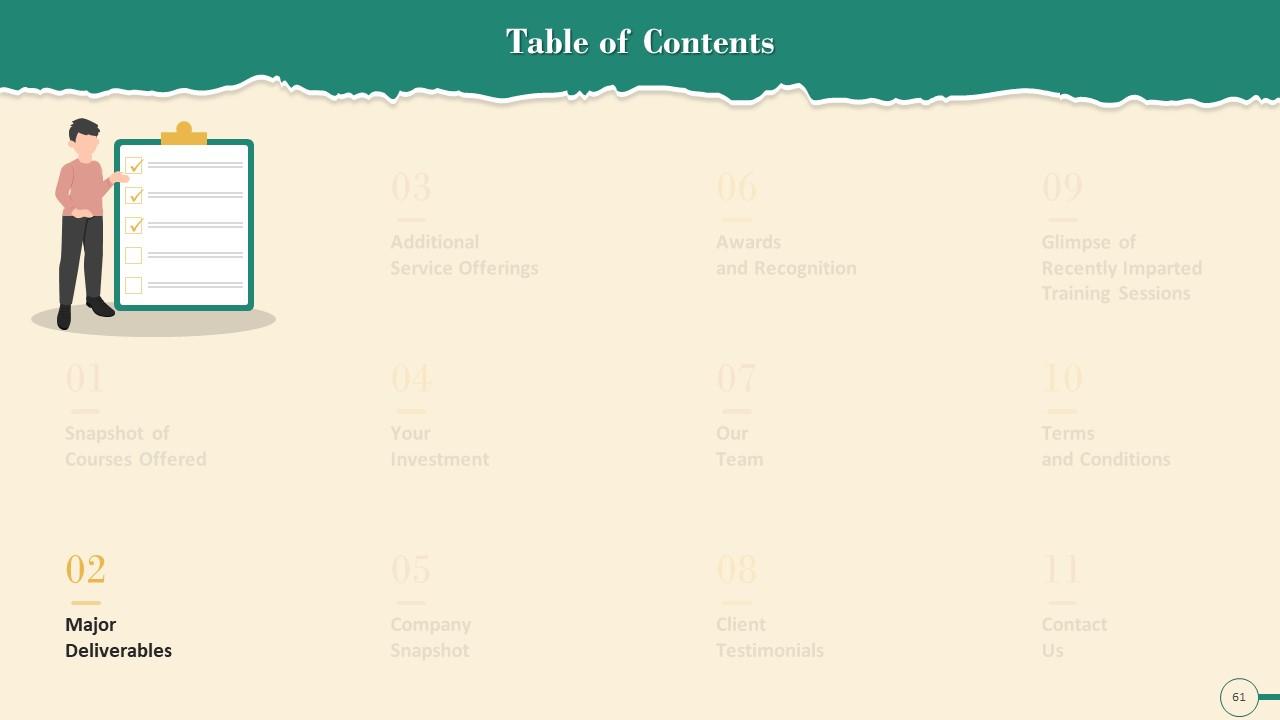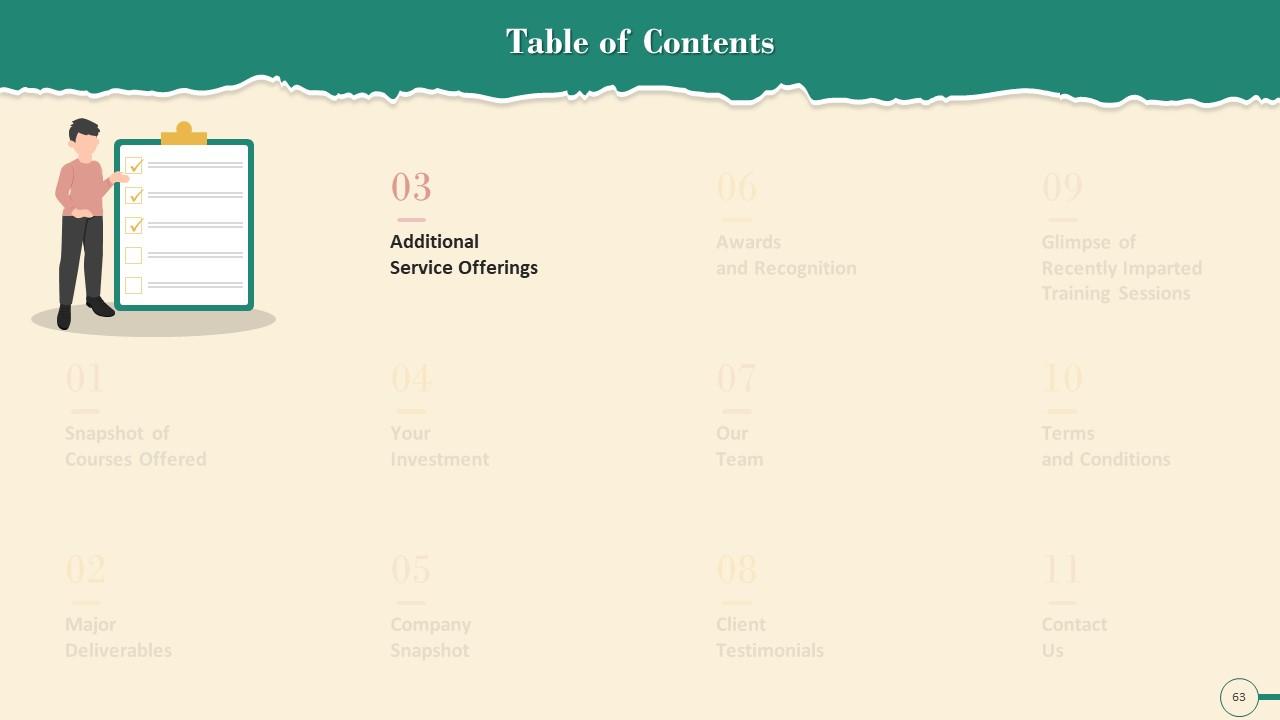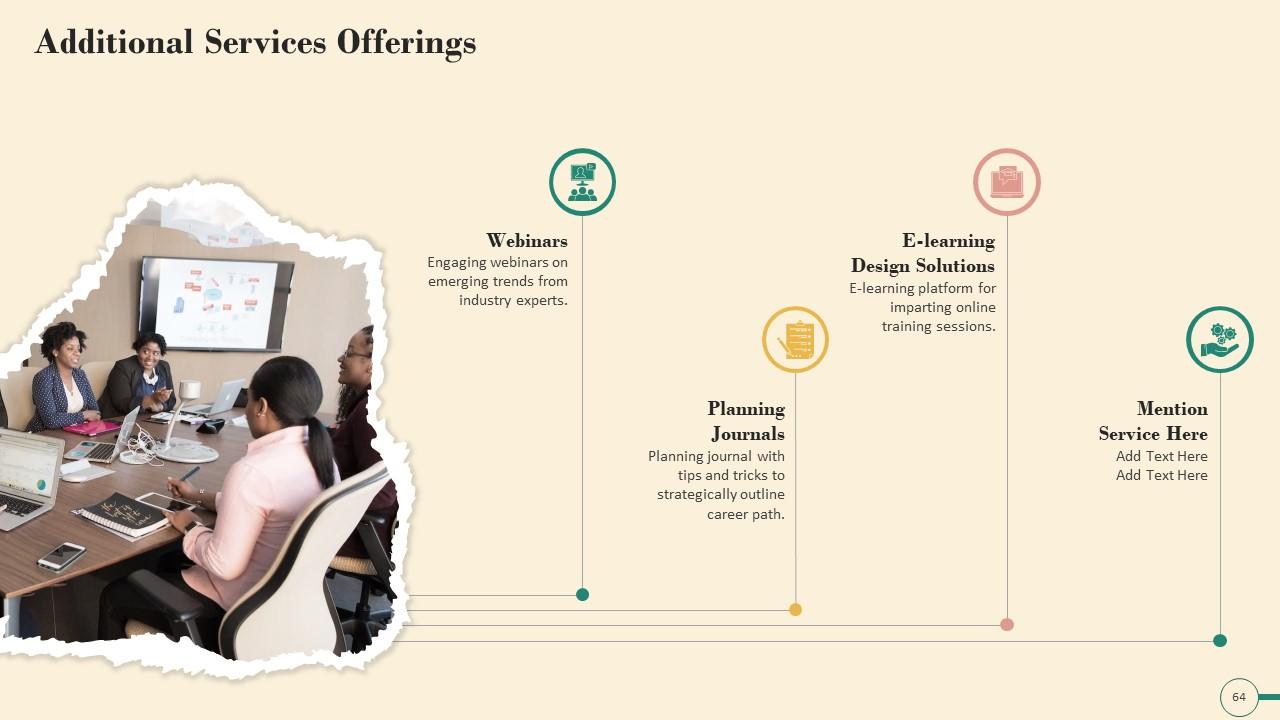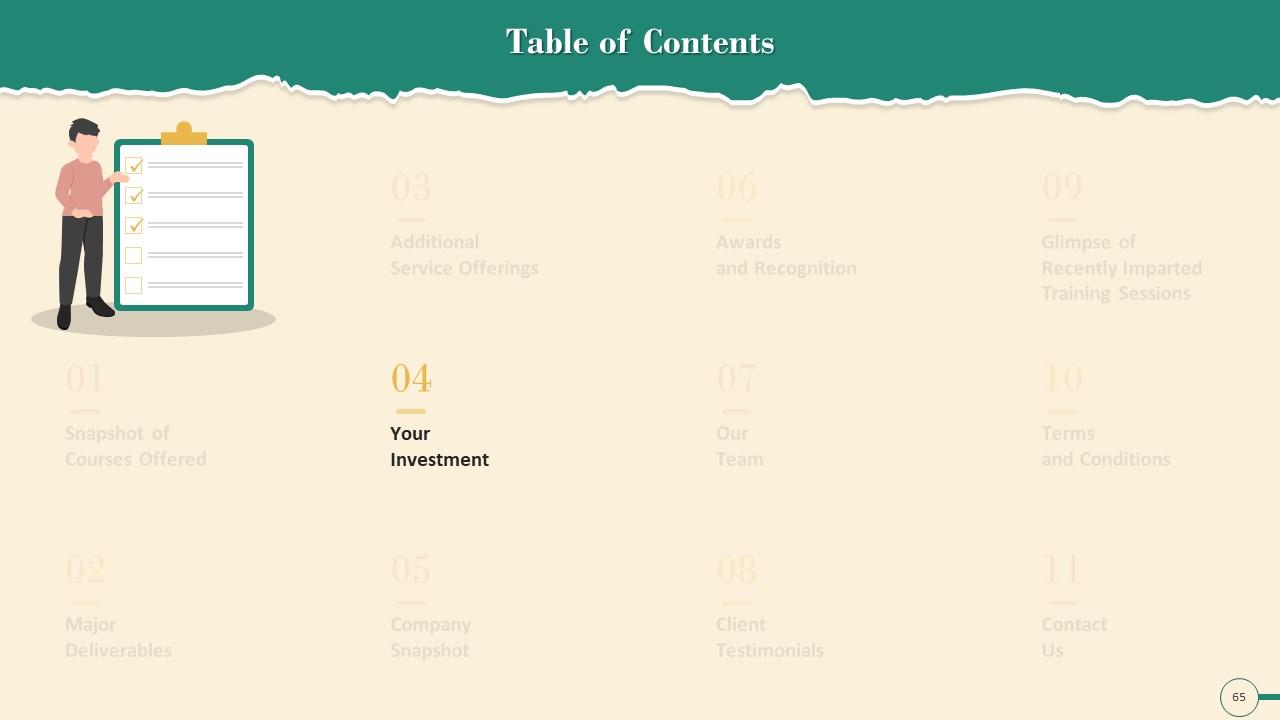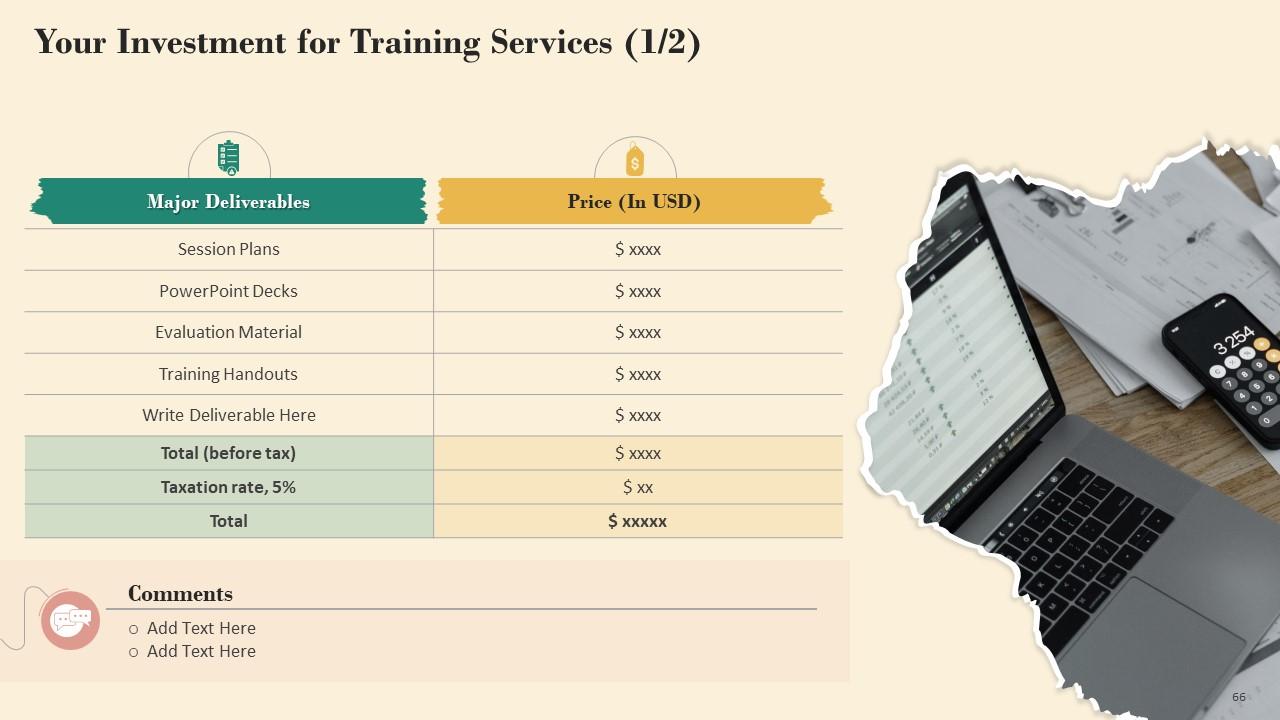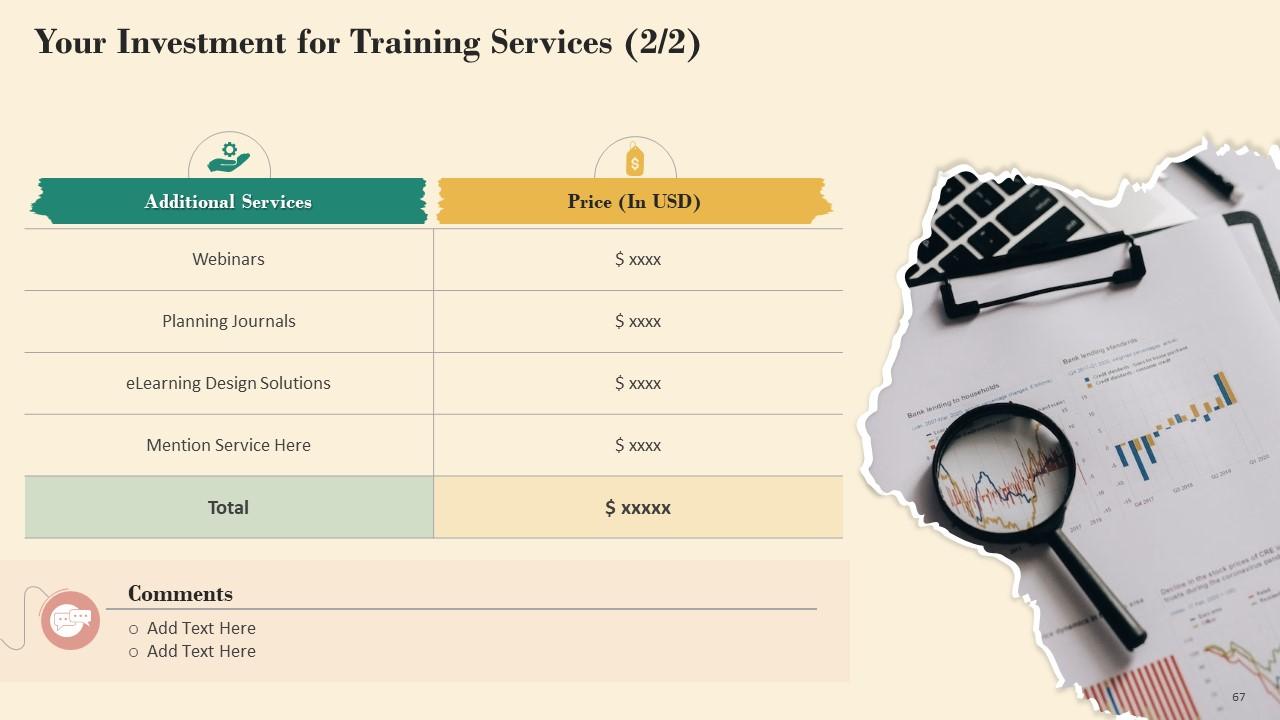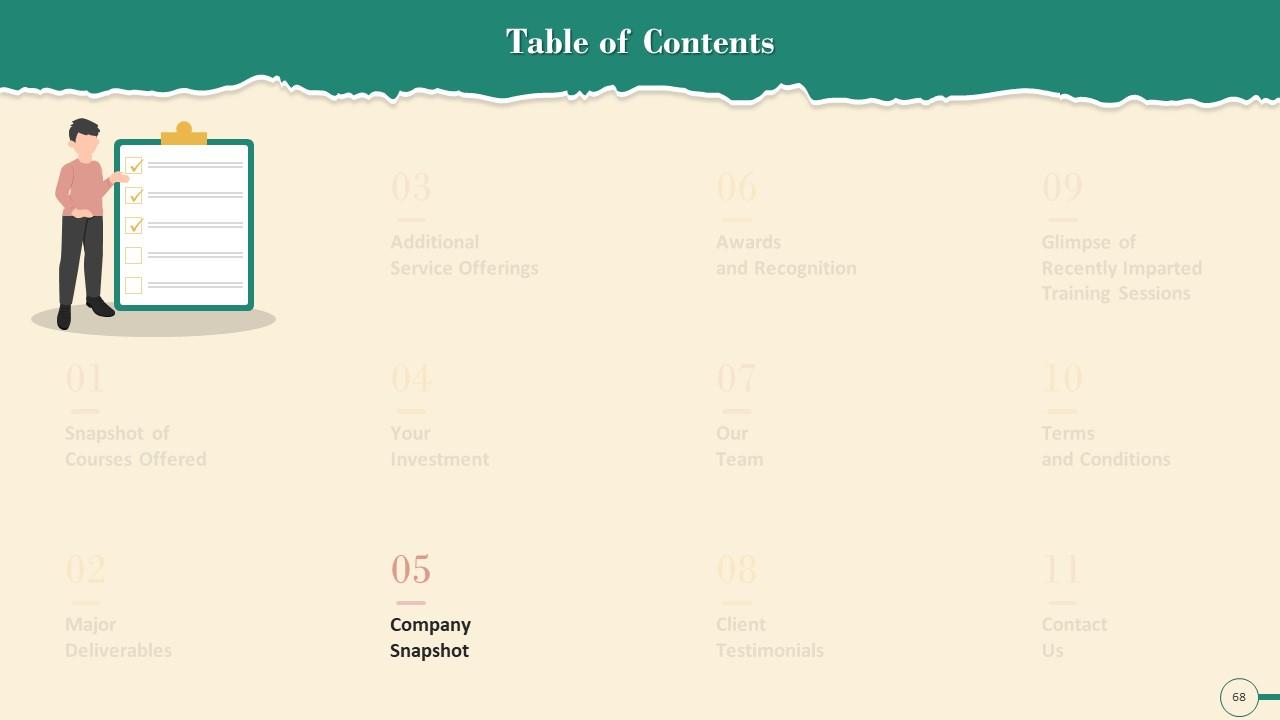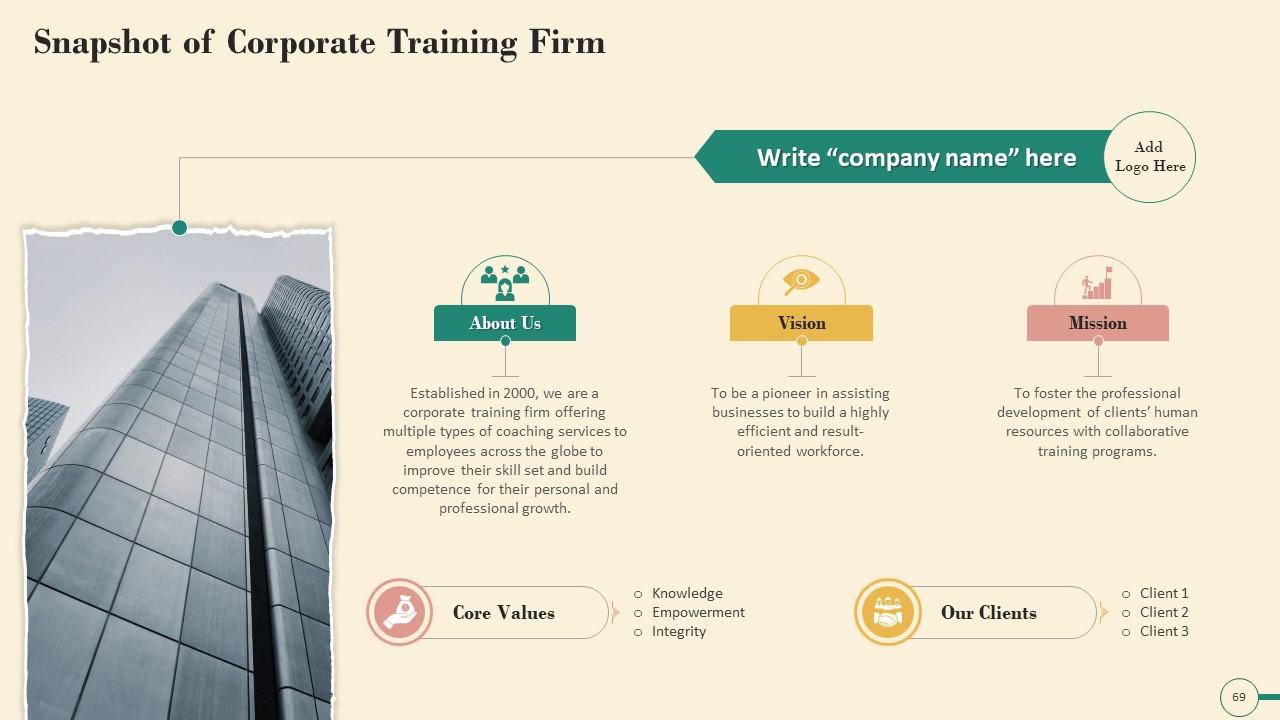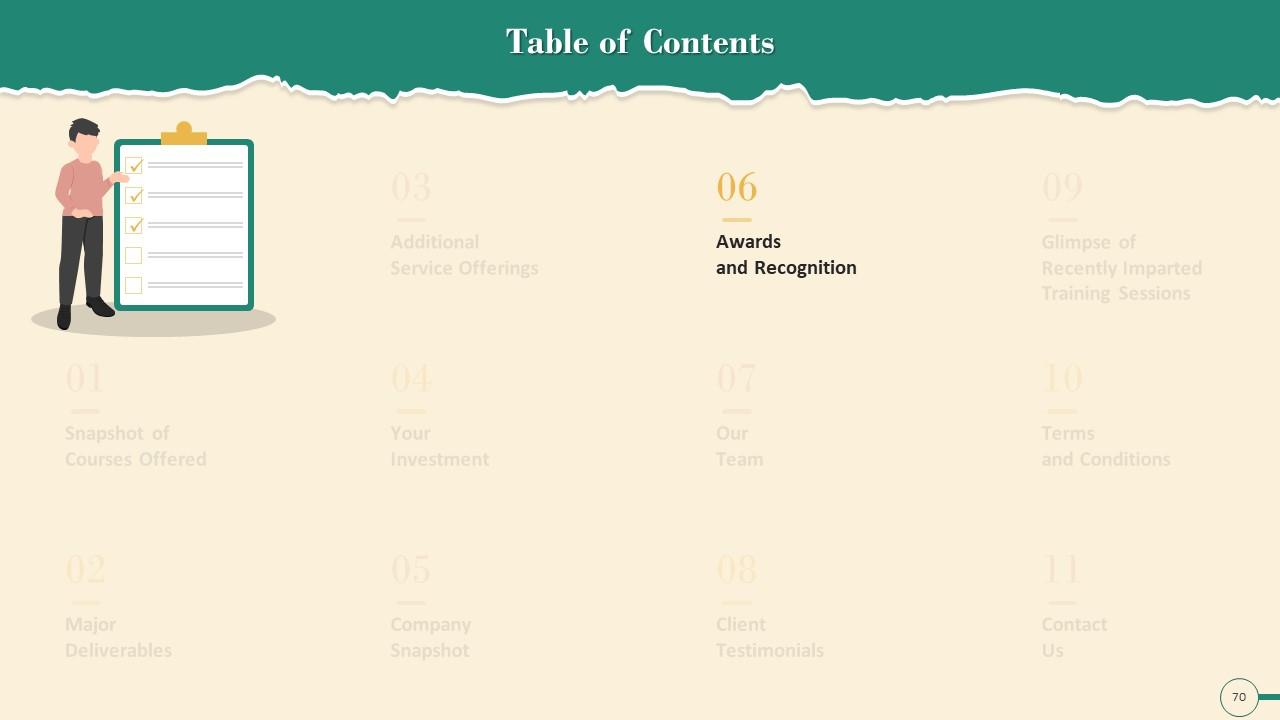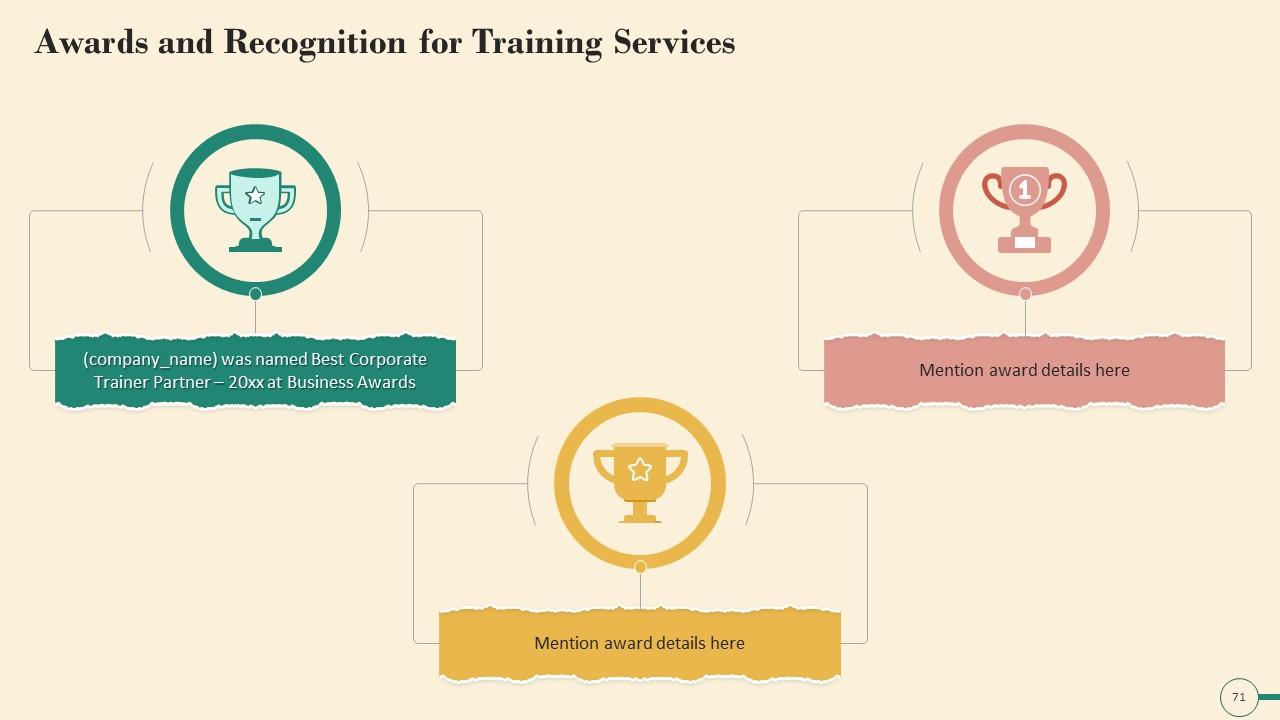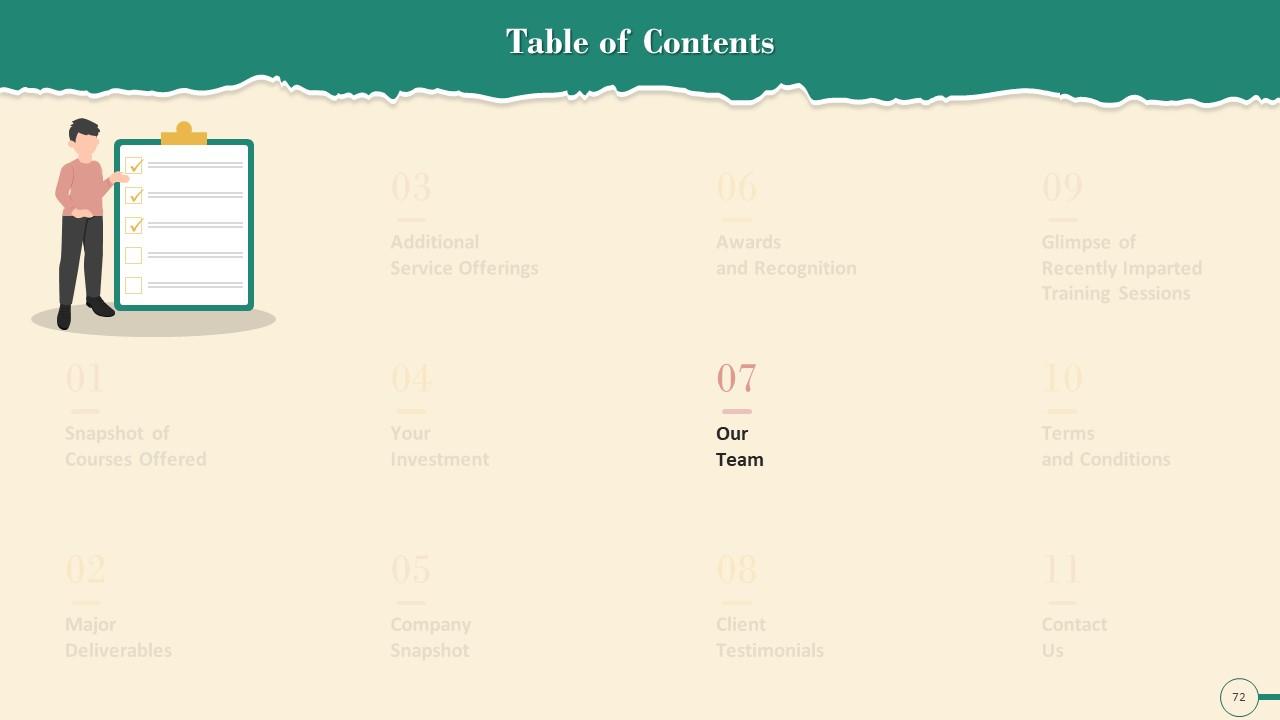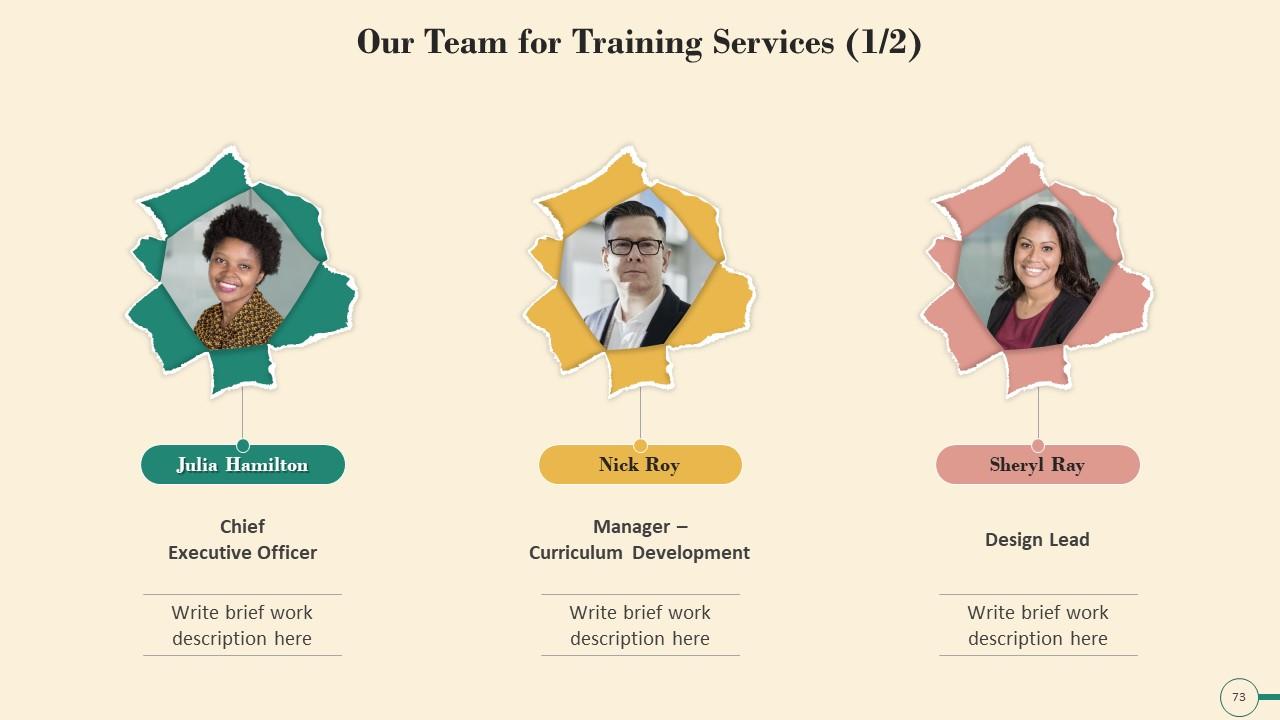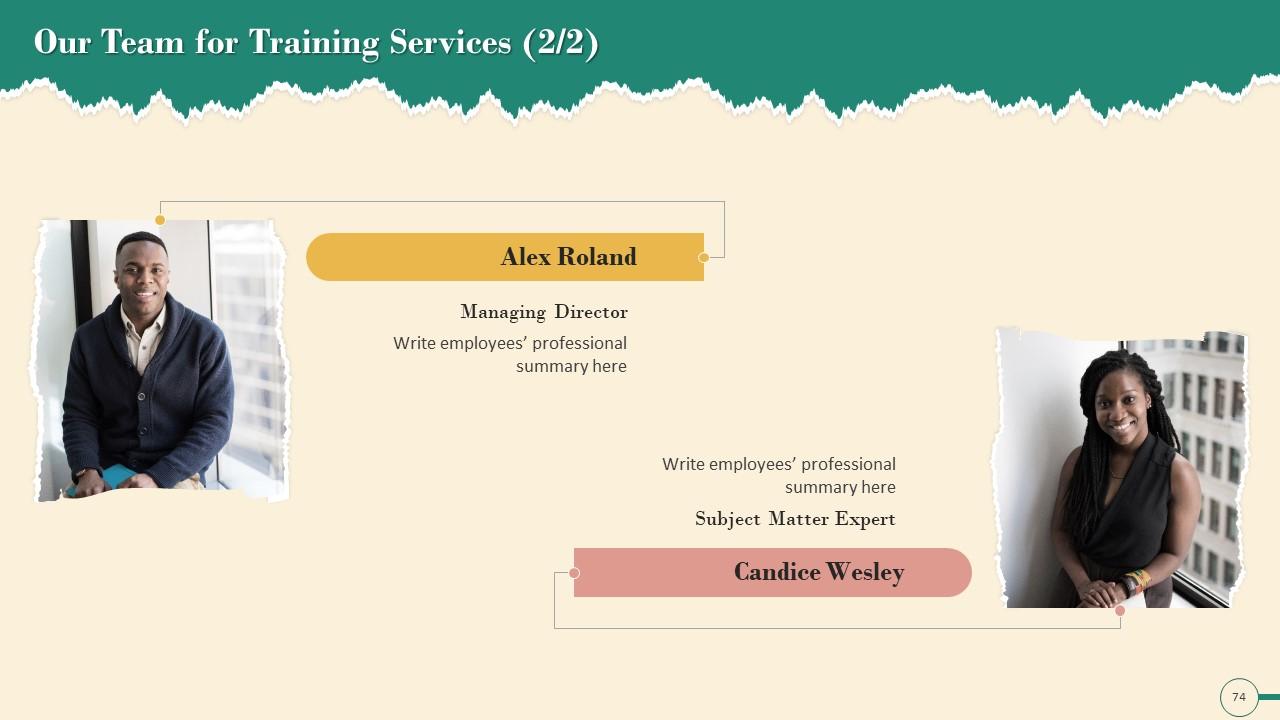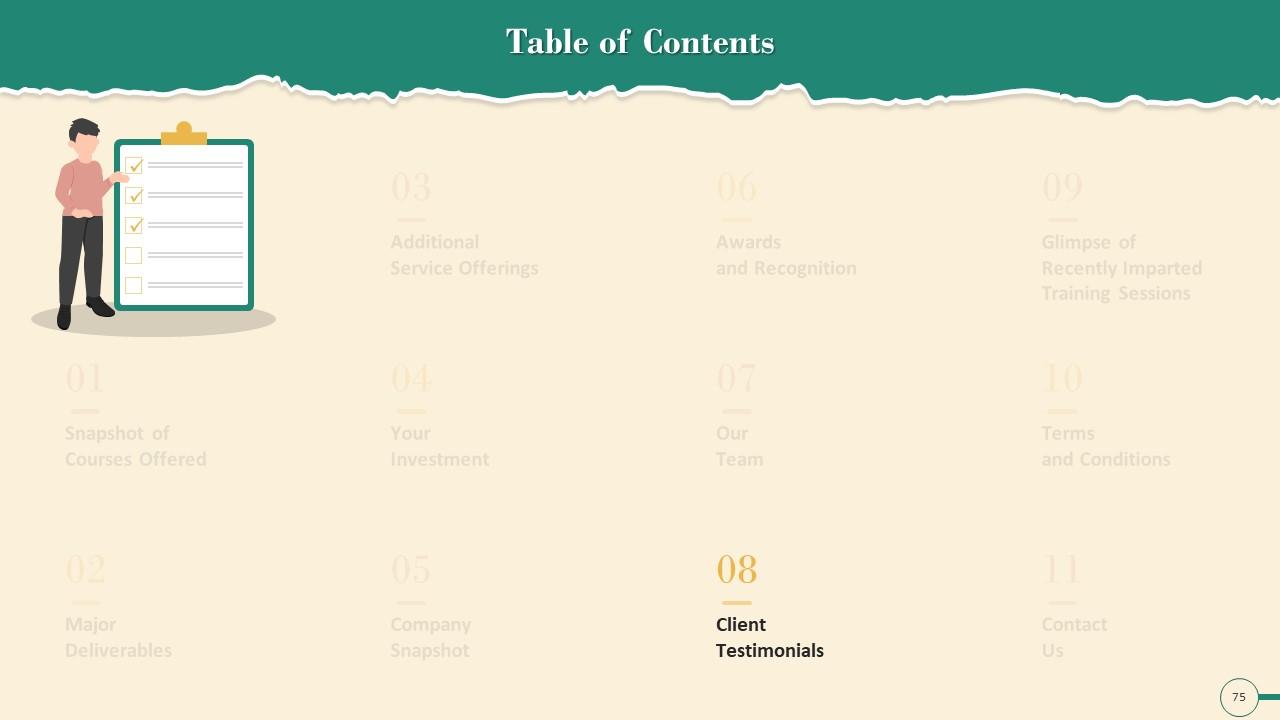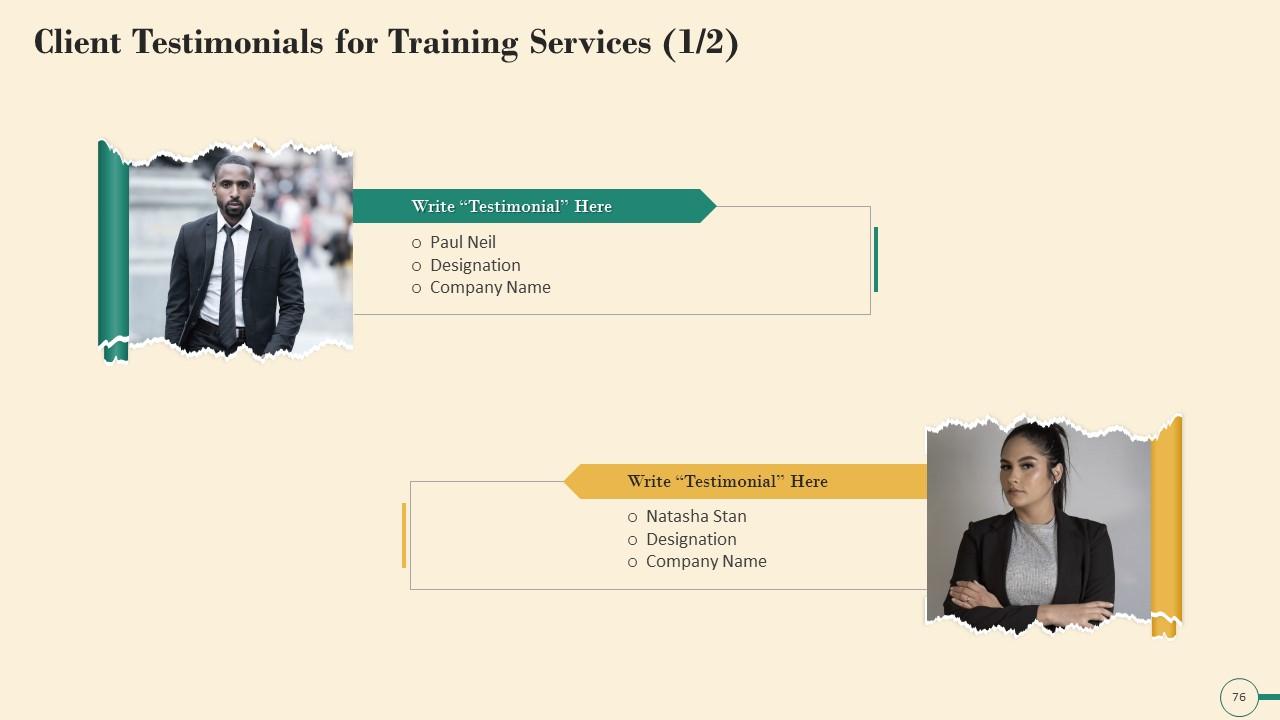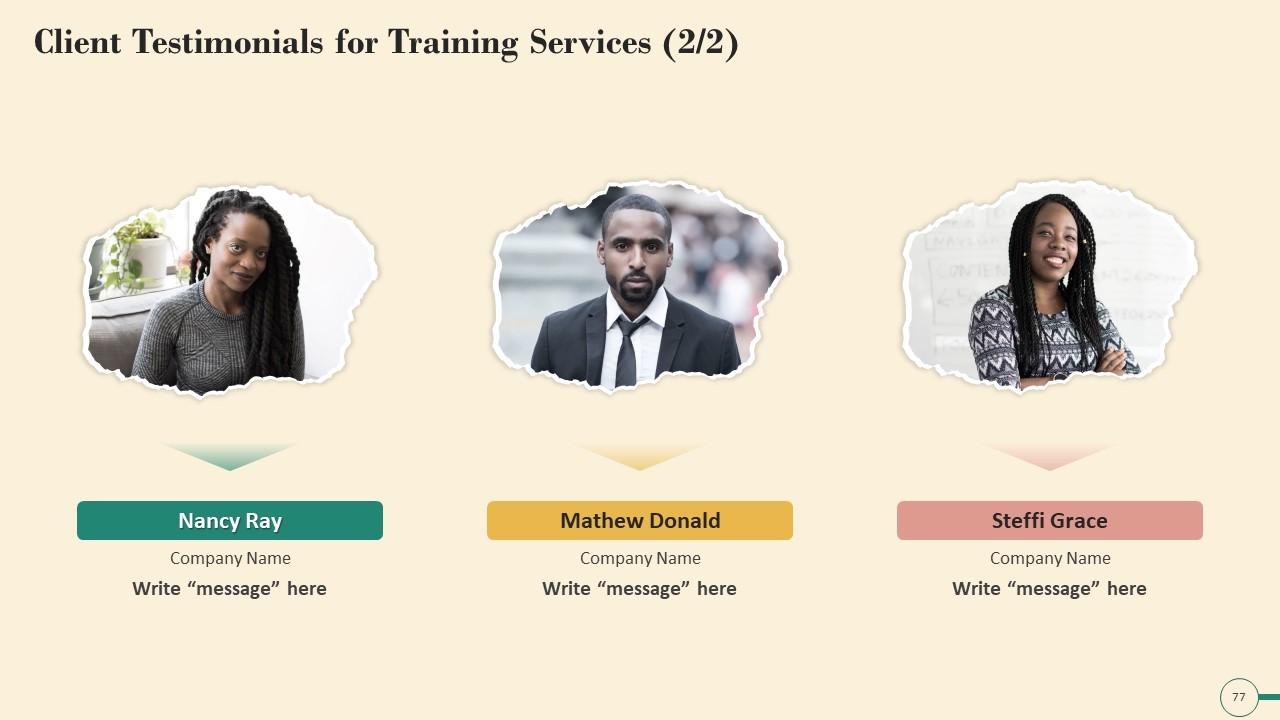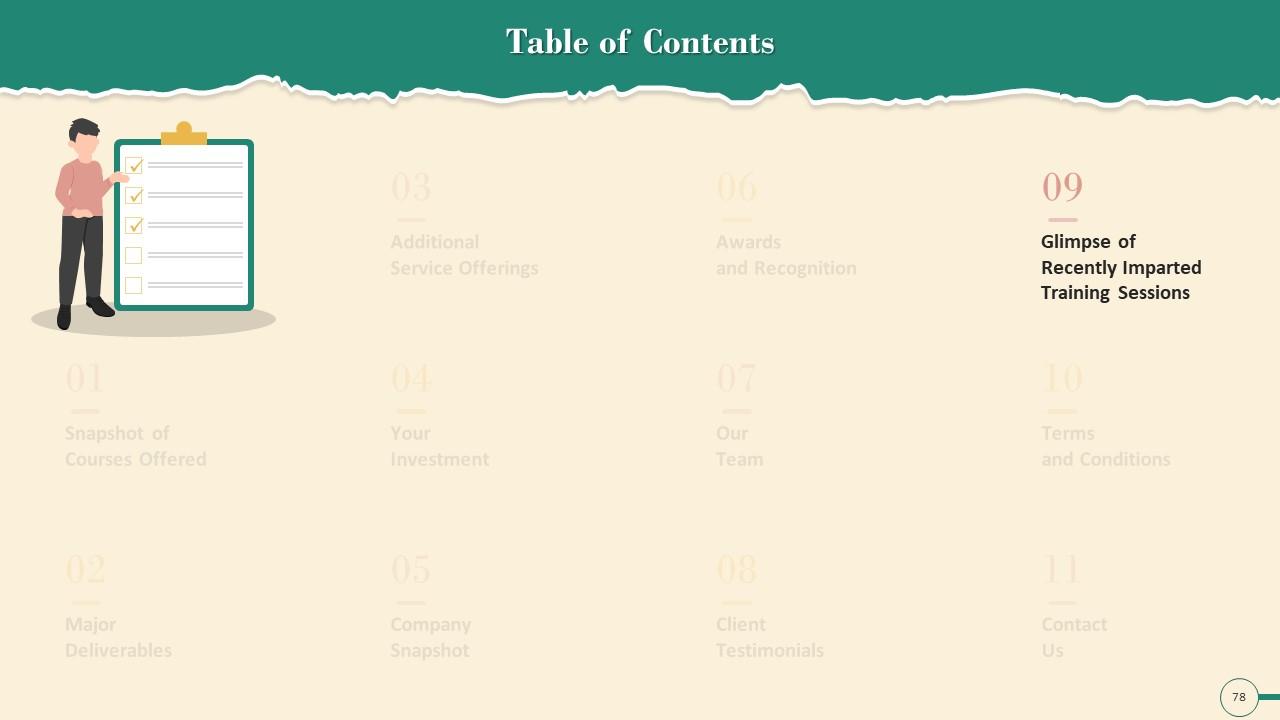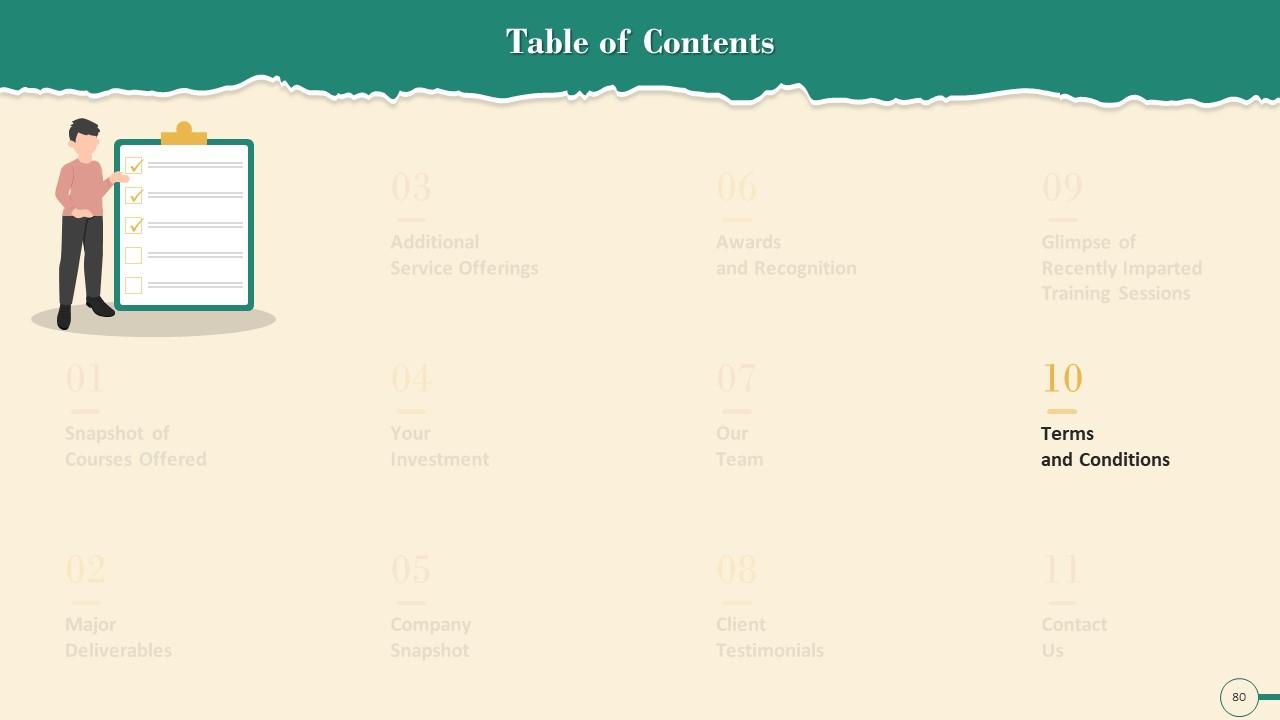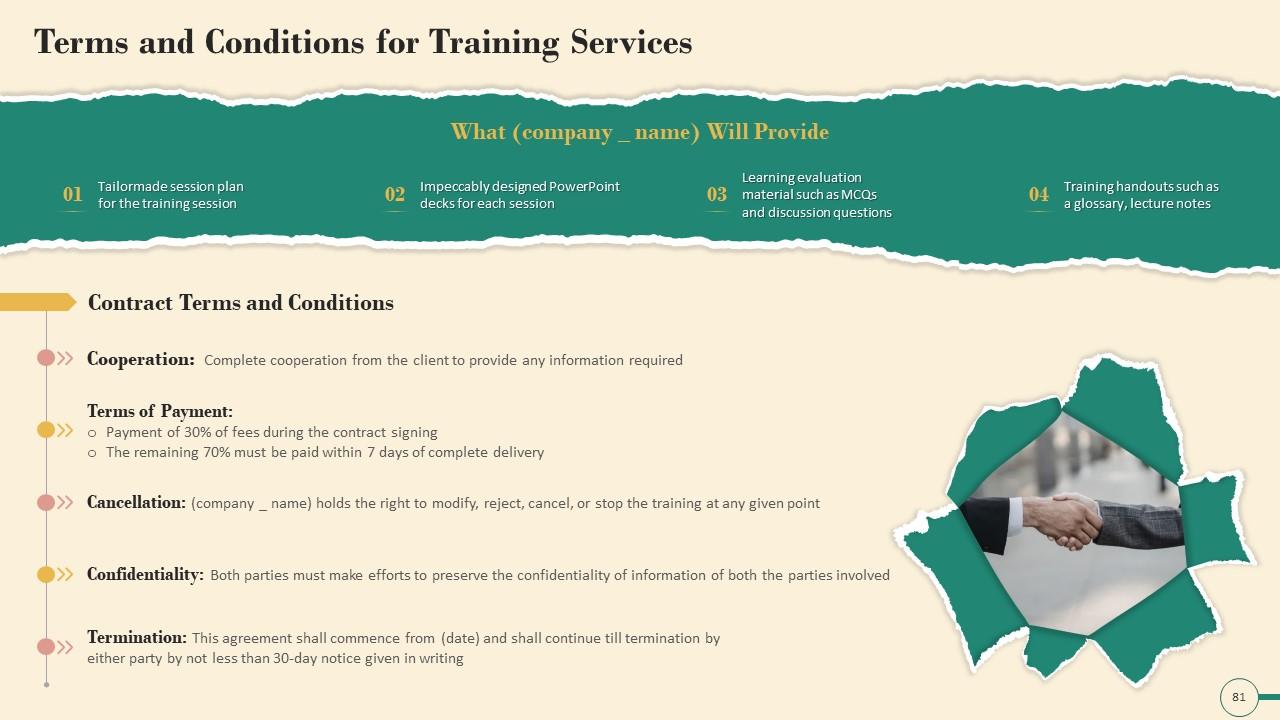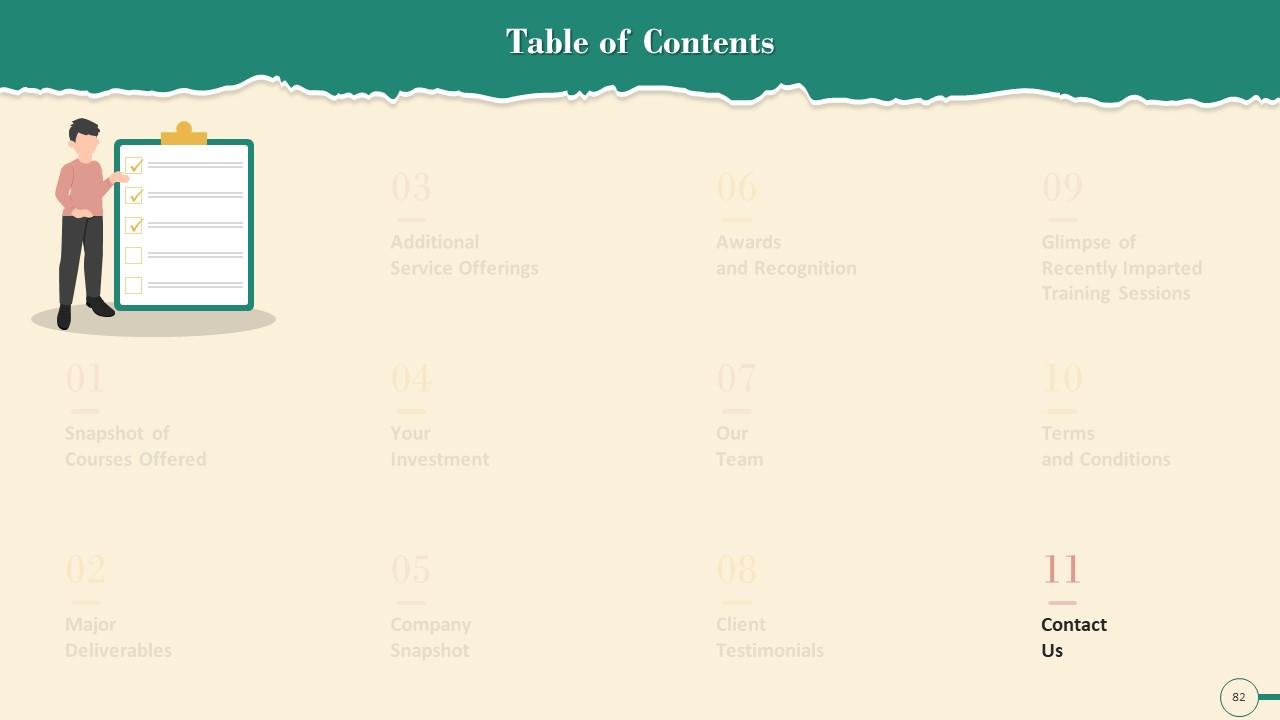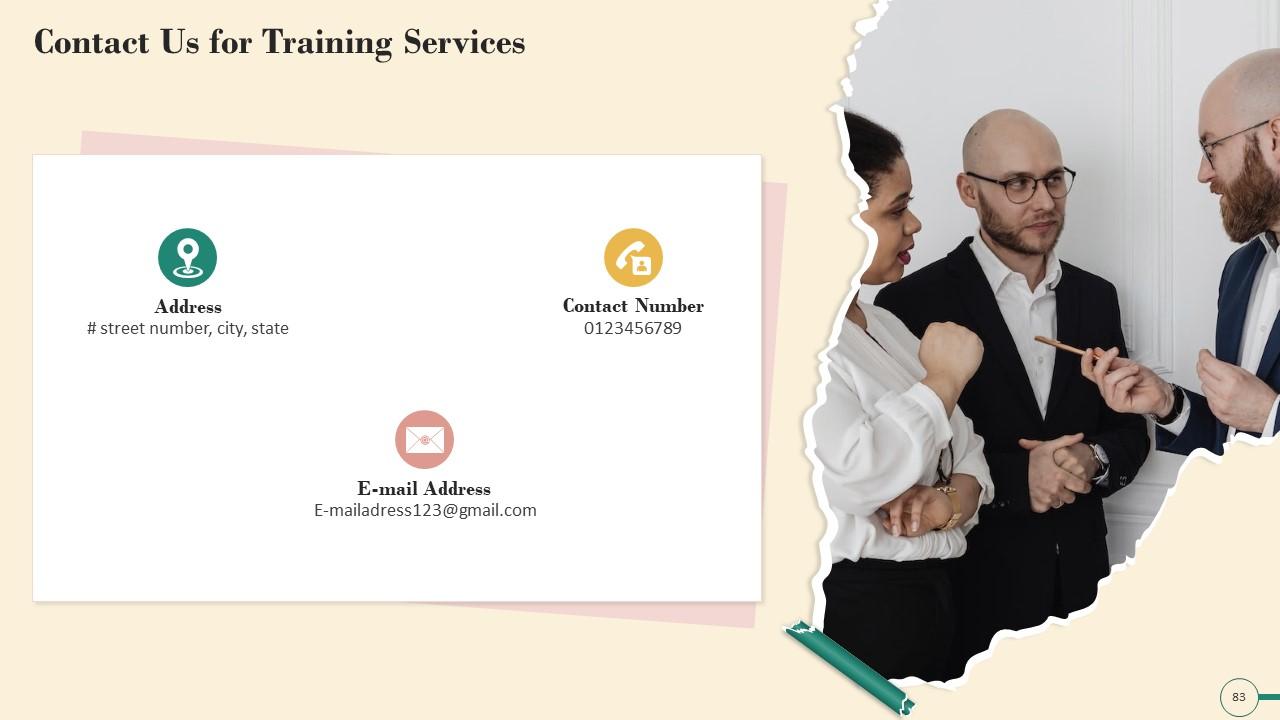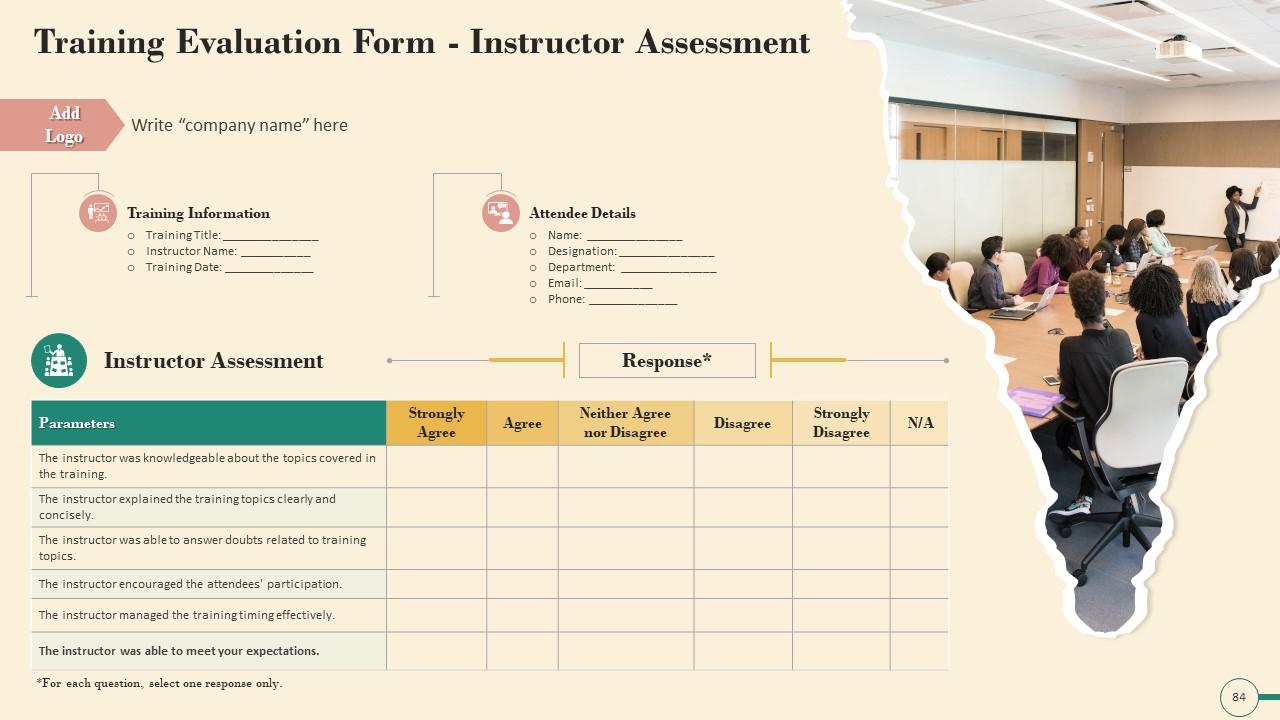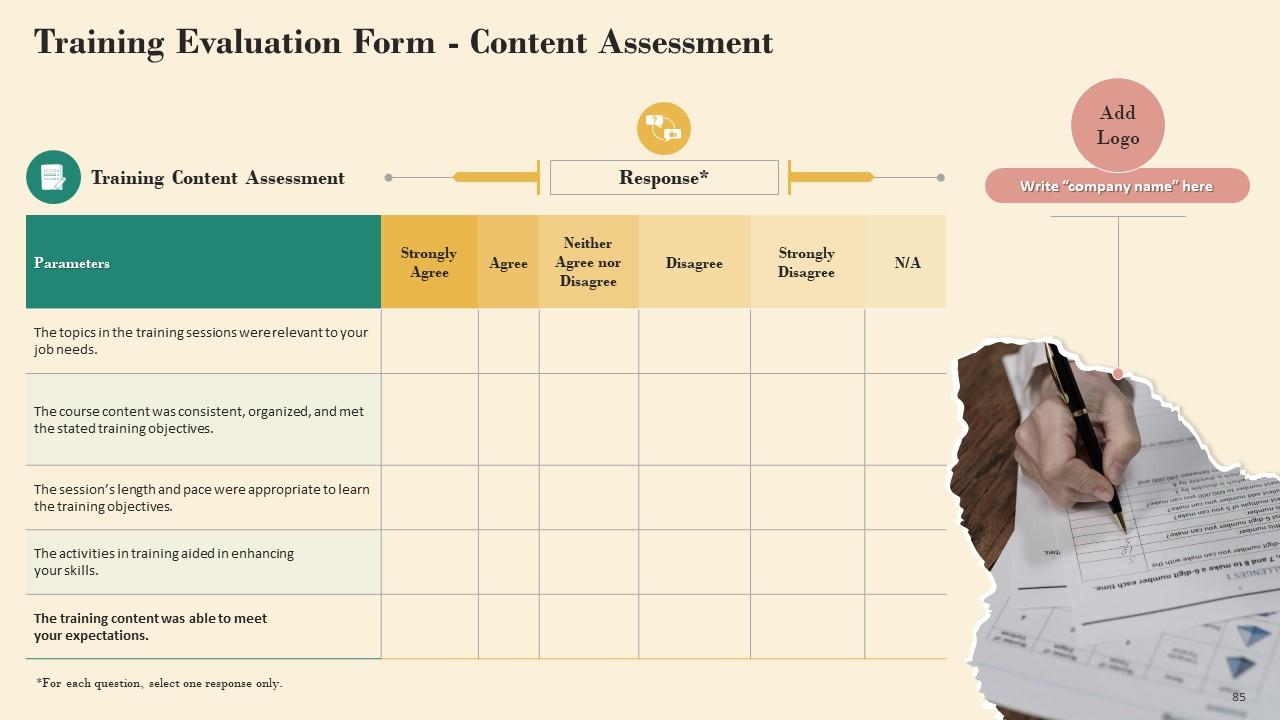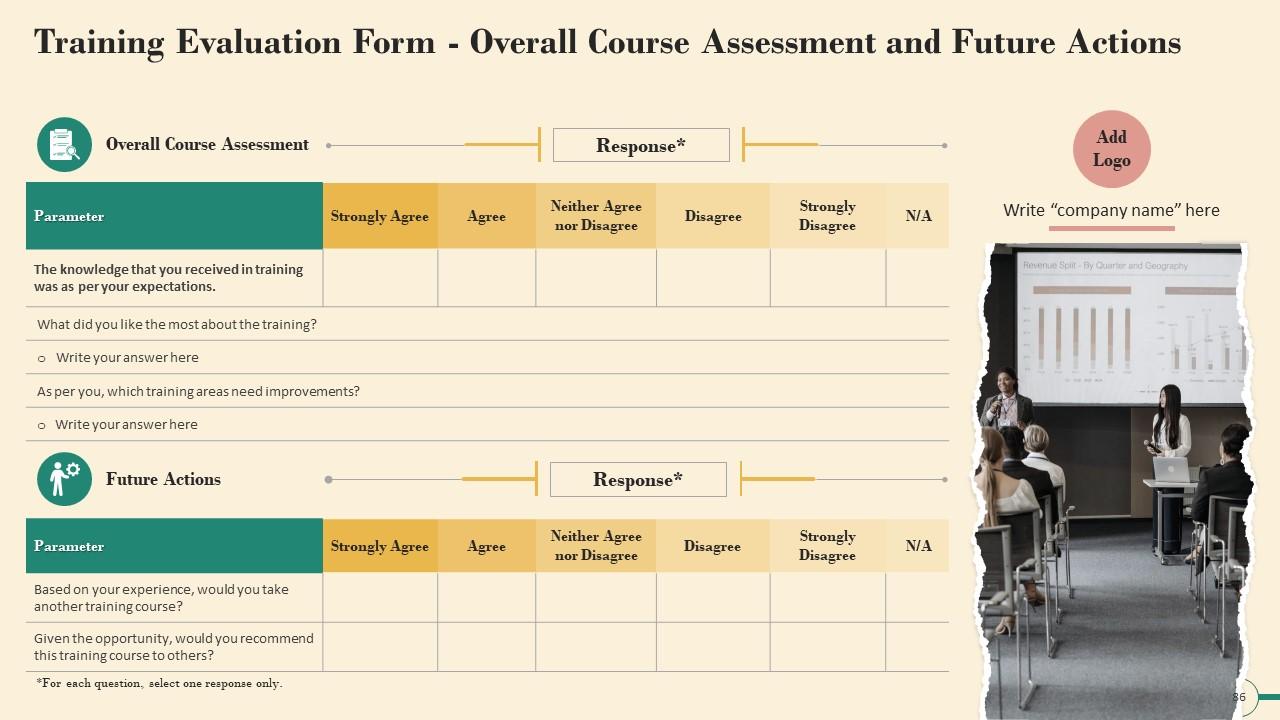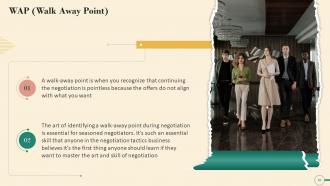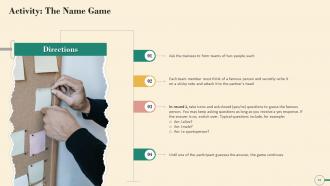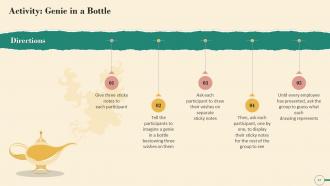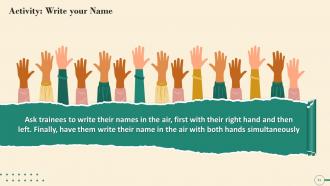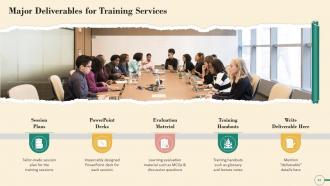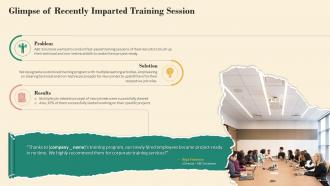A Guide To Negotiation Preparation Strategies Training Ppt
This training module A Guide to Negotiation Preparation Strategies, in-depth covers the topics BATNA Best Alternative to a Negotiation Agreement, WATNA Worst Alternative to a Negotiation Agreement, and WAP Walk Away Point. It includes a Negotiation Preparation Checklist, Sources of Negotiating Power Need, Alternatives and Options, Time and Deadline, Relationships, Investment, Credibility, Information and Knowledge, Skills, Elegant solutions, and Perception. Further, it covers Emotional Control in Negotiation, Tips for Successful Negotiation Do Your Homework, Practice Before the Negotiation, Spend Time Listening and Questioning, Find the Right Balance of Information Sharing and Withholding, Be Self-aware, Develop Persuasion Skills, and Build Trust and Respect. It also has an Exercise, Key Takeaways, and Discussion Questions related to the topic to make the coaching session more interactive. The deck has PPT slides on About Us, Vision, Mission, Goal, 30-60-90 Days Plan, Timeline, Roadmap, Training Completion Certificate, and Energizer Activities. It also includes a Client Proposal and Assessment Form for training evaluation.
This training module A Guide to Negotiation Preparation Strategies, in-depth covers the topics BATNA Best Alternative to a ..
- Google Slides is a new FREE Presentation software from Google.
- All our content is 100% compatible with Google Slides.
- Just download our designs, and upload them to Google Slides and they will work automatically.
- Amaze your audience with SlideTeam and Google Slides.
-
Want Changes to This PPT Slide? Check out our Presentation Design Services
- WideScreen Aspect ratio is becoming a very popular format. When you download this product, the downloaded ZIP will contain this product in both standard and widescreen format.
-

- Some older products that we have may only be in standard format, but they can easily be converted to widescreen.
- To do this, please open the SlideTeam product in Powerpoint, and go to
- Design ( On the top bar) -> Page Setup -> and select "On-screen Show (16:9)” in the drop down for "Slides Sized for".
- The slide or theme will change to widescreen, and all graphics will adjust automatically. You can similarly convert our content to any other desired screen aspect ratio.
Compatible With Google Slides

Get This In WideScreen
You must be logged in to download this presentation.
PowerPoint presentation slides
Presenting Training Deck on A Guide to Negotiation Preparation Strategies. This deck comprises of 86 slides. Each slide is well crafted and designed by our PowerPoint experts. This PPT presentation is thoroughly researched by the experts, and every slide consists of appropriate content. All slides are customizable. You can add or delete the content as per your need. Not just this, you can also make the required changes in the charts and graphs. Download this professionally designed business presentation, add your content and present it with confidence.
People who downloaded this PowerPoint presentation also viewed the following :
Content of this Powerpoint Presentation
Slide 4
This slide explains that BATNA (Best Alternative to a Negotiated Agreement) refers to a negotiating party's action plan if talks fail and no agreement can be reached. It also mentions that BATNAs are used when the parties involved cannot reach an agreement. If negotiations fail, the most appealing option is a BATNA.
Slide 5
This slide depicts information regarding importance of BATNA (Best Alternative to a Negotiated Agreement). The reasons why knowing your BATNA is critical are:
- If negotiations fail, it provides an alternative
- It gives you bargaining power
- It establishes your reservation point (the worst price you are willing to accept)
Slide 6
This slide illustrates each party's (seller and buyer) best alternative to a negotiated agreement.
Instructor’s Notes:
- ZOPA (Zone of Potential Agreement) is the difference between the settlement ranges of the seller and the buyer
- The seller's settlement range is a biddable range that the seller accepts
- The buyer's settlement range is a biddable range that the buyer accepts
- The worst-case scenario for the buyer/seller is the reservation point of the respective parties
- If the buyer proposes a lower price than the seller's worst-case scenario, the seller would be better off going with an alternative
- If the seller proposes a higher price than the buyer's worst-case scenario, the buyer would be better off choosing an alternative
Slide 7
The slide depicts an example in which both the buyer and seller negotiate the best possible deal.
Slide 8
This slide illustrates that both the buyer and seller can settle for a price between $16,000-$17,000 that is ZOPA (Zone of Possible Agreement).
Slide 9
This slide explains the information regarding WATNA. WATNA is an abbreviation for "Worst Alternative to A Negotiated Agreement," It represents one of several alternative options if a resolution cannot be reached. It also highlights that WATNA is a helpful technique for understanding what might be a negotiation outcome that, even if negative, is still better than a WATNA, allowing the deal to proceed.
Slide 10
This slide explains WAP (Walk-Away Point) in negotiation. It highlights that a walk-away point is when you recognize that continuing the negotiation is pointless because the offers do not align with what you want.
Slide 11
This slide explains WAP (Walk-Away Point) in negotiation. It highlights that a walk-away point is when you recognize that continuing the negotiation is pointless because the offers do not align with what you want.
Instructor’s Notes:
- The “Like to Achieve” table is where you can list the goals you want to achieve during a negotiation
- The “Intend to Achieve” table lists the goals you need to accomplish during a negotiation
- The “Breakpoint to Achieve” table lists any offer from the other party that will prevent you from achieving your goals during a negotiation
Anything under Breakpoint to Achieve is your key point in determining when you should walk away from a negotiation. When the other party mentions anything in the Breakpoint table, that should be your cue to pay attention to a possible walkaway point.
Slide 12
This slide illustrates preparation checklist with multiple open-ended questions on negotiation. The questions are: What are my short- and long-term goals related to negotiation; what are my strengths, skills, and assets in this negotiation; what are my weaknesses and vulnerabilities in this negotiation; and what do I have that the other party is negotiating with me.
Slide 13
This slide depicts a preparation checklist with multiple open-ended questions on negotiation. The questions are: What lessons can I apply from past negotiations to improve my performance; What is my best alternative to a negotiated agreement? What options would I turn to if I’m not ok with the deal? How can I strengthen my BATNA? What is my relationship history with the other party? How might our relationship affect current talks? Finally, have I practiced communicating my message to the other side? How are they likely to respond?
Slide 14
This slide explains the sources of negotiating power. The sources are: Need, Alternatives/Options, Time/Deadline, Relationships, Investment, Credibility, Information/Knowledge, Skills, Elegant solutions, and Perception.
Instructor’s Notes:
Multiple Sources of Negotiating Power are:
- Need: The critical question here is which side needs the product/service more, one side or the other
- Alternatives/Options: What are each party's options if an agreement cannot be reached? The greater your BATNA – best alternative to a negotiated agreement, the greater your bargaining power
- Time/Deadline: It refers to any upcoming events that impose a deadline on either negotiating party. It can also refer to waiting for the right moment for initiating negotiations
- Relationships: Relationship power exists when negotiators have high-quality relationships with the opposing party
- Investment: The more efforts or resources individuals invest, the more committed they are to reaching an agreement, giving the opposing party more power
- Credibility: Material proof of your previous successful work and having large and important parties among your partners increase your negotiating power
- Information/Knowledge: Power comes from knowledge. The more an individual knows about the other party, the more bargaining power they will have. It implies a thorough understanding of the other party's culture in international negotiations
- Skills: Among these are the ability to listen to others, empathy, sensitivity to others, clear communication, foreign language proficiency, etc. Negotiating skills can be ingrained, both formally and through experience
- Elegant solutions: There are many shared and competing interests in any negotiation. Finding a good solution to the problem is one way to influence the other side. The more complex the issue, the more powerful and elegant the solution can be
- Perception: The more power the other party believes you have, the more power you have
Slide 16
This slide explains how our emotions affect our ability to negotiate. It emphasizes the importance of shifting the focus during negotiations from what is going on in your mind to what is going in your interlocutor's mind. It also states that one must be cheerful, optimistic, calm, and confident during negotiation. Accept your client's right to an alternative viewpoint and treat him as an ally rather than an adversary.
Slide 17
This slide depicts the tips through which an individual can have emotional control during negotiation. The recommendations are: Differentiate between relations and business, Prepare yourself and write things down, Always be ready for manipulations, and be ready for tough negotiations.
Slide 18
This slide depicts tips for successful negotiation. These tips are: Do Your Homework, Practice Before the Negotiation, Spend time listening and questioning, Find the Right Balance of Information Sharing and Withholding, Be self-aware, Develop Your Persuasion Skills, and Build Trust and Respect.
Slide 19
This slide explains the importance of doing your homework as a negotiation tip. It emphasizes recognizing what is essential to the other negotiating party and what you can offer that they will value. It is much easier to negotiate from a position of knowledge than to negotiate from a position of guesswork.
Slide 20
This slide depicts practicing as a tip for successful negotiation. It emphasizes the importance of planning and preparing for potential objections before entering into a negotiation. Rehearse in front of a mirror before the meeting so you don't hear your own words for the first time.
Slide 21
This slide explains the importance of spending time on listening and questioning as a tip for successful negotiation. It emphasizes that if one needs more information from the other party during a negotiation, one should stop talking and start listening. It also mentions that critical thinking frequently leads to effective questioning, so remaining silent and active listening will undoubtedly help you obtain information.
Slide 22
This slide depicts finding the right balance of information sharing and withholding as a tip for successful negotiation. It emphasizes how unnerving it can be to share details with a negotiating counterpart. It can force your counterpart into a position at the negotiating table that you did not intend. It also states that while sharing information can add value to a negotiation, sharing too much can harm your bargaining position.
Slide 23
This slide explains being self-aware as a tip for successful negotiation. It mentions that people from different cultures may approach negotiation in their unique ways. Some cultures take a process-focused linear approach with little small talk, while others are warmer and more emotional.
Slide 24
This slide depicts developing your persuasion skills as a tip for successful negotiation. It mentions that persuasion is an important skill to learn if you want to negotiate successfully. It also emphasizes the importance of being able to persuade others to accept your point of view and convincing them to change their minds.
Slide 25
This slide explains building trust and respect as a tip for successful negotiation. It mentions that developing long-term business relationships requires trust and respect, as well as overcoming cognitive biases. These include blaming others for circumstances beyond their control (accuser bias) and focusing on variables outside your control to explain your behavior while ignoring variables within your control (excuser bias).
Slide 26
This slide depicts an exercise on negotiation that can be performed during the training session.
Slide 40 to 55
These slides contain energizer activities to engage the audience of the training session.
Slide 56 to 83
These slides contain a training proposal covering what the company providing corporate training can accomplish for the client.
Slide 84 to 86
These slides include a training evaluation form for instructor, content and course assessment.
A Guide To Negotiation Preparation Strategies Training Ppt with all 91 slides:
Use our A Guide To Negotiation Preparation Strategies Training Ppt to effectively help you save your valuable time. They are readymade to fit into any presentation structure.
-
Happy to incorporate such stunning templates in my presentation. Made my presentation look professional and engaging.
-
Extensive range of templates! Highly impressed with the quality of the designs.


